Sony Sony Bravia 85" X85K User Manual
Displayed below is the user manual for Sony Bravia 85" X85K by Sony which is a product in the TVs category. This manual has pages.
Related Manuals

Television
Getting Started [1]
Remote control [2]
Upper buttons on the remote control [3]
Lower buttons on the remote control [4]
Upper buttons on the remote control [5]
Middle buttons on the remote control [6]
Lower buttons on the remote control [7]
Upper buttons on the remote control [8]
Middle buttons on the remote control [9]
Lower buttons on the remote control [10]
Connecting terminal [11]
How the LEDs light up [12]
Home menu [13]
Selecting inputs [14]
Performing acoustic auto calibration [15]
Accessibility features [16]
Useful features [17]
Searching for content/operating the TV with your voice [18]
Using the remote control microphone [19]
Using the built-in MIC on the TV (only TVs with a built-in MIC) [20]
Enjoying preferred apps [21]
Installing apps [22]
Finding the remote control (only models supplied with a buzzer built-in remote
control) [23]
Enjoying safe apps and video streaming services (Security and restrictions)
[24]
Enjoying the Camera and Microphone Unit [25]
Watching TV [26]
Watching TV programmes [27]
Understanding the information banner icons [28]
Using the programme guide [29]
Configuring channel settings [30]
Receiving digital broadcasts [31]
Receiving satellite broadcasts [32]
Sorting or editing the channels [33]
Using the TV menu [34]
Using interactive broadcast TV services [35]
Useful features when watching TV [36]
Changing the picture and sound quality to your preferences [37]
Adjusting the picture quality [38]
Adjusting the sound quality [39]
“Sound” advanced settings [40]
Recording TV Programmes [41]
Recording to a USB HDD device [42]
Registering a USB HDD device [43]
Timer recording [44]
Information about using a USB HDD device for recording [45]
Watching/deleting recorded content [46]

Understanding the symbols displayed in the recorded title list [47]
Using the TV with Other Devices [48]
USB devices [49]
Playing content stored on a USB device [50]
Information about USB devices used for storing photos and music [51]
Supported files and formats [52]
Photos [53]
Music [54]
Videos [55]
Audio sampling rates (for videos) [56]
External subtitles [57]
Blu-ray and DVD players [58]
Connecting a Blu-ray or DVD player [59]
Watching Blu-ray and DVD discs [60]
TV box [61]
Connecting a TV box [62]
How to control the TV box using the TV remote control [63]
Displaying the iPhone/smartphone or iPad/tablet app screen on the TV [64]
Computers, cameras, and camcorders [65]
Connecting a computer and viewing stored content [66]
Connecting a camera or camcorder and viewing stored content [67]
Computer video signal specifications [68]
Audio system (such as an AV receiver or sound bar) [69]
Outputting audio from an audio system [70]
Connecting an audio system [71]
Adjusting an audio system [72]
Using the TV as a centre speaker (only models with TV centre speaker mode) [73]
Pass-through audio formats supported with eARC [74]
Video game consoles [75]
Experiencing 3D surround with a neckband speaker or headphones (BRAVIA
XR models only) [76]
Bluetooth devices [77]
Connecting a Bluetooth device [78]
Adjusting the AV sync setting [79]
Supported Bluetooth profiles [80]
BRAVIA Sync-compatible devices [81]
BRAVIA Sync overview [82]
Using features available for BRAVIA Sync-compatible devices [83]
Adjusting BRAVIA Sync settings [84]
Viewing pictures in 4K from compatible devices [85]
Viewing pictures in 4K resolution [86]
Settings for viewing pictures through HDMI input with higher quality [87]
BRAVIA Connectivity Guide [88]
Connecting to a Network [89]
Connecting to a network [90]
Connecting to a network using a LAN cable [91]
Connecting to a network using a wireless connection [92]
Using Wi-Fi to connect the TV to the Internet/Network [93]
Using Wi-Fi Direct to connect to the TV (no wireless router required) [94]
Home network features [95]
Adjusting home network settings [96]
Playing content from a computer [97]
Playing content from a media server [98]
Viewing Internet content [99]

Settings [100]
Using the Quick Settings [101]
Channels & Inputs [102]
Display & Sound [103]
Network & Internet [104]
Accounts & Sign-In [105]
Privacy [106]
Apps [107]
System [108]
Remotes & Accessories [109]
Help & feedback [110]
Timers & Clock [111]
Troubleshooting [112]
Start here [113]
Self diagnostics [114]
Software updates [115]
If a full reset (restart) of the TV is required [116]
Frequently Asked Questions for Troubleshooting [117]
Picture (quality)/screen [118]
No colour/Dark picture/Colour is not correct/Picture is too bright. [119]
Distorted picture./The screen flickers. [120]
High resolution HDR pictures are not displayed. [121]
OLED panel (only models equipped with an OLED panel) [122]
The screen becomes darker after a certain period of time. (only models equipped with an
OLED panel) [123]
The message [Panel refresh did not finish] is displayed. (only models equipped with an
OLED panel) [124]
You are concerned about an image retention. (only models equipped with an OLED panel)
[125]
A white line, or a red, green, or blue line appears on the screen. (only some models
equipped with an OLED panel) [126]
Keyboard [127]
Broadcast reception [128]
Check these things first to troubleshoot your TV reception. [129]
You cannot view digital channels. [130]
You cannot view satellite channels. [131]
Some digital channels are missing. [132]
Sound [133]
No sound but good picture. [134]
No audio or low audio with a home theatre system. [135]
You want to output sound from the headphones/Bluetooth audio device and audio
system/TV speakers at the same time. [136]
You are concerned about a delay between the picture and sound. [137]
No TV sounds such as operation sound or audio response. [138]
You cannot establish an eARC connection. [139]
You cannot use voice search with the built-in MIC (only TVs with a built-in MIC). [140]
The TV responds to sound from the surroundings (only TVs with a built-in MIC). [141]
Network (Internet/home)/apps [142]
The TV cannot connect to the Internet/Network. [143]
You can connect to the Internet, but not to certain apps and services. [144]
Remote control/accessories [145]
The remote control does not operate. [146]
You want to disable the remote control backlight. (only remote controls that feature
backlight) [147]
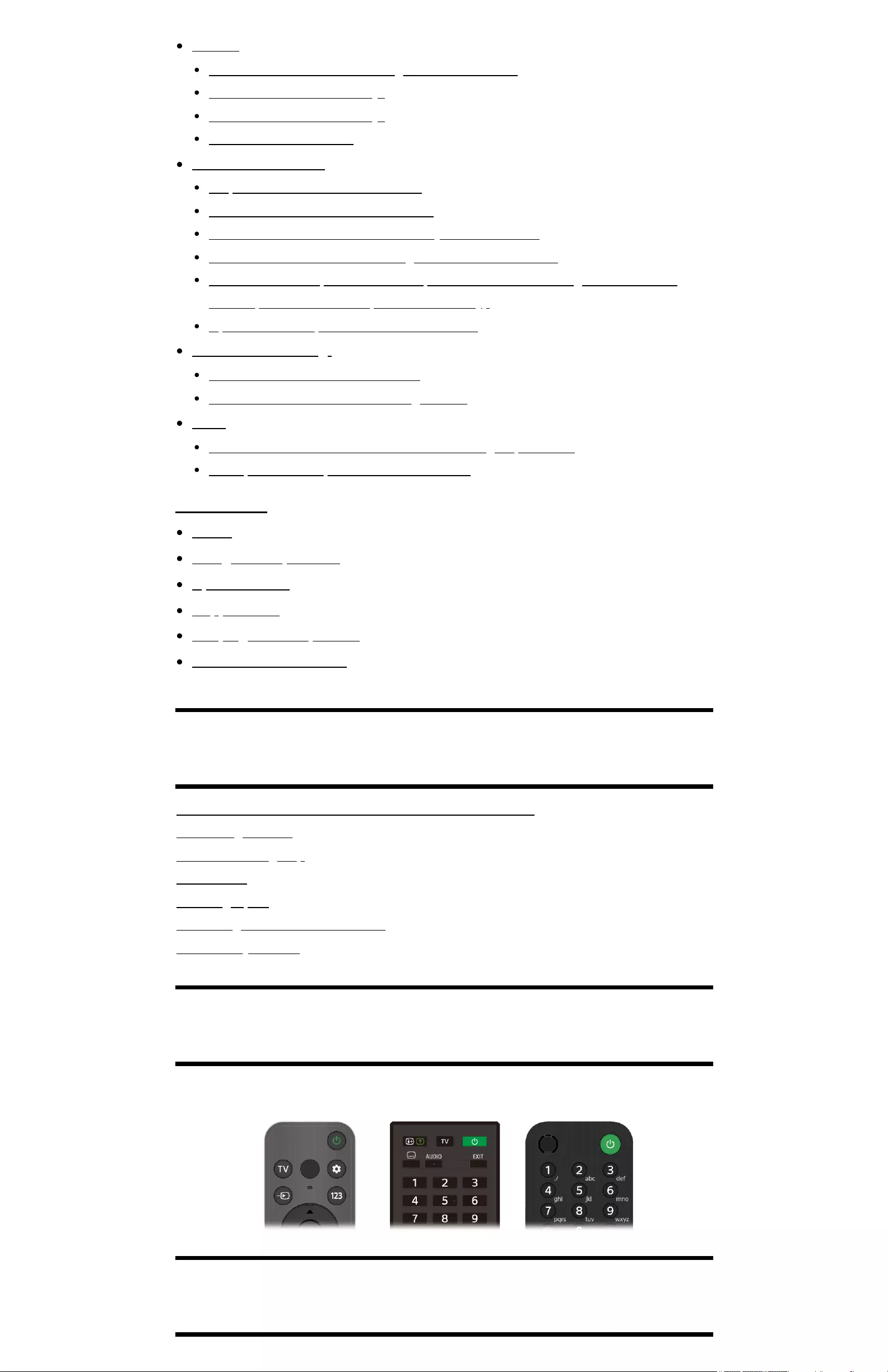
Power [148]
The TV cannot be turned off using the remote control. [149]
The TV turns off automatically. [150]
The TV turns on automatically. [151]
The TV does not turn on. [152]
Connected devices [153]
No picture from a connected device. [154]
You cannot select a connected device. [155]
You cannot find a connected BRAVIA Sync HDMI device. [156]
You cannot turn off the TV box using the TV's remote control. [157]
An external device (such as a TV box) cannot be controlled using the TV's remote
control. (TV box control compatible models only) [158]
Operation cuts out, or a device does not work. [159]
USB HDD recording [160]
You cannot use a USB HDD device. [161]
The USB HDD device cannot be registered. [162]
LED [163]
You want to disable the LED so that it does not light up or blink. [164]
The Operational response LED blinks in red. [165]
Index/Other [166]
Index [167]
Using the Help Guide [168]
Specifications [169]
Support Site [170]
Keeping the TV updated [171]
Trademark information [172]
[1]
Getting Started
Remote control This section describes remote control buttons.
Connecting terminal
How the LEDs light up
Home menu
Selecting inputs
Performing acoustic auto calibration
Accessibility features
[2] Getting Started
Remote control
Please select your remote control.
[3] Remote control | Remote control
Upper buttons on the remote control
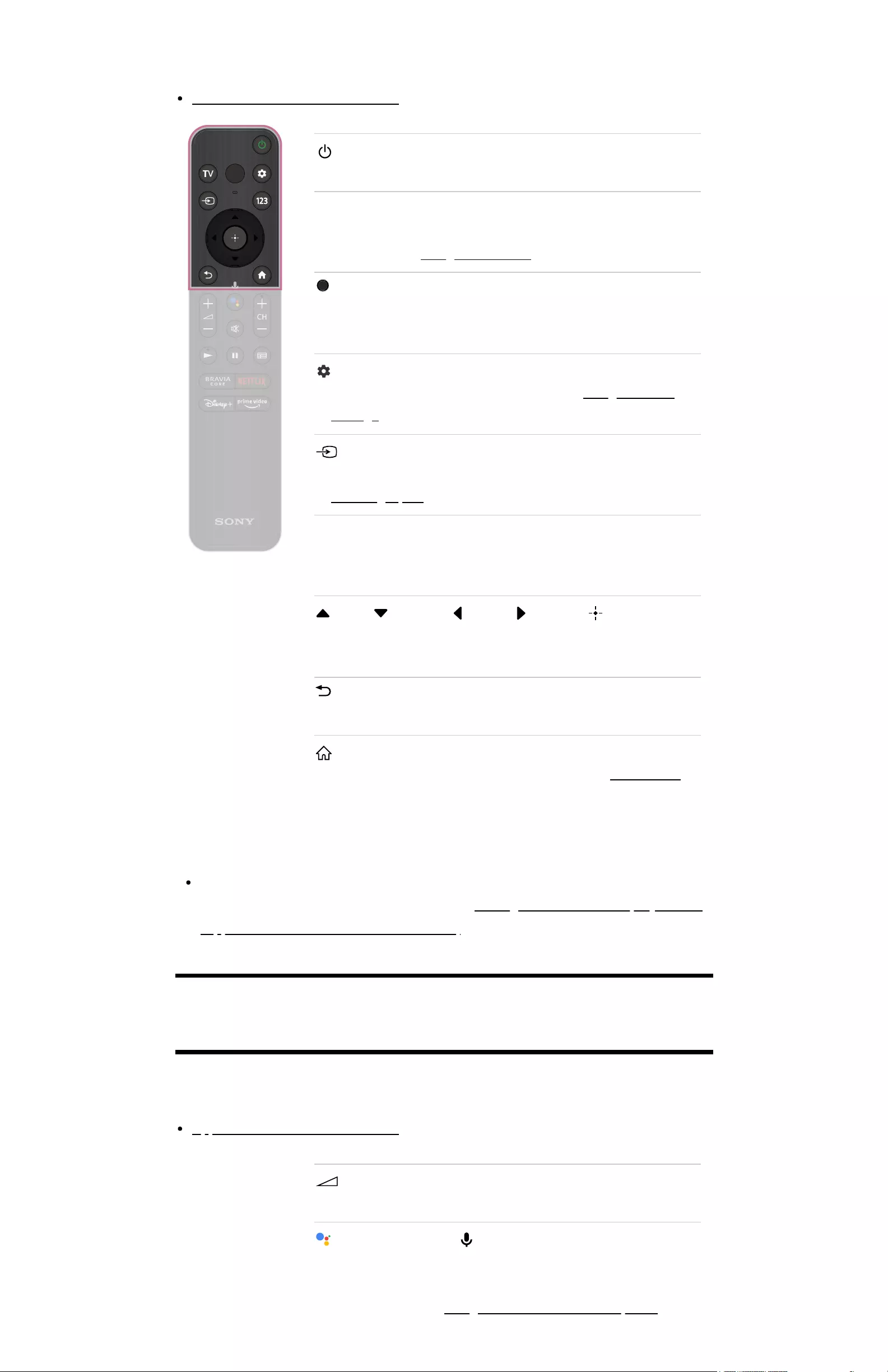
The supplied remote control, button layout, button names and available features vary
depending on your model/country/region.
Lower buttons on the remote control
(Power)
Turns on or switches to standby/networked standby mode.
TV
Switch to a TV channel or input and display the TV menu. For
details, refer to Using the TV menu page.
(MIC)
Speak into here to use the microphone in the remote control.
There is an LED above the microphone.
(Quick Settings)
Display Quick Settings. For details, refer to Using the Quick
Settings page.
(Input select)
Display and select the input source, etc. For details, refer to
Selecting inputs page.
123 (Control menu)
Display a menu on the TV to use button functions that are not on
the remote control on the screen.
(Up) / (Down) / (Left) / (Right) / (Enter)
(Navigation D-Pad)
On screen menu navigation and selection.
(BACK)
Return to the previous screen.
(HOME)
Display the TV Home Menu. For details, refer to Home menu
page.
Hint
You can use the convenient [Find remote] feature to find the remote control by pressing
the power button on the TV. For details, refer to Finding the remote control (only models
supplied with a buzzer built-in remote control).
[4] Remote control | Remote control
Lower buttons on the remote control
The supplied remote control, button layout, button names and available features vary
depending on your model/country/region.
Upper buttons on the remote control
+/- (Volume)
Adjust the volume.
(Google Assistant)/ (Microphone)
Ask Google for a little help on the big screen. Press the Google
Assistant (or MIC) button on the remote to get started.
For details, refer to Using the remote control microphone page.
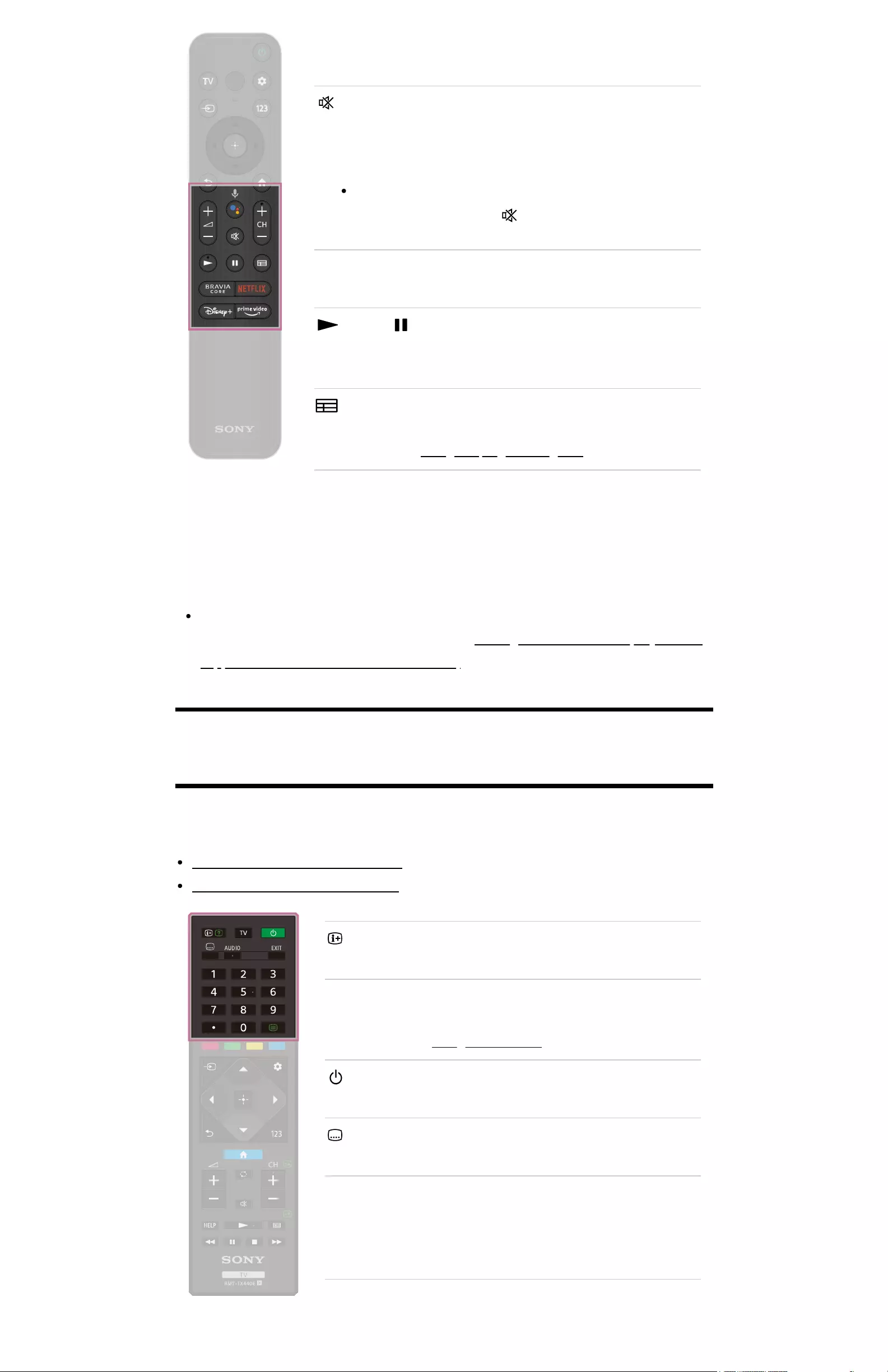
Google Assistant is not available in certain
languages/countries/regions.
(Mute)
Mute the sound. Press again to restore the sound.
Hint
The accessibility shortcut service can be turned on or off
by pressing and holding (Mute).
CH +/- (Channel)
Select the channel.
(Play) / (Pause)
Operate media contents on the TV and connected BRAVIA
Sync-compatible device.
(Guide)
Display the digital programme guide of the TV or TV box. For
details, refer to Using the programme guide page.
App buttons (Online service)
Enjoy various video streaming services with one push. Press to
watch your desired service.
Hint
You can use the convenient [Find remote] feature to find the remote control by pressing
the power button on the TV. For details, refer to Finding the remote control (only models
supplied with a buzzer built-in remote control).
[5] Remote control | Remote control
Upper buttons on the remote control
The included remote control, as well as the layout of the buttons and the button names, vary
depending on your model/country/region.
Middle buttons on the remote control
Lower buttons on the remote control
(Info/Text reveal)
Display information.
TV
Switch to a TV channel or input and display the TV menu. For
details, refer to Using the TV menu page.
(Power)
Turns on or switches to standby/networked standby mode.
(Subtitle setting)
Turn subtitles on or off (when the feature is available).
AUDIO
Select multilingual source sound or dual sound for the
programme currently being viewed (depending on programme
source).
EXIT
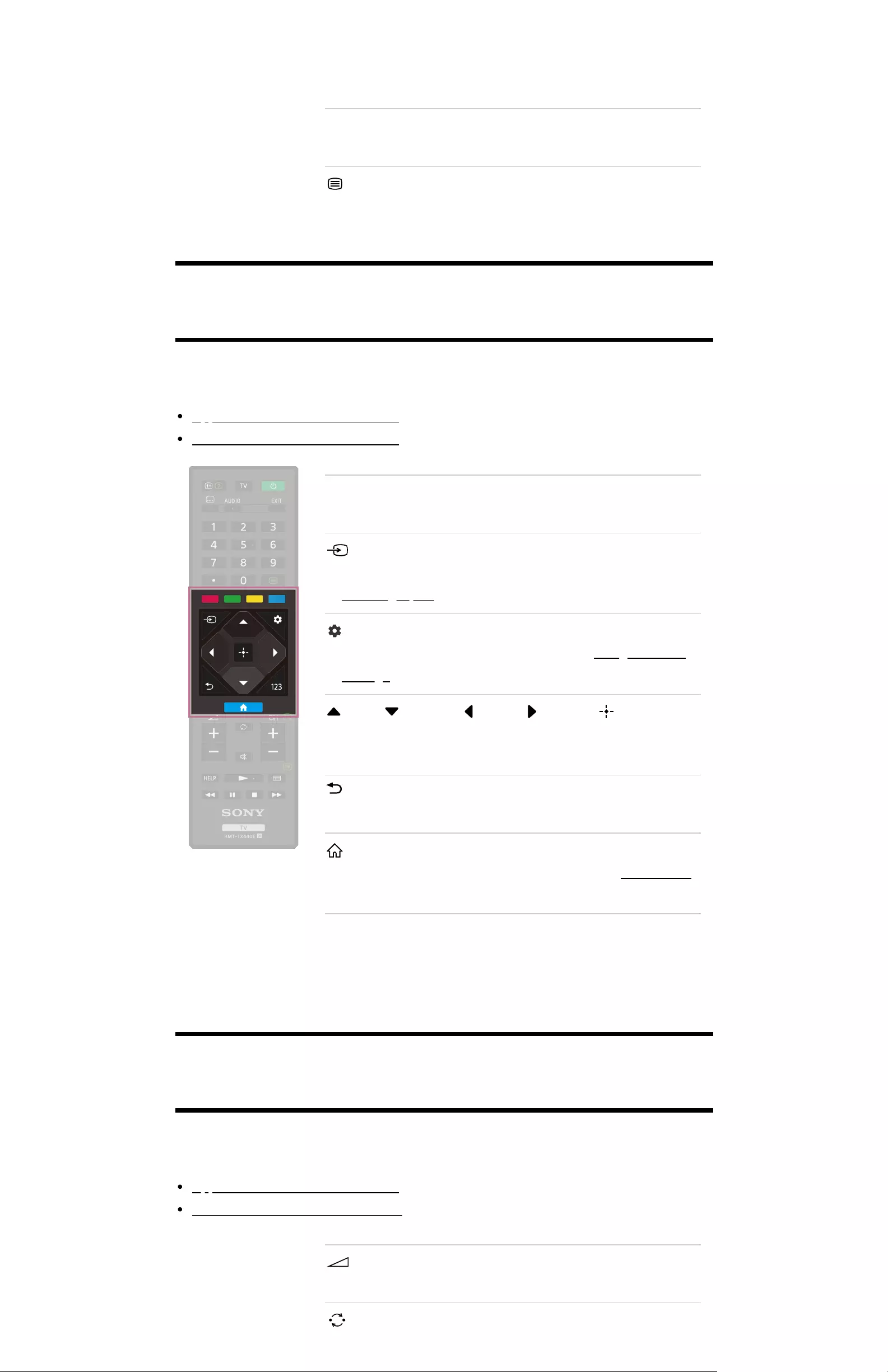
Return to the previous screen or exit from the menu. When an
Interactive Application service is available, press to exit from
the service.
Number Button/・(Dot)
Use with the 0-9 buttons to select digital channels.
(Text)
Display text information.
[6] Remote control | Remote control
Middle buttons on the remote control
The included remote control, as well as the layout of the buttons and the button names, vary
depending on your model/country/region.
Upper buttons on the remote control
Lower buttons on the remote control
Colour buttons
Execute corresponding function at that time.
(Input select)
Display and select the input source, etc. For details, refer to
Selecting inputs page.
(Quick Settings)
Display Quick Settings. For details, refer to Using the Quick
Settings page.
(Up) / (Down) / (Left) / (Right) / (Enter)
(Navigation D-Pad)
On screen menu navigation and selection.
(BACK)
Return to the previous screen.
(HOME)
Display the TV Home Menu. For details, refer to Home menu
page.
123 (Control menu)
Display a menu on the TV to use button functions that are not
on the remote control on the screen.
[7] Remote control | Remote control
Lower buttons on the remote control
The included remote control, as well as the layout of the buttons and the button names, vary
depending on your model/country/region.
Upper buttons on the remote control
Middle buttons on the remote control
+/- (Volume)
Adjust the volume.
(Jump)
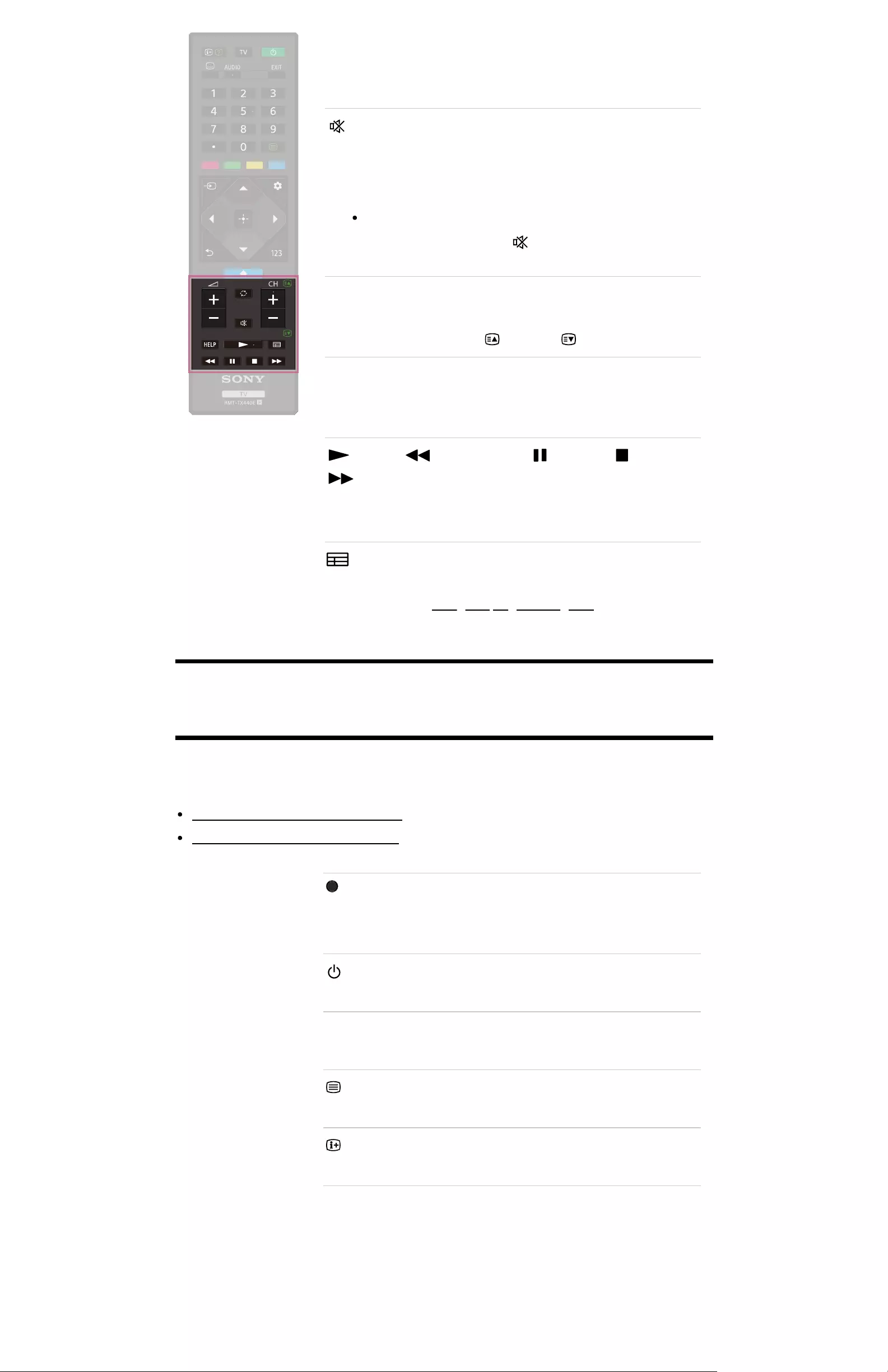
Jump back and forth between two channels or inputs. The TV
alternates between the current channel or input and the last
channel or input that was selected.
(Mute)
Mute the sound. Press again to restore the sound.
Hint
The accessibility shortcut service can be turned on or off
by pressing and holding (Mute).
CH +/- (Channel)
In TV mode: Select the channel.
In Text mode: Select the (Next) or (Previous) page.
HELP
Display the Help menu. Help Guide can be accessed from
here.
(Play) / (Fast rewind) / (Pause) / (Stop) /
(Fast forward)
Operate media contents on the TV and connected BRAVIA
Sync-compatible device.
(Guide)
Display the digital programme guide of the TV or TV box. For
details, refer to Using the programme guide page.
[8] Remote control | Remote control
Upper buttons on the remote control
The included remote control, as well as the layout of the buttons and the button names, vary
depending on your model/country/region.
Middle buttons on the remote control
Lower buttons on the remote control
(MIC)
Speak into here to use the microphone in the remote control.
There is an LED above the microphone.
(Power)
Turns on or switches to standby/networked standby mode.
Number Button
Use with the 0-9 buttons to select digital channels.
(Text)
Display text information.
(Info/Text reveal)
Display information.
App buttons (Online service)
Enjoy various video streaming services with one push. Press
to watch your desired service.
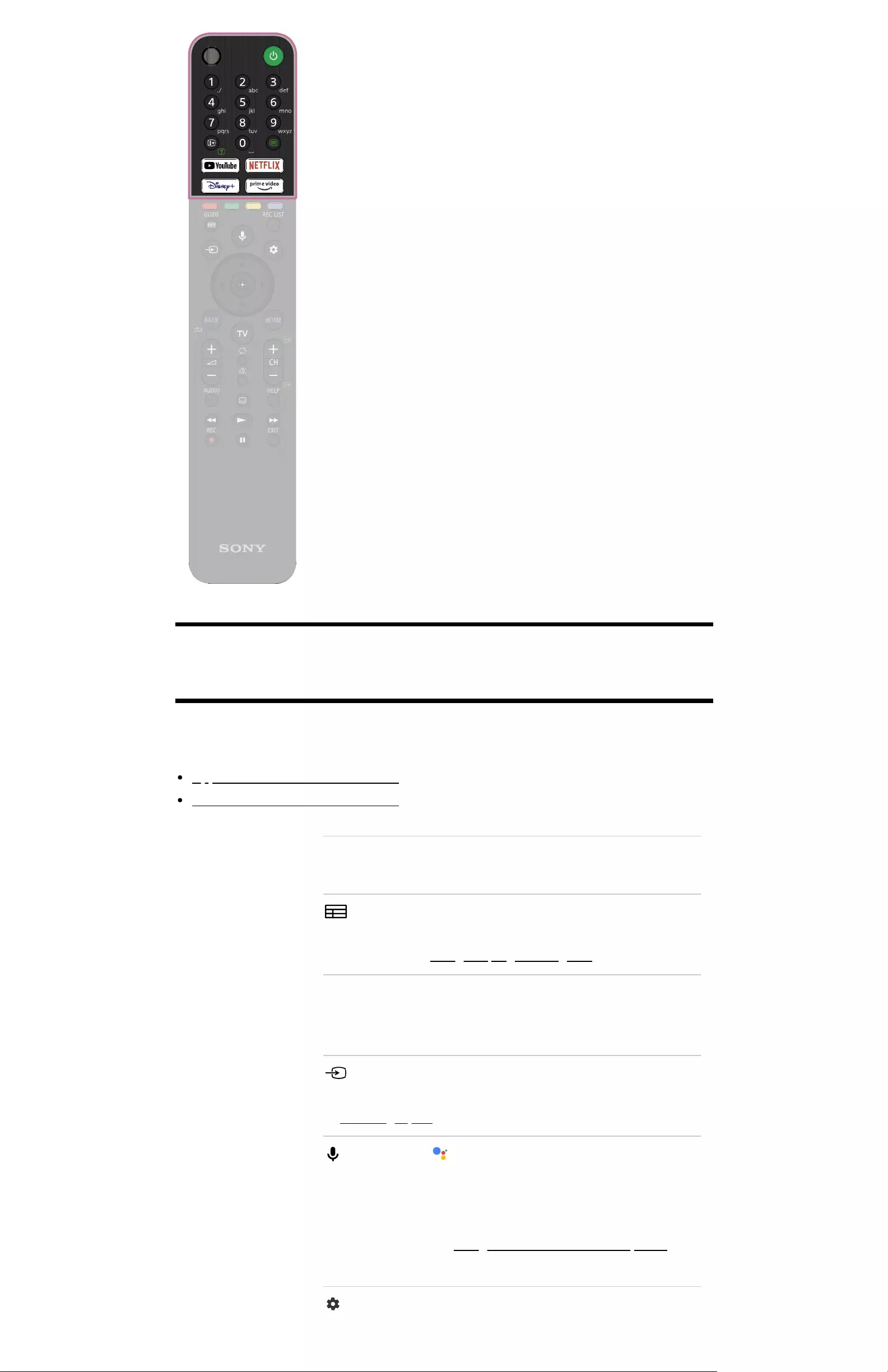
[9] Remote control | Remote control
Middle buttons on the remote control
The included remote control, as well as the layout of the buttons and the button names, vary
depending on your model/country/region.
Upper buttons on the remote control
Lower buttons on the remote control
Colour buttons
Execute corresponding function at that time.
(Guide)
Display the digital programme guide of the TV or TV box. For
details, refer to Using the programme guide page.
REC LIST
Display the Rec list of the USB HDD, or the DVR after setting
[TV box setup].
(Input select)
Display and select the input source, etc. For details, refer to
Selecting inputs page.
(Microphone)/ (Google Assistant)
Talk to Google Assistant or search for various content with
your voice. Google Assistant is not available in certain
languages/countries/regions.
For details, refer to Using the remote control microphone
page.
(Quick Settings)
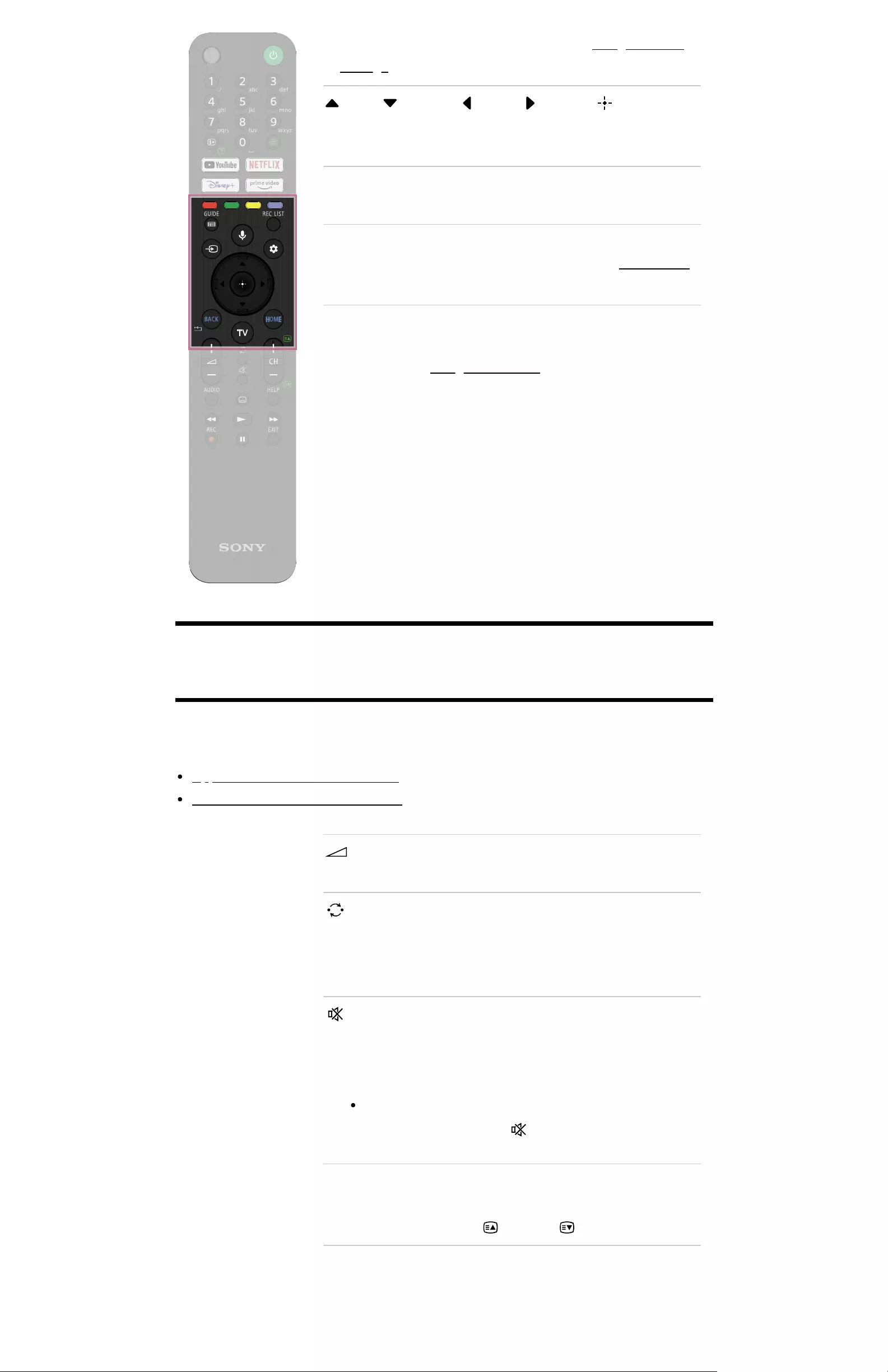
Display Quick Settings. For details, refer to Using the Quick
Settings page.
(Up) / (Down) / (Left) / (Right) / (Enter)
(Navigation D-Pad)
On screen menu navigation and selection.
BACK
Return to the previous screen.
HOME
Display the TV Home Menu. For details, refer to Home menu
page.
TV
Switch to a TV channel or input and display the TV menu. For
details, refer to Using the TV menu page.
[10] Remote control | Remote control
Lower buttons on the remote control
The included remote control, as well as the layout of the buttons and the button names, vary
depending on your model/country/region.
Upper buttons on the remote control
Middle buttons on the remote control
+/- (Volume)
Adjust the volume.
(Jump)
Jump back and forth between two channels or inputs. The TV
alternates between the current channel or input and the last
channel or input that was selected.
(Mute)
Mute the sound. Press again to restore the sound.
Hint
The accessibility shortcut service can be turned on or off
by pressing and holding (Mute).
CH +/- (Channel)
In TV mode: Select the channel.
In Text mode: Select the (Next) or (Previous) page.
AUDIO
Select multilingual source sound or dual sound for the
programme currently being viewed (depending on programme
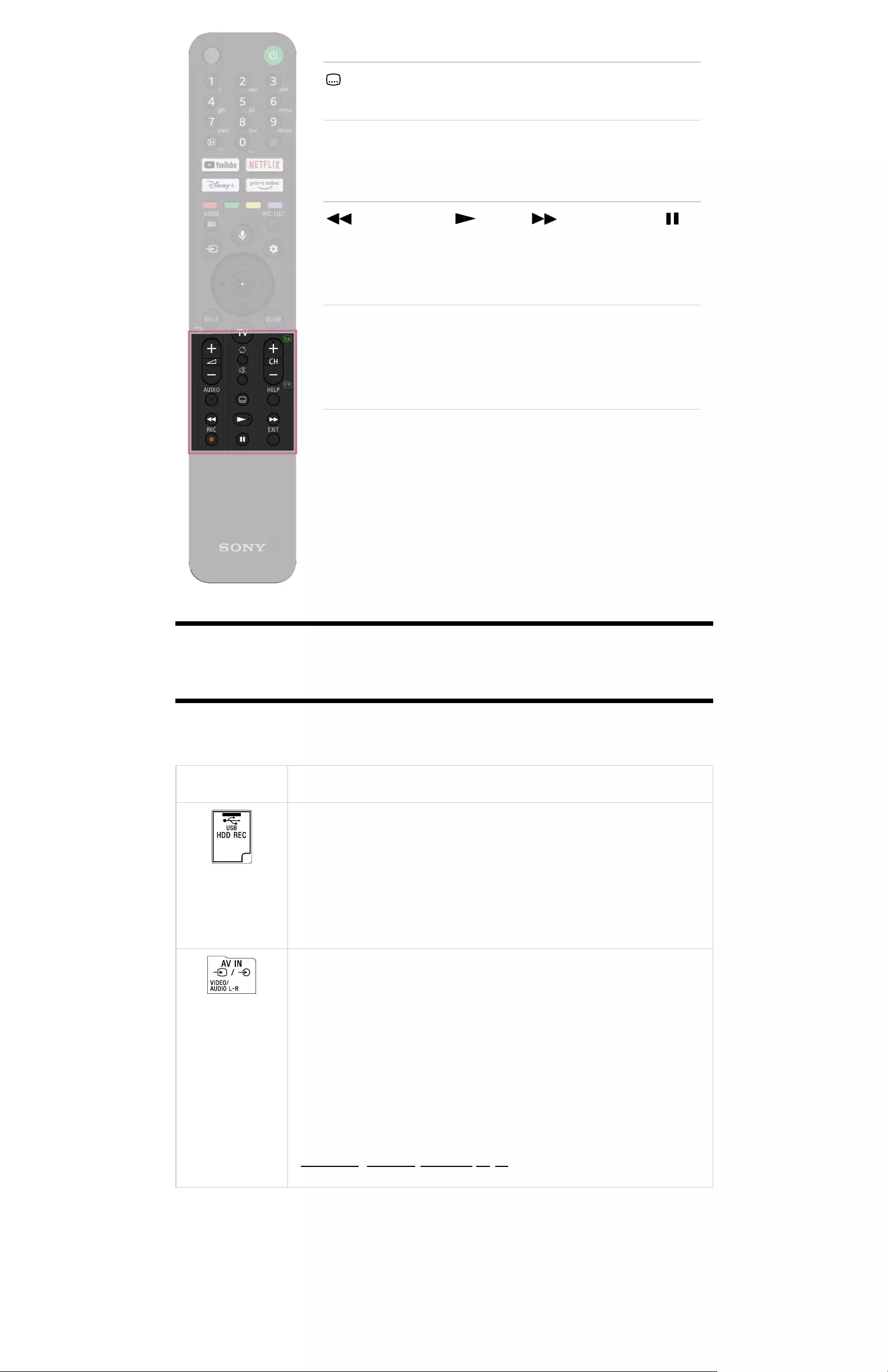
source).
(Subtitle setting)
Turn subtitles on or off (when the feature is available).
HELP
Display the Help menu. Help Guide can be accessed from
here.
(Fast rewind) / (Play) / (Fast forward) /
(Pause)
Operate media contents on the TV and connected BRAVIA
Sync-compatible device.
REC
Record the currently viewed programme on the USB HDD, or
DVR after setting [TV box setup] (depending on
region/country/TV model). Not available for Italy.
EXIT
Return to the previous screen or exit from the menu. When an
Interactive Application service is available, press to exit from
the service.
[11] Getting Started
Connecting terminal
The types and shapes of connectors available vary depending on your TV.
For the location of the connectors, refer to the Setup Guide (printed manual).
Terminal Description
USB HDD REC
Connects to the USB HDD device or Digital still
camera/Camcorder/USB storage media.
The USB HDD recording function is only available in limited
regions/countries/TV models.
AV IN
Connects to VCR/Video game equipment/DVD
player/Camcorder/External Box.
For a composite connection, use an Analogue Extension Cable (not
supplied).
For an external device which has only SCART AV OUT, use a
SCART-RCA adaptor and Analogue Extension Cable.
For more about the shape of the Analogue Extension Cable, refer to
Connecting a Blu-ray or DVD player.
*1
*1

Terminal Description
(Headphone)
Connects to the headphone jack to listen to sound from the TV.
Supports 3-pole stereo mini jack only.
Note
You cannot output sound from both the headphone and the TV
speakers at the same time.
HDMI IN
Connects to the HDMI device. The HDMI interface can transfer the
digital video and audio on a single cable. To enjoy high quality 4K
contents, connect a Premium High Speed HDMI Cable(s) and
follow the instructions displayed on the screen to set the [HDMI signal
format] of the HDMI IN port.
HDMI IN (8K, 4K 120 Hz)
If you use an HDMI device that supports video output in 8K or 4K
100/120 Hz, connect the Ultra High Speed HDMI Cable, and follow
the instructions displayed on the screen to set the [HDMI signal
format] of the HDMI IN port.
Note
4K 100 Hz support depends on your country/region.
HDMI IN (4K 120 Hz)
If you use an HDMI device that supports video output in 4K 100/120
Hz, connect the Ultra High Speed HDMI Cable, and follow the
instructions displayed on the screen to set the [HDMI signal format] of
the HDMI IN port.
Note
4K 100 Hz support depends on your country/region.
HDMI IN (eARC/ARC)
To connect an audio system that supports eARC (Enhanced Audio
Return Channel) or ARC (Audio Return Channel), connect to the
HDMI port labelled “eARC/ARC” on the TV. It is a feature that sends
audio to an audio system that supports eARC/ARC through an HDMI
cable. If the audio system does not support eARC/ARC, you need to
connect with DIGITAL AUDIO OUT (OPTICAL).
DIGITAL AUDIO OUT (OPTICAL)
Connects to an audio system with optical audio input.
When connecting an audio system not compatible with ARC using an
HDMI cable, you need to connect an optical audio cable to the
DIGITAL AUDIO OUT (OPTICAL) to output digital sound.
™
™
™
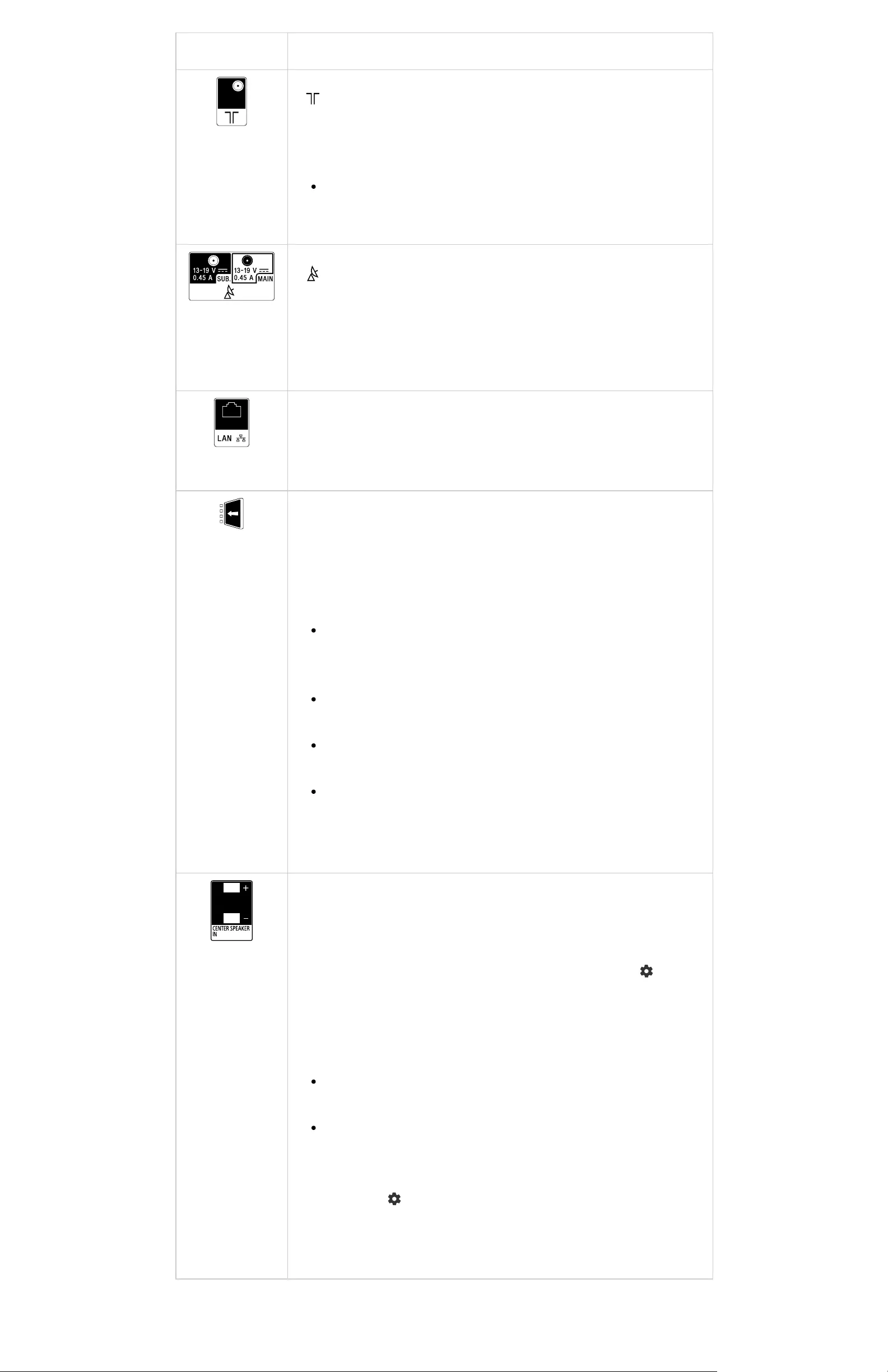
Terminal Description
(RF input)
Connects to Cable/Antenna/External Box.
Note
When connecting the cable to the Cable/Antenna input, finger
tighten only, over tightening the connection can damage the TV.
(Satellite input)
Connects to satellite input.
Connection steps: SUB. → MAIN → Antenna.
For SUB. jack, connect only when you are using twin tuner mode
except for Single Cable Distribution EN50494 (depends on model).
LAN
Connect to a Router.
Connect to the Internet using a LAN cable.
CAM (Conditional Access Module)
Provides access to pay TV services. For details, refer to the
instruction manual supplied with your CAM.
Note
Do not insert the smart card directly into the TV CAM slot. It
must be fitted into the Conditional Access Module provided by
your authorised dealer.
CAM is not supported in some countries/areas. Check with
your authorised dealer.
A CAM message may appear when you switch to a digital
programme after using the Internet video.
Do not remove the dummy card or cover (availability depends
on TV model) from the TV CAM slot other than to insert a smart
card fitted in CAM.
CENTER SPEAKER IN
To use your TV speakers as the centre speaker, connect the output of
your AV receiver to the CENTER SPEAKER IN on your TV.
To use your TV speakers as the centre speaker, press the (Quick
Settings) button on the remote control, then select [Settings] —
[Display & Sound] — [Audio output] — [Speakers] — [Audio system].
Note
Before connecting cables, disconnect the AC power cord
(mains lead) of both the TV and AV receiver.
If you do not use the CENTER SPEAKER IN terminal or the S-
CENTER SPEAKER IN input, change the following setting to
prevent noise from the speakers.
Press the (Quick Settings) button on the remote control, and
disable [TV centre speaker mode] in [Settings] — [Display &
Sound] — [Audio output].

Terminal Description
S-CENTER SPEAKER IN
Connects the TV and an audio device with an S-CENTER OUT
output/jack using a TV centre speaker mode cable. Before
connecting, make sure you unplug the AC power cord (mains lead) of
the TV and audio device to be connected.
For details, refer to Using the TV as a centre speaker (only models
with TV centre speaker mode).
Note
If you do not use the CENTER SPEAKER IN terminal or the S-
CENTER SPEAKER IN input, you will need to perform the
following steps to prevent noise from the speakers.
Press the (Quick Settings) button on the remote control, and
disable [TV centre speaker mode] in [Settings] — [Display &
Sound] — [Audio output].
[12] Getting Started
How the LEDs light up
You can check the status of the TV by looking at how the LEDs light up.
(A) (B)
(A) Voice function LED (On the left side at the bottom of the TV. Only TVs with a built-in MIC. )
(B) Operational response LED (In the centre at the bottom of the TV.)
The built-in MIC may not be available depending on your region/model/language.
Voice function LED
Turns “on” or “blinks” when “Ok Google” is detected and the TV is communicating with the
server. The lighting pattern of this LED depends on the server communication status.
Note
You can use the built-in MIC on the TV when the Built-in MIC switch is on. For the
location of the Built-in MIC Switch, refer to the Reference Guide supplied with the TV.
After you press the MIC/Google Assistant button on the remote control and finish
activating the built-in MIC on the TV, the voice function LED turns on in amber when the
built-in MIC on the TV is off (when on, the Operational response LED turns on in
amber).
Operational response LED
Turns “on” or “blinks” in white when the TV is turning on, when receiving signals from the
remote control, or when updating the software using a USB storage device.
When ["Ok Google" detection] is enabled, it turns “on” in amber. (only TVs with a built-in MIC )
The built-in MIC may not be available depending on your region/model/language.
When the Built-in MIC switch is on, it turns “on” in amber. (only TVs with a built-in MIC )
The built-in MIC may not be available depending on your region/model/language.
*
*
*
*
*
*

Related topics
Using the built-in MIC on the TV (only TVs with a built-in MIC)
You want to disable the LED so that it does not light up or blink.
Home network features
Software updates
[13] Getting Started
Home menu
The screen displayed when you press the HOME/ (HOME) button on the remote control is
called the Home Menu. From the Home Menu, you can search for content and select
recommended content, apps, and settings.
The items displayed on the Home Menu depends on whether a Google Account has been
setup on the TV.
(Some features do not apply depending on your model/region/country. The images are for
reference only. They may differ from the actual screen.)
(A) The Home Menu when a Google Account is setup on the TV
(B) The Home Menu when a Google Account is not setup on the TV
Setting up a Google Account and enjoying the TV
If you connect the TV to the Internet and setup a Google Account, you can install desired apps
on the TV and enjoy Internet videos and use your voice to search for content.
Enjoying the TV without setting up a Google Account
Even if you do not setup a Google Account, you can watch TV broadcasts and/or view content
from devices connected to the TV such as a Blu-ray player. If you connect the TV to the
Internet, you can also use the Internet streaming services displayed on the Home Menu.
Note
To setup a Google Account later and enjoy the TV, set up Google TV from the Home
Menu or settings menu.
If you delete the Google Account, the TV will return to the factory default settings.
Hint
Depending on the TV settings, the Home screen will be displayed when the TV is
turned on. If you change the following setting, you can change the screen that is

1
2
1
1
2
3
4
displayed when the TV is turned on to the TV broadcast channel or external input such
as HDMI that you were watching before turning off the TV.
Press the (Quick Settings) button on the remote control.
Select [Power-on behaviour], and then select [Last input].
The next time the TV is turned on, the TV broadcast channel or external input such as
HDMI that you were watching before turning off the TV will be displayed.
Specifications may be subject to change without notice.
For other information, see “Frequently Asked Questions” on the Sony Support Site.
Frequently Asked Questions for Troubleshooting
[14] Getting Started
Selecting inputs
To use devices (such as a Blu-ray/DVD player or USB flash drive) connected to the TV, or to
watch TV after such use, you will need to switch the input.
If you edit the items and add apps, you will be able to switch to those apps in the input
selection screen.
Press the (Input select) button repeatedly to select the connected device.
Alternatively, press the (Input select) button, use the (Left) / (Right)
buttons to select a connected device, and then press the (Enter) button.
Note
If there are no devices connected to an HDMI input, the HDMI input may not be
displayed in the [Input menu].
To edit the input items
Press the (Input select) button.
Press the (Right) button (or (Left) button depending on the TV's display
language) and select (Edit).
Select the app/input/device you want to show or hide.
Select [Close].
Hint
To change the order or hide a displayed item, press the (Up) button on the remote
control with that item highlighted, and [Move] and [Hide] will be displayed. If you select
[Move], use (Left) / (Right) on the remote control to move the item to the desired
position, and then press the (Enter) button on the remote control.
You can switch to TV broadcasting by simply pressing the TV button on the remote
control.
[15] Getting Started
Performing acoustic auto calibration
You can correct the audio to the best acoustics for your viewing environment by using the
remote control microphone to measure a test sound from the TV. (This setting may not be
available depending on the model.)
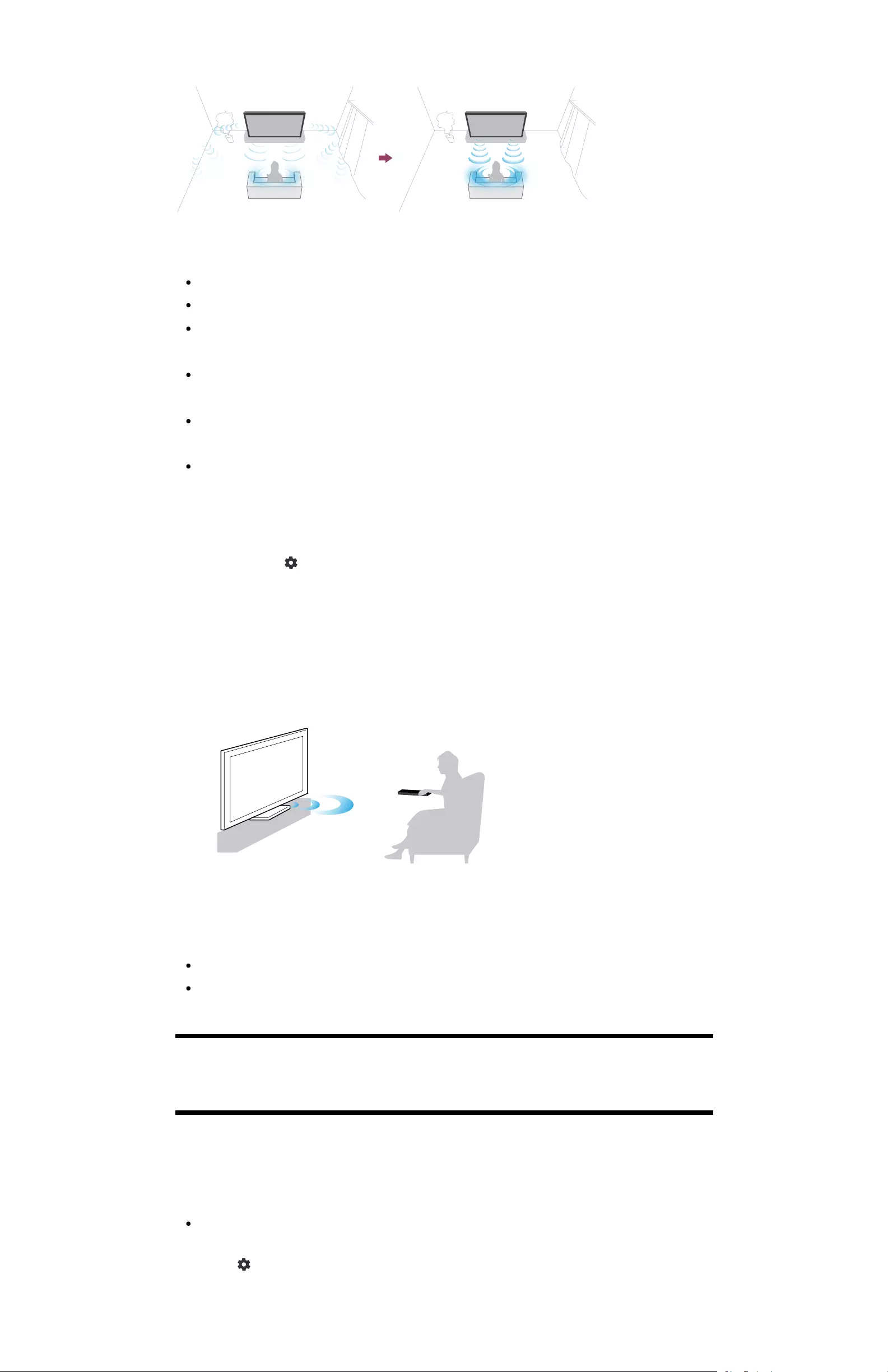
1
2
Models that support acoustic auto calibration have the following setting.
[Settings] — [Display & Sound] — [Sound] — [Acoustic auto calibration]
Note
Calibration effects will vary depending on your watching environment.
A loud test sound will be played from the TV during measurement.
Do not block the microphone opening at the end of the remote control during
measurement.
Do not move the remote control during measurement. Doing so may result in incorrect
measurement.
Perform the calibration when your surroundings are quiet. Noise may result in incorrect
measurement.
Acoustic auto calibration cannot be performed if you are using a sound bar. Change the
following setting.
[Settings] — [Display & Sound] — [Audio output] — [Speakers] — [TV speakers]
Press the (Quick Settings) button on the remote control, then select the
following settings.
[Settings] — [Display & Sound] — [Sound] — [Acoustic auto calibration] —
[Calibration setup]
Measure by following the on-screen instructions.
The acoustics will be corrected automatically based on the measurement results of
your watching environment.
Hint
Acoustic auto calibration may fail in the following cases.
If the remote control is moved during measurement
If there are sounds other than the test sound (such as noise) during measurement
[16] Getting Started
Accessibility features
This TV has accessibility features in [Accessibility] such as a text-to-speech function for on-
screen text, zooming to make text easier to read, and subtitles.
Note
Some features do not apply depending on your model/region/country.
Press the (Quick Settings) button on the remote control, then select [Settings] — [System]
— [Accessibility] to configure the user assistive features.

1
2
[Accessibility] has a shortcut function so you can turn it on or off by pressing and holding the
(Mute) button on the remote control for 3 seconds.
Hint
To change the shortcut function, select [Accessibility shortcut] in [Accessibility], enable
[Enable accessibility shortcut], and change the function in [Shortcut service].
If you select [Accessibility tutorial] in [Accessibility], you can learn about user
accessibility features supported by the TV. (This feature may not be available
depending on your model.)
To use text-to-speech with the Help Guide, view the Help Guide from the Sony support
website using a computer or smartphone.
For more information about accessibility, please visit the Sony support website.
https://www.sony.net/A11y.GoogleTV/
[17]
Useful features
Searching for content/operating the TV with your voice
Enjoying preferred apps
Finding the remote control (only models supplied with a buzzer built-in remote control)
Enjoying safe apps and video streaming services (Security and restrictions)
Enjoying the Camera and Microphone Unit
[18] Useful features
Searching for content/operating the TV with your
voice
Using the remote control microphone This feature is available for TVs in which the included
remote control has a MIC button.
Using the built-in MIC on the TV (only TVs with a built-in MIC)
[19] Searching for content/operating the TV with your voice | Searching for content/operating
the TV with your voice
Using the remote control microphone
Remote controls that support voice control have a Google Assistant or MIC button, and a
built-in microphone. Ask Google to find movies, stream apps, play music, and control the TV -
all with your voice. Press the Google Assistant (or MIC) button on the remote to get started.
Press and hold the Google Assistant or MIC button on your remote control.
The microphone on the remote control will be activated while the button is pressed,
and the LED on the remote control will light up.
Speak into the microphone while pressing and holding the Google Assistant
or MIC button.
Speech examples may be displayed depending on your model.

Search results are displayed when you speak into the microphone.
Hint
If you press the MIC button on the remote control and say “Voice hints”, information
about how to speak and available voice commands will be displayed. This function may
not be available depending on your model/region/country/language.
Note
An Internet connection is required to use voice search.
The type of remote control supplied with the TV, and the availability of a remote control
with a built-in microphone varies depending on your model/region/country. An optional
remote control is available in some models/regions/countries.
To use the microphone on the remote control, you must add and set a Google Account
to the TV.
[20] Searching for content/operating the TV with your voice | Searching for content/operating
the TV with your voice
Using the built-in MIC on the TV (only TVs with a
built-in MIC)
The built-in MIC on the TV may not be available depending on your region/country/language.
For details about languages that support the built-in MIC on the TV feature, refer to the
following Sony support website.
https://www.sony.net/tv-hf/aep/
Hint
The URL is subject to change without notice.
Do more on your TV using only your voice. Just start with “Ok Google” to:
Control your TV and smart home devices
Enjoy music and entertainment
Get answers
Plan your day and manage tasks
Face the TV and say, “Ok Google” to get started.

1
When the voice function LED blinks white, start speaking.
(A) (B)
(A) The voice function LED is located at the bottom just left of centre of the TV.
(B) The LED located at the bottom centre of the TV lights up amber when hands-free
operation is available.
To use the built-in MIC, enable the following setting.
Turn on the built-in MIC switch on the TV.
For the location of the built-in MIC switch on the TV, refer to the Reference Guide.
Note
An Internet connection is required to use the built-in MIC on the TV.
After turning on the built-in MIC switch on the TV, you need to press the MIC/Google
Assistant button on the remote control to complete the setup, depending on your
model/country/region. (Only models with the built-in MIC switch)
Power consumption will increase when the built-in MIC is enabled as it is always
listening.
Hint
When the built-in MIC switch on the TV is enabled, the Operational response LED lights
up in amber even when the TV is turned off (you can also set it so it does not light up).
(Only models with the built-in MIC switch)
With the TV's built-in MIC enabled, you can say “Ok Google, Where is the remote
control?” to the TV to play a buzzer from the remote control. This is useful when you
cannot find the remote control. For details, refer to Finding the remote control (only
models supplied with a buzzer built-in remote control).
The TV's built-in MIC may pick up sound from the surroundings and respond
unintentionally. You can use [Built-in MIC sensitivity] to change the mic sensitivity.
Press the (Quick Settings) button on the remote control, and select the following in
order.
[Settings] — [System] — [Built-in MIC sensitivity]
Related topics
Connecting to a Network
How the LEDs light up
You want to disable the LED so that it does not light up or blink.
[21] Useful features
Enjoying preferred apps
Installing apps
[22] Enjoying preferred apps | Enjoying preferred apps
Installing apps
You can install apps to the TV, just like you do with smartphones and tablets.

1
2
1
Note
You can only install apps that are compatible with TVs. They may differ from apps for
smartphones/tablets.
An Internet connection and Google Account are required to install apps.
Hint
If you do not have a Google Account or want to create a shared account, create a new
account by accessing the following website.
https://accounts.google.com/signup
The website above may vary depending on your region/country. It is also subject to
change without notice. For details, refer to the Google homepage.
We recommend that you create a Google Account on a computer or mobile device.
Press the HOME/ button, and from [Search] on the Home screen, say
something like “Search for <app name> apps” to search for apps you want to
install. Alternatively, select the input field and use the on-screen keyboard.
Select an app from the search results and install it.
Hint
If the app search does not produce the desired results, say “Google Play Store”, and try
searching for the app on the Google Play Store screen.
You can also select a category from the Apps tab in the Home Menu and select a
desired app.
After downloading, the app is automatically installed and added. You can select [Open] to
launch the app.
Hint
To start an installed app later, select the Apps tab in the Home Menu, and select [See
all] at the right edge of the app area. Select the installed app to start it.
About paid apps
There are free apps and paid apps. To purchase a paid app, a prepaid Google Play gift card
code or credit card information is required. You can purchase a Google Play gift card from
various retailers.
To delete an app
Press the (Quick Settings) button on the remote control, select [Settings]
— [Apps], select an app to be deleted, and uninstall it.
Related topics
Connecting to a network using a LAN cable
Using Wi-Fi to connect the TV to the Internet/Network
[23] Useful features
Finding the remote control (only models supplied
with a buzzer built-in remote control)
The remote control supplied with the TV has a feature that allows you to find the remote
control by playing a sound from a built-in buzzer when you cannot find it, such as when you do
not remember where you left it (for example, under a cushion or hidden under a newspaper),
or when you are watching a movie in a dark room.

1
2
1
Use the following procedures to find the remote control.
Using the power button on the TV
Press the power button on the TV.
A menu is displayed on the TV screen.
Follow the on-screen instructions and select [Find remote] on the displayed
menu.
A buzzer plays from the remote control.
Using the built-in MIC on the TV (only TV's with a built-in MIC)
With the TV's built-in MIC enabled, say “Ok Google, Where is the remote
control?” to the TV.
A buzzer plays from the remote control.
Note
The [Find remote] option, which is displayed by pressing the power button on the TV, is
only displayed when a remote control with a built-in buzzer is paired with the TV.
The feature to find a remote control using the built-in MIC on the TV is available only to
some models/countries/regions/languages.
To find a remote control using the TV's built-in MIC, the TV must be on (in some
languages, you can find a remote control using the TV's built-in MIC even if the TV is
off).
If your TV is connected to the Internet and you have set a Google Account, the find
feature using the TV's built-in MIC will be enabled. If you have not set a Google Account,
this feature will not be enabled. Depending on the model, you may not be able to find it
unless the TV is turned on.
There is a limit to the distance you can search for the remote control from your TV. The
buzzer cannot be played by the remote control in places where the signals do not reach.
Related topics
Viewing Internet content
Accounts & Sign-In
Using the built-in MIC on the TV (only TVs with a built-in MIC)
[24] Useful features
Enjoying safe apps and video streaming services
(Security and restrictions)
You can ensure safe use of the TV by setting installation restrictions on apps that are
downloaded from unknown sources, or age restrictions on programmes and videos. (Some
features do not apply depending on your model/region/country.)
You can set the following [Parental controls] features so that children can safely use the TV.
Restrict TV channels and use of external inputs
Restrict installation of apps from unknown sources

1
1
2
3
4
1
1
Restrict use of apps (password lock feature)
Restrict TV usage time
You can use restrict features by setting the following.
To set age restrictions on programmes
Press the (Quick Settings) button on the remote control, and then select
the following in order.
[Settings] — [System] — [Parental controls] — [Channels & External inputs] — [TV
rating].
The options depend on your model/country/region/settings.
To restrict apps (password lock feature)
Set to restrict children from using apps such as internet browsers.
Restrictions are set in [Parental controls].
If this is set, you will be required to input the PIN when starting an app.
Press the (Quick Settings) button on the remote control, and select the
following in order.
[Settings] — [System] — [Parental controls] — [Apps]
Set or input the PIN.
Enable [Restrict apps].
Select the apps that you want to restrict from the app list.
Restricted apps will change from (Unlocked) to (Locked). To restrict all apps,
select [All apps].
To restrict the installation of apps from unknown sources
If this is set, there will be fewer items displayed in the Home Menu and settings menu.
Press the (Quick Settings) button on the remote control, and select the
following in order.
[Settings] — [Privacy] — [Security and restrictions] — [Unknown sources] —
change the setting in [Install unknown apps].
Note
If you change the [Security and restrictions] settings, your device and personal data are
more vulnerable to attack by unknown apps from sources other than Play Store. You
agree that you are solely responsible for any damage to your device or loss of data that
may result from using these apps.
If you forget the PIN, you must reset the TV to its original factory settings. Make sure you
do not forget the PIN.
Hint
Other separate restrictions may be available depending on the app. For details, refer to
the app’s Help.
To restrict usage time of the TV
Set to restrict the time in which children use the TV.
Press the (Quick Settings) button on the remote control, and select the
following in order.
[Settings] — [System] — [Parental controls] — [Screen time]
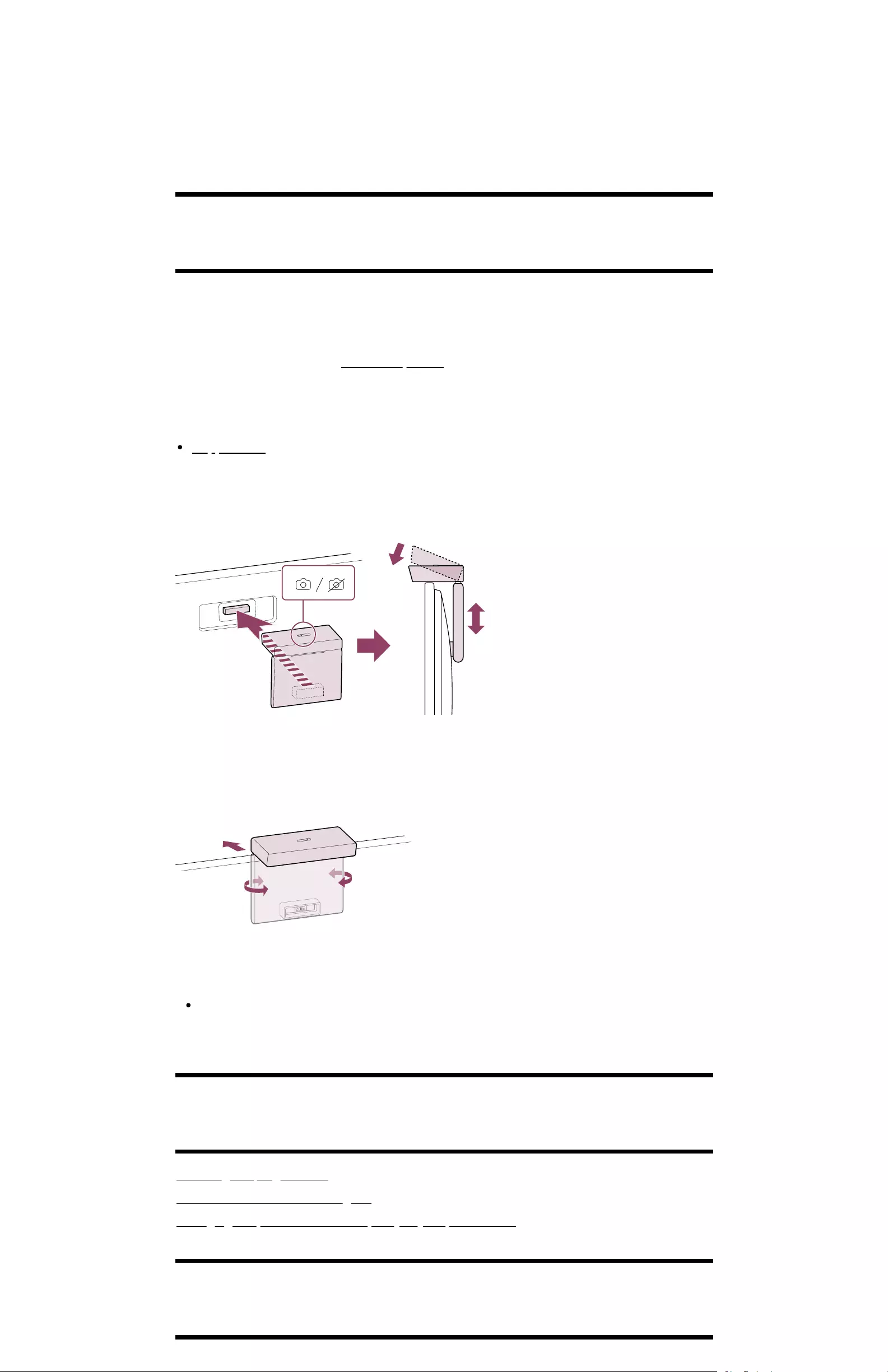
3
2Set or input the PIN.
Enable [Restrict screen time] to start restriction.
The restriction setting will be displayed under [Restrict screen time]. To change the
setting, set it in [Usage time limit] or [Restricted time slot].
[25] Useful features
Enjoying the Camera and Microphone Unit
You can connect the supplied Camera and Microphone Unit to the TV to enjoy features such
as video chat.
To use the supplied Camera and Microphone Unit, you may have to update the software. To
update the software, refer to Software updates.
For details about the supplied Camera and Microphone Unit and software updates, please
refer to our support site.
Support Site
Attaching
Attach the supplied Camera and Microphone Unit to the Camera port on the back of the TV.
Removing
To easily remove the supplied Camera and Microphone Unit, twist it slightly as shown in the
figure below.
Hint
The Camera port and mounting position of the supplied Camera and Microphone Unit
differ depending on the TV. Refer to the Setup Guide supplied with the TV.
[26]
Watching TV
Watching TV programmes
Useful features when watching TV
Changing the picture and sound quality to your preferences
[27] Watching TV
Watching TV programmes

1
2
3
Understanding the information banner icons
Using the programme guide
Configuring channel settings
Using the TV menu
Using interactive broadcast TV services
[28] Watching TV programmes | Watching TV programmes
Understanding the information banner icons
When changing the channel, an information banner appears briefly. The following icons may
appear in the banner.
:Data service (Broadcast application)
:Radio service
:Scrambled/Subscription service
:Multilingual audio available
:Subtitles available
:Subtitles and/or audio available for the hearing impaired
:Recommended minimum age for current programme (from 3 to 18 years)
:Parental lock
:Audio available for the visually impaired
:Spoken subtitle audio available
:Multi-channel audio available
Related topics
Using interactive broadcast TV services
Channels & Inputs
[29] Watching TV programmes | Watching TV programmes
Using the programme guide
You can quickly find your preferred programmes.
Press the GUIDE/ (Guide) button to display the digital programme guide.
Select a programme to watch.
The details of the programme are displayed.
Select [View] to watch the programme.
Hint
(TV box control compatible models only) If you perform the [TV box control setup]
setting in [TV box setup] under [External inputs], you can display the programme guide
of the TV box.
Related topics
How to control the TV box using the TV remote control
An external device (such as a TV box) cannot be controlled using the TV's remote
control. (TV box control compatible models only)
[30] Watching TV programmes | Watching TV programmes
Configuring channel settings

1
2
1
2
Receiving digital broadcasts
Receiving satellite broadcasts
Sorting or editing the channels
[31] Configuring channel settings | Configuring channel settings | Configuring channel settings
Receiving digital broadcasts
Press the (Quick Settings) button on the remote control, then select
[Settings] — [Channels & Inputs] — [Channels] — [Channel setup] — [Auto
tuning].
Follow the on-screen instructions to tune in all available digital channels and
store them in the TV.
To change the tuning range
Press the (Quick Settings) button on the remote control, then select [Settings] —
[Channels & Inputs] — [Channels] — [Channel setup] — [Advanced settings] — [Tuning
range] — [Normal] or [Extended].
[Normal]
Searches for available channels within your region/country.
[Extended]
Searches for available channels regardless of region/country.
Hint
You can retune the TV by selecting [Auto tuning] and following the on-screen instructions
after moving to a new residence, changing service providers, or to search for newly
launched channels.
Related topics
Some digital channels are missing.
[32] Configuring channel settings | Configuring channel settings | Configuring channel settings
Receiving satellite broadcasts
If you have a satellite dish installed, you can view satellite broadcasts by configuring the tuner
settings.
Press the (Quick Settings) button on the remote control, then select
[Settings] — [Channels & Inputs] — [Channels] — [Channel setup] — [Auto
tuning] — [Set up] for subscribed satellite broadcasts.
Follow the on-screen instructions.
Related topics
You cannot view satellite channels.
[33] Configuring channel settings | Configuring channel settings | Configuring channel settings
Sorting or editing the channels
You can sort the channel display according to your preferred order.

1
2
3
4
1
2
Press the (Quick Settings) button on the remote control, then select
[Settings] — [Channels & Inputs] — [Channels] — [Channel list edit].
If multiple items are displayed, select the one you want to edit.
Choose the channel you want to move to a new position.
You can select to [Insert] or [Swap] the selected channel. To change it, select [Sorting
type].
Choose the new position where you want to move the selected channel.
Select [Done] to apply the changes.
Note
Available options may vary depending on your region/country.
[34] Watching TV programmes | Watching TV programmes
Using the TV menu
Press the TV button while watching a TV broadcast to display the [TV menu]. A channel list is
displayed in [TV menu] and you can easily select programmes on other channels while
watching TV.
You can add favourite channels when using the built-in tuner.
Note
The displayed screen and menus may vary depending on what you are watching and
your model/country/region.
Press the TV button while watching a TV broadcast.
The TV menu is displayed at the bottom of the screen.
Move the focus left or right and select the programme you want to watch.
If you move the focus down and select [TV settings] or [Remote control], options
available while you are watching will be displayed. You can also select options such
as [Digital] or [Cable] to change the displayed Channel list. (The displayed options
vary depending on what you are watching.)
Hint
To add the channel you are watching to favourites, press the (Up) button on the
remote control from the [TV menu] and add the channel to favourites from the displayed
menu.
You can use the TV button on the remote control to display the channels from the TV
box.
Press the (Quick Settings) button on the remote control, then select [Settings] —
[Channels & Inputs] — [TV button shortcut].
Then, select the input that is connected to the TV box.
If you configured a TV box in the initial setup, you can press the TV button to display the
channel list of the TV box.

1
You can also operate the TV box with the control panel displayed when you select
[Remote control].
TV box control compatible models have [TV box setup] in [Settings] — [Channels &
Inputs] — [External inputs].
[35] Watching TV programmes | Watching TV programmes
Using interactive broadcast TV services
To display text information
You can view text and text-based graphical information, including national news, weather
information, and TV schedules. You can browse for information that interests you, and then
select what information you want to display by entering a number.
Press the 123 (Control menu) button to display the Control menu, and select
[Colour/Data broadcasting navigation] — [Text] from the menu to display text
information. If the supplied remote control has a (Text) button, press the
(Text) button to display text information.
About the Digital Text Information Service
The digital text service offers rich content with smooth graphics and images. Various features
are available, such as page links and easy-to-use navigation. The service is supported by
numerous broadcasters. (The availability of this feature depends on your
model/region/country.)
About the Digital Interactive Application Service
The interactive application service offers high-quality digital text and graphics, along with
advanced options. The service is supported by broadcasters. (The availability of this feature
depends on your model/region/country.)
Note
The interactive service is only available if provided by the broadcaster.
Available functions and screen content varies depending on the broadcaster.
If subtitles are selected and you launch a digital text application, subtitles may, under
certain circumstances, stop being displayed. When you exit the digital text application,
subtitle display will resume automatically.
[36] Watching TV
Useful features when watching TV
Timers
Use a timer to turn the TV on and off.
For details, refer to Timers & Clock.
Parental lock
Use [Parental controls] to set parental restrictions.
For details, refer to System.
(Subtitle setting)
You can press the 123 (Control menu) button on the remote control to enable subtitles. If
the supplied remote control has a (Subtitle setting) button, you can press the
(Subtitle setting) button when watching content with available subtitles.
Picture quality/sound quality adjustment

Adjust the picture quality and sound quality according to your preferences.
For details, refer to Display & Sound.
[37] Watching TV
Changing the picture and sound quality to your
preferences
Adjusting the picture quality
Adjusting the sound quality
“Sound” advanced settings
[38] Changing the picture and sound quality to your preferences | Changing the picture and
sound quality to your preferences
Adjusting the picture quality
You can configure various settings related to the TV display such as colour and brightness for
picture quality, or screen size.
Note
The actual display may vary or some settings may not be available depending on your
model/country/region and the content you are watching.
Press the (Quick Settings) button on the remote control, then select [Settings] — [Display
& Sound] — the desired option.
You can change the following settings.
Picture
Adjust the picture settings such as Brightness, Colour, and Hue.
Basic
You can set the following.
Picture mode
Change the picture quality according to the content you are watching such as movies or sports.
Reset picture settings for ***
Reset the picture settings for the current picture mode to the factory default.
Auto picture mode
Automatically selects the picture mode based on the content being viewed.
*** calibrated mode
Adjusts the picture to a quality close to that intended by the content creator when watching
supported video streaming content and supported apps.
Light sensor
Optimises brightness according to ambient light.
Ambient light sensor
Automatically adjusts the brightness and colour of the picture based on the surrounding
ambient light.
Actual display may not be available depending on your model/country/region.
Brightness

Adjust the backlight to display the brightest whites and deepest blacks.
Colour
Adjust the colour saturation level and Hue.
Clarity
Adjust the picture clarity and reduce roughness.
Motion
You can set the following.
Motionflow
Refines moving images. Increases the number of image frames to display videos smoothly. If
you select [Custom], you can adjust [Smoothness] and [Clearness].
Film mode
Optimises picture quality based on video content, such as movies and computer graphics.
Smoothly reproduces the motion of filmed images (images recorded at 24 frames per second)
such as movies.
Video signal
You can set the following.
HDR mode
Picture that is suitable for a High Dynamic Range signal.
HDMI video range
Select the signal range for HDMI input.
Colour space
Change the colour reproduction range.
Adv. colour adjustment
You can set the following.
Adv. colour temperature: Basic
Finely adjust the colour temperature for each colour.
Adv. colour temperature: Multi point (***p)
Optimally preset at shipping. Use this setting for professional adjustment. When adjusting, we
recommend using a colour analyser.
Per colour adjustment
Adjust Hue, Saturation, and Lightness for each colour.
Screen
Adjust the aspect ratio and viewable screen area.
Wide mode
Adjust the picture size.
4:3 default
Automatic sizing for 4:3 pictures.
Auto display area
Automatically adjusts the viewable screen area based on the signal.
Display area
Adjust the viewable screen area.
Screen position
Adjust the vertical and horizontal screen position.
Vertical size
Stretch the picture vertically.

[39] Changing the picture and sound quality to your preferences | Changing the picture and
sound quality to your preferences
Adjusting the sound quality
You can configure various settings related to the TV’s sound such as sound quality and sound
mode.
Note
The actual display may vary or some settings may not be available depending on your
model/country/region, TV settings, and the connected device.
Press the (Quick Settings) button on the remote control, then select [Settings] — [Display
& Sound] — the desired option.
You can change the following settings.
Sound
Adjust settings by input such as the TV or HDMI, and other common settings, to enjoy
various sound effects.
You can configure settings such as those below.
Sound mode
Select modes such as [Cinema], [Music], or [Dolby Audio] based on your environment and
preferences.
Sound customisation
Adjust the sound quality for each sound mode in models with Sound mode.
Volume level
Adjust the sound level of current input.
Advanced auto volume
Keeps the volume level constant for all programmes and inputs.
Balance
Adjust the speaker balance.
TV position
Output sound from the TV speakers according to the position of the TV.
Acoustic auto calibration
Adjust audio output based on your viewing environment. For details, refer to Performing
acoustic auto calibration.
Reset
Return all sound settings to factory default settings.
Audio output
Adjust for headphones and audio system.
You can configure settings such as those below.
Speakers
Select TV or external speakers.
TV centre speaker mode
Use the TV speakers as the centre speaker of the home theatre system.
Audio system prioritisation

If enabled, this automatically switches the audio output to a BRAVIA Sync-compatible audio
system when the TV is turned on.
Home theatre control
Turns your audio system on, and allows you to control it.
Sound mode sync
The sound field of the specified audio system will switch automatically when the TV's sound
mode changes.
A/V sync
Adjust audio and video timing while using a Bluetooth A2DP audio device or a specific audio
system connected with an HDMI cable.
eARC mode
If [Auto] is selected, high quality audio is output when an eARC supported device is connected
to an HDMI port labelled “eARC/ARC”.
Digital audio out
Configure the output method when outputting digital audio. This setting is available only when
[Speakers] is set to [Audio system].
Digital audio out volume
Applied for PCM only. The volume levels between PCM and compressed audio will differ.
Dolby Digital Plus output
Select output for Dolby Digital Plus for audio systems supporting Dolby Digital Plus and ARC. If
you use ARC and optical audio out, select [Dolby Digital]. (Dolby Digital Plus will be muted over
optical audio out.)
Pass through mode
Output audio signals to an audio system without decoding.
[40] Changing the picture and sound quality to your preferences | Changing the picture and
sound quality to your preferences
“Sound” advanced settings
This page introduces various settings for the features you can configure in [Sound].
Note
The actual display may vary or some settings may not be available depending on your
model/country/region, TV settings, and the connected device.
[Sound mode] settings
Setting Description
Standard Optimise sound quality for general content.
Dialogue Suitable for spoken dialogue.
Cinema Optimise surround sound for movies.
Music Lets you experience dynamic and clear sound, like that of a concert.
Sports Simulates the larger space of a stadium or other venue.
Dolby Audio Output sound processed by Dolby acoustic technology.
[Sound customisation]
Setting Description
Surround Virtually reproduce realistic surround sound.

Setting Description
Surround effect Adjust the surround sound effect.
Equaliser Adjust sound based on different frequencies.
Voice Zoom Emphasise voice.
Dialogue enhancer Emphasise voice when [Sound mode] is set to [Dolby Audio].
[Volume level]
Setting Description
Volume offset Adjust the sound level of the current input relative to other inputs.
Dolby Dynamic
Range
Compensates for audio level difference between channels (only
for Dolby Digital audio).
MPEG audio
level
Adjusts MPEG audio sound level.
HE‑AAC
Dynamic Range
Compensates for audio level difference between channels (only
for HE‑AAC audio).
HE‑AAC audio
level
Adjusts HE‑AAC audio sound level.
Related topics
Adjusting the sound quality
[41]
Recording TV Programmes
Recording to a USB HDD device
Watching/deleting recorded content
Understanding the symbols displayed in the recorded title list
[42] Recording TV Programmes
Recording to a USB HDD device
Registering a USB HDD device
Timer recording
Information about using a USB HDD device for recording
[43] Recording to a USB HDD device | Recording to a USB HDD device
Registering a USB HDD device
This function is available only in limited regions/countries/TV models.
USB HDD recording models have [Recording device setup] in [Settings] — [Channels &
Inputs].
Connect and register a USB HDD device to your TV to record digital broadcasts.
Connect the USB HDD device to the TV’s USB port labelled “HDD REC” (if there is a blue
USB port, that port supports HDD recording).

1
2
3
4
5
1
1
1
(B)
(A)
(A) USB HDD device
(B) USB cable (not supplied)
Connect a USB HDD device to the USB port (blue) labelled “HDD REC” on
your TV.
Turn the USB HDD device on.
Wait until the screen [USB drive connected] is displayed.
If the message does not appear you can manually register the USB HDD device from
the Settings menu.
Select [Register for recording].
Follow the on-screen instructions to register the USB HDD device.
Note
If the message “Can't detect a USB HDD for recording” is displayed during registration
in step 4, follow the instructions in the message and check that the USB HDD device for
recording is connected to the Super Speed USB port (blue).
If the USB HDD device for recording is not recognised even after you have checked the
connection, you must register the USB HDD device again because it may have already
been registered as a device for purposes other than recording. Refer to "The USB
HDD device cannot be registered." to register the USB HDD device again for
recording.
To register a USB HDD device manually
Press the (Quick Settings) button on the remote control, and select the
following.
[Settings] — [Channels & Inputs] — [Recording device setup] — [HDD registration].
To deregister a USB HDD device
Press the (Quick Settings) button on the remote control, then select
[Settings] — [Channels & Inputs] — [Recording device setup] — [HDD
deregistration] — the device to deregister.
Related topics
Information about using a USB HDD device for recording
[44] Recording to a USB HDD device | Recording to a USB HDD device
Timer recording
This function is only available in limited regions/countries/TV models.
USB HDD recording models have [Recording device setup] in [Settings] — [Channels &
Inputs].
Press the GUIDE/ (Guide) button.

2
3
1
2
3
4
1
2
Select the desired programme in the programme guide, then select [Timer
REC].
Select [Set timer].
To manually set the timer by specifying date, time and channel
Press the (Input select) button and select [Recorded Title List] (Recorded
Title List). If [Recorded Title List] does not exist, select [Edit] and add
[Recorded Title List].
Select [Timer list/Timer settings] — [Set timer] — [Set timer manually].
Configure the timer setting.
Select [Set timer].
To check, modify or delete timer settings
Checking, modifying, or deleting timer settings is performed in [Recording timer list].
Press the (Input select) button and select [Recorded Title List] (Recorded
Title List). If [Recorded Title List] does not exist, select [Edit] and add
[Recorded Title List].
Select [Timer list/Timer settings] — [Recording timer list], then change the
settings.
Hint
Up to 32 timer settings can be created.
If the recording fails, the reason will be listed in [Recording error list].
In the programme guide, you can move the focus to the desired programme and press
the 123 (Control menu) button to display the Control menu, and select the [Rec]. If the
supplied remote control has a REC button, press the REC button to set the timer
recording for the programme.
Note
Timer recording will not work when the AC power cord (mains lead) is unplugged.
Related topics
Watching/deleting recorded content
[45] Recording to a USB HDD device | Recording to a USB HDD device
Information about using a USB HDD device for
recording
This function is only available in limited regions/countries/TV models.
USB HDD recording models have [Recording device setup] in [Settings] — [Channels &
Inputs].
The USB HDD device must be used exclusively for recording. Use a separate USB HDD
device for viewing photos and videos.
Only USB HDDs larger than 32 GB are supported.
Connection of a USB HDD device via a USB hub is not supported. Connect the device
directly to the TV.
Any data stored in the USB HDD device will be erased when it is formatted during the
registration process. The USB HDD device cannot be used with a PC once it has been

1
1
2
registered to the TV. To enable use of the USB HDD device on a PC, format it on the PC.
(Note that any data in the USB HDD device will be erased.)
A maximum of 8 USB HDD devices can be registered.
Only this TV will be able to play the data recorded on the USB HDD that has been
registered to this TV.
Recording is supported only for digital TV and radio broadcasts. Recording of data
broadcasts is not supported.
Scrambled/encrypted signals cannot be recorded.
Recording cannot be performed in the following cases:
The TV cannot recognise the registered USB HDD device.
More than 1,000 programmes are recorded on the USB HDD device.
The USB HDD device is full.
Automatic selection of the programme may not be possible while it is being recorded.
Recording a programme is not possible unless its recording has been authorised.
If using a Conditional Access Module (CAM), avoid using its parental rating protection,
which may not work during recording. As an alternative, use programme block or the TV’s
own parental rating if it is supported by the broadcaster.
In Norway, some programmes cannot be recorded due to legal restrictions.
If the TV is subjected to impact during USB HDD recording, noise may occur in the
recorded content.
In no event shall Sony be liable for recording failure or any damage or loss of recorded
content caused or associated with the TV’s malfunction, signal interference, or any other
problem.
[46] Recording TV Programmes
Watching/deleting recorded content
This function is only available in limited regions/countries/TV models.
USB HDD recording models have [Recording device setup] in [Settings] — [Channels &
Inputs].
To watch recorded content
Press the (Input select) button and select [Recorded Title List] (Recorded
Title List). If [Recorded Title List] does not exist, select [Edit] and add
[Recorded Title List], then select the content to be watched.
To delete recorded content
Press the (Input select) button and select [Recorded Title List] (Recorded
Title List). If [Recorded Title List] does not exist, select [Edit] and add
[Recorded Title List].
Select the (Delete icon) to the right of the programme you want to delete.
To delete multiple programmes, select (Delete multiple icon) to the right of all the
programmes you want to delete, and then select (Delete icon).
For information about the meaning of the symbols in the recorded title list, see Understanding
the symbols displayed in the recorded title list.
[47] Recording TV Programmes
Understanding the symbols displayed in the
recorded title list
This function is only available in limited regions/countries/TV models.

1
2
:Unviewed recording
:Protected recording
:Currently recording
[48]
Using the TV with Other Devices
USB devices
Blu-ray and DVD players
TV box
Displaying the iPhone/smartphone or iPad/tablet app screen on the TV
Computers, cameras, and camcorders
Audio system (such as an AV receiver or sound bar)
Video game consoles
Experiencing 3D surround with a neckband speaker or headphones (BRAVIA XR models
only)
Bluetooth devices
BRAVIA Sync-compatible devices
Viewing pictures in 4K from compatible devices
BRAVIA Connectivity Guide
[49] Using the TV with Other Devices
USB devices
Playing content stored on a USB device
Information about USB devices used for storing photos and music
Supported files and formats
[50] USB devices | USB devices
Playing content stored on a USB device
To record programmes to a USB storage device or watch recorded programmes, see
Recording TV Programmes.
Connecting a USB device
Connect a USB storage device to the USB port of the TV to enjoy photo, music, and video
files stored on the device.
(A)
(A) USB storage device
Enjoy photos/music/movies stored on a USB device
You can enjoy photos/music/movies stored on a USB device on the TV screen.
If the USB device connected to the TV has a power switch, turn it on.
Press the HOME/ (HOME) button, and select Apps from the Home menu,
then select [Media Player].
If the supplied remote control has an APPS button, you can press the APPS button.

4
3Select the USB device name.
Select the folder, and select the file to play.
To check the supported file formats
Supported files and formats
Note
Some photo images or folders take time to display depending on the image dimension,
file size, and number of files in a folder.
Displaying the USB device may take some time because the TV accesses the USB
device every time the USB device is connected.
All USB ports on the TV support Hi-Speed USB. The blue USB port supports
SuperSpeed (USB 3.1 Gen 1 or USB 3.0). USB hubs are not supported.
While accessing the USB device, do not turn off the TV or USB device, do not
disconnect the USB cable, and do not remove or insert recording media. Otherwise,
data stored on the USB device may be corrupted.
Depending on the file, playback may not be possible, even when using the supported
formats.
Hint
For other information, see “Frequently Asked Questions” on the Sony Support Site.
Frequently Asked Questions for Troubleshooting
Related topics
Information about USB devices used for storing photos and music
No picture from a connected device.
[51] USB devices | USB devices
Information about USB devices used for storing
photos and music
The USB ports on the TV support FAT16, FAT32, exFAT, and NTFS file systems.
When connecting a Sony digital still camera to the TV with a USB cable, USB connection
settings on your camera need to be set to “Auto” or “Mass Storage” mode.
If your digital still camera does not work with your TV, try the following:
Set the USB connection settings on your camera to “Mass Storage”.
Copy the files from the camera to a USB flash drive, then connect the drive to the TV.
Some photos and movies may be magnified, resulting in low picture quality. Depending on
the size and aspect ratio, images may not be displayed in full screen.
It may take a while to display a photo, depending on the file and/or settings.
In no event shall Sony be liable for recording failure or any damage or loss of recorded
contents caused or associated with the TV’s malfunction, the USB device’s malfunction, or
any other problem.
Related topics
Supported files and formats
[52] USB devices | USB devices
Supported files and formats
Photos
Music
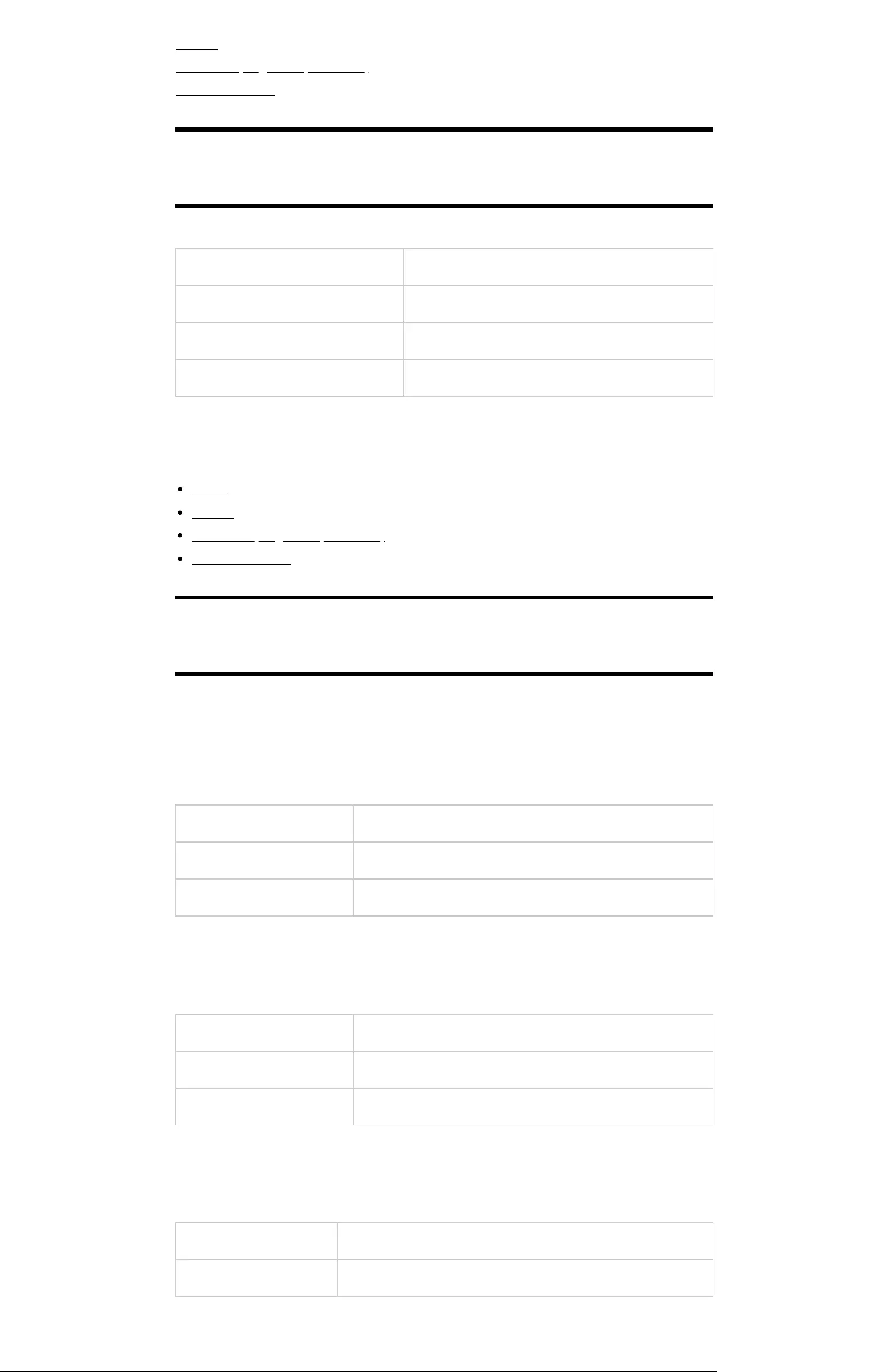
Videos
Audio sampling rates (for videos)
External subtitles
[53] Supported files and formats | Supported files and formats | Supported files and formats
Photos
Use case : USB / Home Network
File Format Extension
JPEG *.jpg / *.jpe / *.jpeg
HEIF *.heic / *.heif / *.hif
ARW *.arw
ARW is only to be used for playing back files.
Other supported files and formats
Music
Videos
Audio sampling rates (for videos)
External subtitles
[54] Supported files and formats | Supported files and formats | Supported files and formats
Music
Use case : USB / Home Network
mp4
Extension: *.mp4 / *.m4a
Description Sampling Rate
AAC-LC 16k / 22.05k / 24k / 32k / 44.1k / 48k
HE-AAC v1 / v2 24k / 32k / 44.1k / 48k
3gpp
Extension: *.3gp / *.3g2
Description Sampling Rate
AAC-LC 16k / 22.05k / 24k / 32k / 44.1k / 48k
HE-AAC v1 / v2 24k / 32k / 44.1k / 48k
Asf
Extension: *.wma
Description Sampling Rate
WMA9 Standard 8k / 11.025k / 16k / 22.05k / 32k / 44.1k / 48k
*1
*1

ogg
Extension: *.ogg
Description Sampling Rate
Vorbis 8k / 11.025k / 16k / 22.05k / 32k / 44.1k / 48k
Other
Description Sampling Rate
LPCM 32k / 44.1k / 48k
Extension: *.mp3
Description Sampling Rate
MP1L1 / MP1L2 / MP1L3 / MP2L1 / MP2L2 32k / 44.1k / 48k
MP2L3 16k / 22.05k / 24k
MP2.5L3 8k / 11.025k / 12k
Extension: *.wav
Description Sampling Rate
WAV 32k / 44.1k / 48k / 88.2k / 96k / 176.4k / 192k
Extension: *.flac
Description Sampling Rate
FLAC 16k / 22.05k / 32k / 44.1k / 48k / 88.2k / 96k / 176.4k / 192k
Extension: *.aac
Description Sampling Rate
AAC-LC 16k / 22.05k / 24k / 32k / 44.1k / 48k
HE-AAC v1 / v2 24k / 32k / 44.1k / 48k
The use case of LPCM is Home Network only.
The use case of WAV is 2ch only.
Other supported files and formats
Photos
Videos
Audio sampling rates (for videos)
External subtitles
[55] Supported files and formats | Supported files and formats | Supported files and formats
Videos
Use case : USB / Home Network
MPEG1 (*.mpg / *.mpe / *.mpeg)
Subtitle Type : External
*1
*2
*1
*2

Video Codec
(Profile@Level)
Audio
Codec
Max. / Min.
Resolution Max. Frame Rate
Video Codec
(Profile@Level)
Audio
Codec
Max. / Min.
Resolution Max. Frame Rate
MPEG1 MPEG1L2 1920x1080 /
QCIF (176x144)
1920x1080@30fps /
1280x720@60fps
MPEG2PS (*.mpg / *.mpe / *.mpeg)
Subtitle Type : External
Video Codec
(Profile@Level) Audio Codec Max. / Min.
Resolution Max. Frame Rate
MPEG2 MP@HL,
MP@H14L,
MP@ML
MPEG1L1 /
MPEG1L2 / LPCM
/ AC3
1920x1080 /
QCIF
(176x144)
1920x1080@30fps
/ 1280x720@60fps
MPEG2TS
Extension : *.m2t
Subtitle Type : External
Video Codec
(Profile@Level) Audio Codec Max. / Min.
Resolution Max. Frame Rate
MPEG2
MP@HL,
MP@H14L,
MP@ML
MPEG1L1 / MPEG1L2 /
AAC-LC / HE-AAC v1 /
HE-AAC v2 / AC3 / E-
AC3
1920x1080
/ QCIF
(176x144)
1920x1080@30fps
/ 1280x720@60fps
Extension : *.m2ts / *.mts
Subtitle Type : External
Video Codec
(Profile@Level) Audio Codec Max. / Min.
Resolution Max. Frame Rate
AVC / H.264
BP@L3,
MP@L4.2,
HP@L4.2
MPEG1L1 / MPEG1L2 /
AAC-LC / HE-AAC v1 /
HE-AAC v2 / AC3 / E-
AC3
1920x1080
/ QCIF
(176x144)
1920x1080@60fps
MP4 (*.mp4)
Subtitle Type : External
Video Codec
(Profile@Level) Audio Codec Max. / Min.
Resolution Max. Frame Rate
AVC / H.264
BP@L3,
MP@L4.2,
HP@L4.2
AAC-LC / HE-AAC v1 /
HE-AAC v2 / AC3 / E-
AC3 / AC4 / MPEG1L1
/ MPEG1L2
1920x1080
/ QCIF
(176x144)
1920x1080@120fps
MPEG4 SP@L6,
ASP@L5,
ACEP@L4
AAC-LC / HE-AAC v1 /
HE-AAC v2 / AC3 / E-
AC3 / MPEG1L1 /
MPEG1L2
1920x1080
/ QCIF
(176x144)
1920x1080@30fps /
1280x720@60fps

Video Codec
(Profile@Level) Audio Codec Max. / Min.
Resolution Max. Frame Rate
AVC / H.264
BP@L5.2,
MP@L5.2,
HP@L5.2
AAC-LC / HE-AAC v1 /
HE-AAC v2 / AC3 / E-
AC3 / AC4 / LPCM
3840x2160
/ QCIF
(176x144)
3840x2160@60p /
1920x1080@120fps
HEVC / H.265
MP@L5.1,
Main10@L5.1
AAC-LC / HE-AAC v1 /
HE-AAC v2 / AC3 / AC4
/ E-AC3
3840x2160
/ QCIF
(176x144)
3840x2160@60p /
1920x1080@120fps
This line includes the XAVC S format use case. The maximum supported bitrate for XAVC
S is 100 Mbps.
avi (*.avi)
Subtitle Type : External
Video Codec
(Profile@Level) Audio Codec Max. / Min.
Resolution Max. Frame Rate
Xvid MPEG1L1 / MPEG1L2 /
MPEG1L3 / AC3 / E-
AC3
1920x1080 /
QCIF
(176x144)
1920x1080@30fps
/ 1280x720@60fps
Motion JPEG μ-LAW / PCM (U8) /
PCM (S16LE)
1280x720 /
QCIF
(176x144)
1280x720@30fps
Asf (*.asf / *.wmv)
Subtitle Type : External
Video Codec
(Profile@Level)
Audio
Codec
Max. / Min.
Resolution Max. Frame Rate
VC1 AP@L3,
MP@HL, SP@ML
WMA9
Standard
1920x1080 / QCIF
(176x144)
1920x1080@30fps /
1280x720@60fps
MKV (*.mkv)
Subtitle Type : Internal / External
Video Codec
(Profile@Level) Audio Codec Max. / Min.
Resolution Max. Frame Rate
Xvid DTS core / AC3 / AAC-
LC / E-AC3 / HE-AAC
v1 / HE-AAC v2 /
MPEG1L1 / MPEG1L2 /
Vorbis
1920x1080
/ QCIF
(176x144)
1920x1080@30fps /
1280x720@60fps
AVC / H.264
BP@L3,
MP@L4.2,
HP@L4.2
DTS core / AC3 / AAC-
LC / E-AC3 / HE-AAC
v1 / HE-AAC v2 /
MPEG1L1 / MPEG1L2 /
Vorbis
1920x1080
/ QCIF
(176x144)
1920x1080@60fps
*1
*1

Video Codec
(Profile@Level) Audio Codec Max. / Min.
Resolution Max. Frame Rate
MPEG4
SP@L6,
ASP@L5,
ACEP@L4
DTS core / AC3 / AAC-
LC / E-AC3 / HE-AAC
v1 / HE-AAC v2 /
MPEG1L1 / MPEG1L2 /
Vorbis
1920x1080
/ QCIF
(176x144)
1920x1080@30fps /
1280x720@60fps
VP8 DTS core / AC3 / AAC-
LC / E-AC3 / HE-AAC
v1 / HE-AAC v2 /
MPEG1L1 / MPEG1L2 /
Vorbis
1920x1080
/ QCIF
(176x144)
1920x1080@30fps /
1280x720@60fps
VP9 Profile 0,
Profile 2
DTS core / AC3 / AAC-
LC / E-AC3 / HE-AAC
v1 / HE-AAC v2 /
MPEG1L1 / MPEG1L2 /
Vorbis
3840x2160
/ QCIF
(176x144)
3840x2160@60fps
AVC / H.264
BP@L5.2,
MP@L5.2,
HP@L5.2
DTS core / AC3 / AAC-
LC / E-AC3 / HE-AAC
v1 / HE-AAC v2
3840x2160
/ QCIF
(176x144)
3840x2160@60p /
1920x1080@120fps
HEVC / H.265
MP@L5.1,
Main10@L5.1
DTS core / AC3 / AAC-
LC / E-AC3 / HE-AAC
v1 / HE-AAC v2
3840x2160
/ QCIF
(176x144)
3840x2160@60p /
1920x1080@120fps
3gpp (*.3gp / *.3g2)
Subtitle Type : External
Video Codec
(Profile@Level) Audio Codec Max. / Min.
Resolution Max. Frame Rate
MPEG4
SP@L6,
ASP@L5,
ACEP@L4
AAC-LC / HE-AAC v1 /
HE-AAC v2 / AC3 / E-
AC3 / MPEG1L1 /
MPEG1L2
1920x1080
/ QCIF
(176x144)
1920x1080@30fps
/ 1280x720@60fps
AVC / H.264
BP@L3,
MP@L4.2,
HP@L4.2
AAC-LC / HE-AAC v1 /
HE-AAC v2 / AC3 / E-
AC3 / MPEG1L1 /
MPEG1L2
1920x1080
/ QCIF
(176x144)
1920x1080@60fps
MOV (*.mov)
Subtitle Type : External
Video Codec
(Profile@Level) Audio Codec Max. / Min.
Resolution Max. Frame Rate
AVC / H.264
BP@L3,
MP@L4.2,
HP@L4.2
AAC-LC / HE-AAC v1 /
HE-AAC v2 / AC3 / E-
AC3 / MPEG1L1 /
MPEG1L2 / μ-LAW / PCM
(U8) / PCM (S16BE) /
PCM (S16LE)
1920x1080
/ QCIF
(176x144)
1920x1080@60fps

Video Codec
(Profile@Level) Audio Codec Max. / Min.
Resolution Max. Frame Rate
MPEG4
SP@L6,
ASP@L5,
ACEP@L4
AAC-LC / HE-AAC v1 /
HE-AAC v2 / AC3 / E-
AC3 / MPEG1L1 /
MPEG1L2 / μ-LAW / PCM
(U8) / PCM (S16BE) /
PCM (S16LE)
1920x1080
/ QCIF
(176x144)
1920x1080@30fps
/ 1280x720@60fps
Motion JPEG AAC-LC / HE-AAC v1 /
HE-AAC v2 / AC3 / E-
AC3 / MPEG1L1 /
MPEG1L2 / μ-LAW / PCM
(U8) / PCM (S16BE) /
PCM (S16LE)
1280x720 /
QCIF
(176x144)
1280x720@30fps
WebM (*.webm)
Subtitle Type : External
Video Codec
(Profile@Level)
Audio
Codec
Max. / Min.
Resolution Max. Frame Rate
VP8 Vorbis 1920x1080 / QCIF
(176x144)
1920x1080@30fps /
1280x720@60fps
VP9 Profile 0,
Profile 2
Vorbis 3840x2160 / QCIF
(176x144)
3840x2160@60fps
Other supported files and formats
Photos
Music
Audio sampling rates (for videos)
External subtitles
[56] Supported files and formats | Supported files and formats | Supported files and formats
Audio sampling rates (for videos)
Audio Codec Sampling Rate
LPCM 44.1k / 48k
MPEG1L1 / MPEG1L2 32k / 44.1k / 48k
MPEG1L3 32k / 44.1k / 48k
AAC-LC 16k / 22.05k / 24k / 32k / 44.1k / 48k
HE-AAC v1 / v2 24k / 32k / 44.1k / 48k
AC3 32k / 44.1k / 48k
AC4 44.1k / 48k
E-AC3 32k / 44.1k / 48k
Vorbis 8k / 11.025k / 16k / 22.05k / 32k / 44.1k / 48k
WMA9 8k / 11.025k / 16k / 22.05k / 32k / 44.1k / 48k

Audio Codec Sampling Rate
DTS core 32k / 44.1k / 48k
μ-LAW 8k
PCM (U8) 8k
PCM (S16LE) 11.025k / 16k / 44.1k
PCM (S16BE) 11.025k / 16k / 44.1k
Other supported files and formats
Photos
Music
Videos
External subtitles
[57] Supported files and formats | Supported files and formats | Supported files and formats
External subtitles
Use case : USB
File Format Extension
SubStation Alpha *.ass / *.ssa
SubRip *.srt
Other supported files and formats
Photos
Music
Videos
Audio sampling rates (for videos)
[58] Using the TV with Other Devices
Blu-ray and DVD players
Connecting a Blu-ray or DVD player
Watching Blu-ray and DVD discs
[59] Blu-ray and DVD players | Blu-ray and DVD players
Connecting a Blu-ray or DVD player
Connect a Blu-ray/DVD player to the TV.
Use a connection method below based on the terminals available on your TV.
Note
The available terminals depend your model/region/country.
Hint
You can also connect a TV box in the same way as a Blu-ray/DVD player.
HDMI connection
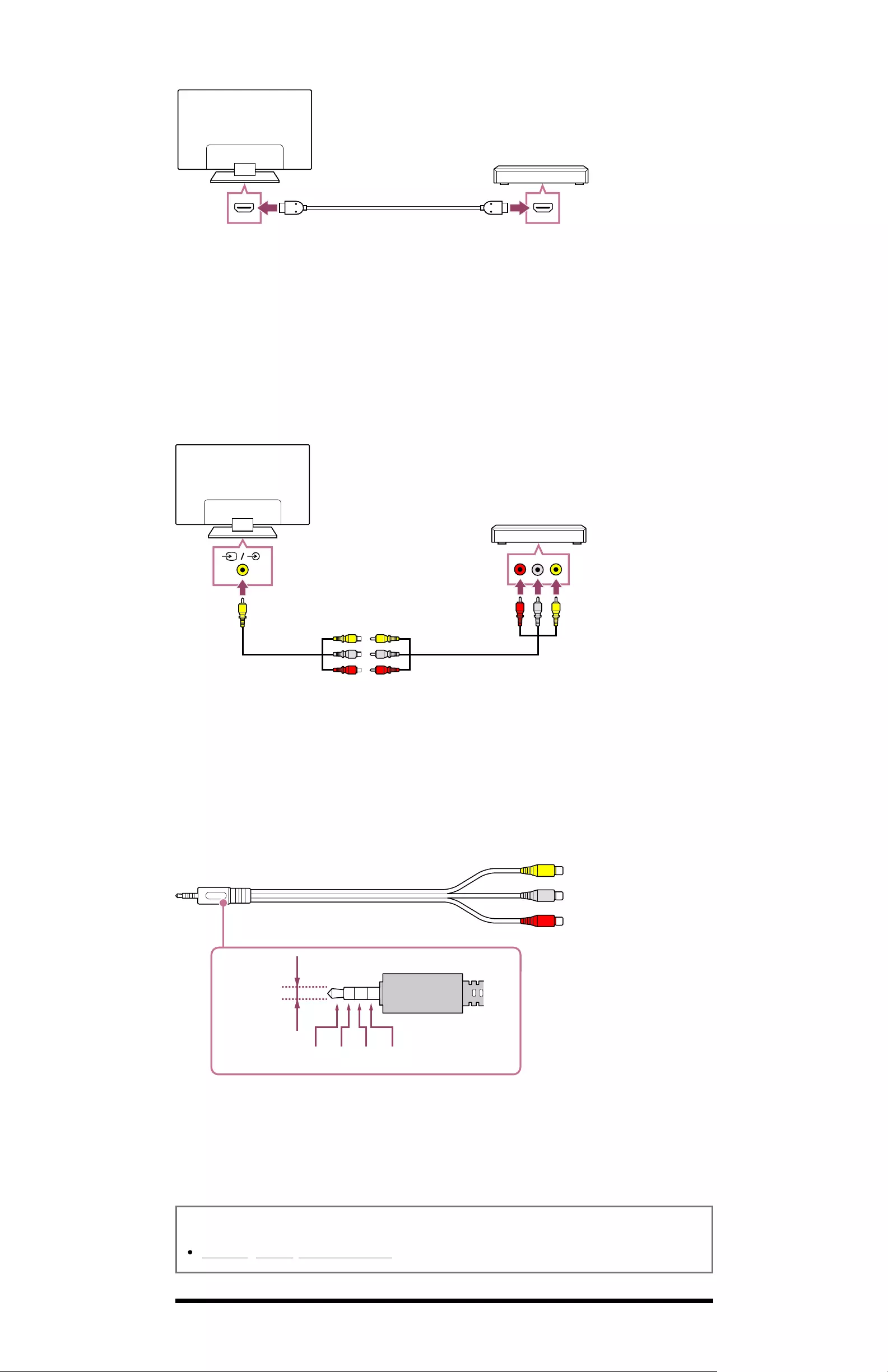
For optimum picture quality, we recommend connecting your player to the TV using an HDMI
cable. If your Blu-ray/DVD player has an HDMI jack (socket), connect it using an HDMI cable.
(B)
(A)
(A) Blu-ray/DVD player (same as connecting a TV box)
(B) HDMI cable (not supplied)
Be sure to use an authorised Premium High Speed HDMI Cable(s) bearing the HDMI
logo.
Composite connection
If your Blu-ray/DVD player has composite jacks (sockets), connect them using a composite
video/audio cable.
(A)
(B)
(C)
(A) Blu-ray/DVD player (same as connecting a TV box)
(B) Analogue Extension cable (supplied)
(C) RCA Cable (not supplied)
Whether the Analogue Extension cable is supplied depends on your model/region/country.
Cable that connects to the video input jack
The 3.5 mm jack of the Analogue Extension Cable has 4 poles.
(A)
(B) (C) (D) (E)
(A) 3.5 mm
(B) Left for Audio signal.
(C) Video signal.
(D) Ground.
(E) Right for Audio signal.
Related topics
Watching Blu-ray and DVD discs
[60] Blu-ray and DVD players | Blu-ray and DVD players
*
* ™
*
*

1
2
3
1
Watching Blu-ray and DVD discs
You can watch content from Blu-ray/DVD discs or other content supported by your player on
the TV.
Turn on the connected Blu-ray/DVD player.
Press the (Input select) button repeatedly to select the connected Blu-
ray/DVD player.
Start playback on the connected Blu-ray/DVD player.
Hint
If you connect a BRAVIA Sync-compatible device with an HDMI connection, you can
operate it by simply using the TV’s remote control.
Also, if you press the 123 (Control menu) button on the remote control while watching
content from the HDMI input, select [*** controls], you can operate the BRAVIA Sync-
connected device from the TV screen. If the supplied remote control has an (Input
select) button, press the (Input select) button while watching content from the HDMI
input, press the (Up) button, select [Control menu], and select [*** controls]. (You can
also display the operation menu by pressing the (Info/Text reveal) button on the
remote control.)
Related topics
Connecting a Blu-ray or DVD player
BRAVIA Sync-compatible devices
[61] Using the TV with Other Devices
TV box
Connecting a TV box
How to control the TV box using the TV remote control
[62] TV box | TV box
Connecting a TV box
Connect the TV box to the TV.
Connect it to the input on your TV.
For details, refer to the Connecting a Blu-ray or DVD player page.
[63] TV box | TV box
How to control the TV box using the TV remote
control
TV box control compatible models have [TV box setup] in [Settings] — [Channels & Inputs] —
[External inputs].
Performing [TV box control setup] in [TV box setup] allows you to control a TV box using the
TV’s remote control.
Press the (Quick Settings) button on the remote control, then select
[Settings] — [Channels & Inputs] — [External inputs] — [TV box setup] — [TV
box control setup].

2
1
2
3
4
1
2
3
Follow the on-screen instructions.
Note
When operating the TV’s remote control, point it at the TV box.
Depending on the external devices, some buttons may not respond.
If you press and hold a button on the remote control, the operation may not work.
Instead, try pressing the button repeatedly.
The availability of this function depends on your model/region/country.
Related topics
An external device (such as a TV box) cannot be controlled using the TV's remote
control. (TV box control compatible models only)
[64] Using the TV with Other Devices
Displaying the iPhone/smartphone or iPad/tablet
app screen on the TV
Chromecast built-in™ or AirPlay allows you to display (cast) your favourite websites and app
screens on your mobile device directly to the TV.
Using Chromecast built-in
Connect a mobile device such as a smartphone or tablet to the same home
network that the TV is connected to.
Launch a Chromecast built-in supported app on the mobile device.
Select the (cast) icon in the app.
Select the TV as the cast destination.
The screen of the mobile device is displayed on the TV.
Note
An Internet connection is required to use Chromecast built-in.
Using AirPlay
This TV supports AirPlay 2.
Make sure your Apple device is connected to the same network as your TV.
The procedure depends on the content that will be displayed on the TV as
follows.
To display video, tap (AirPlay Video).
To display photos, tap (Action share).
To play music, tap (AirPlay Audio).
To display the screen of a mobile device, tap (Mirroring).
(In some apps, you may have to tap another icon first.)
Select AirPlay on a mobile device such as an iPhone or iPad, and select the
TV to use with AirPlay.
Hint
The TV supports Apple HomeKit.
You can control the TV with a mobile device such as an iPhone or iPad by pressing the
(Input select) button on the remote control, selecting (AirPlay), and following the
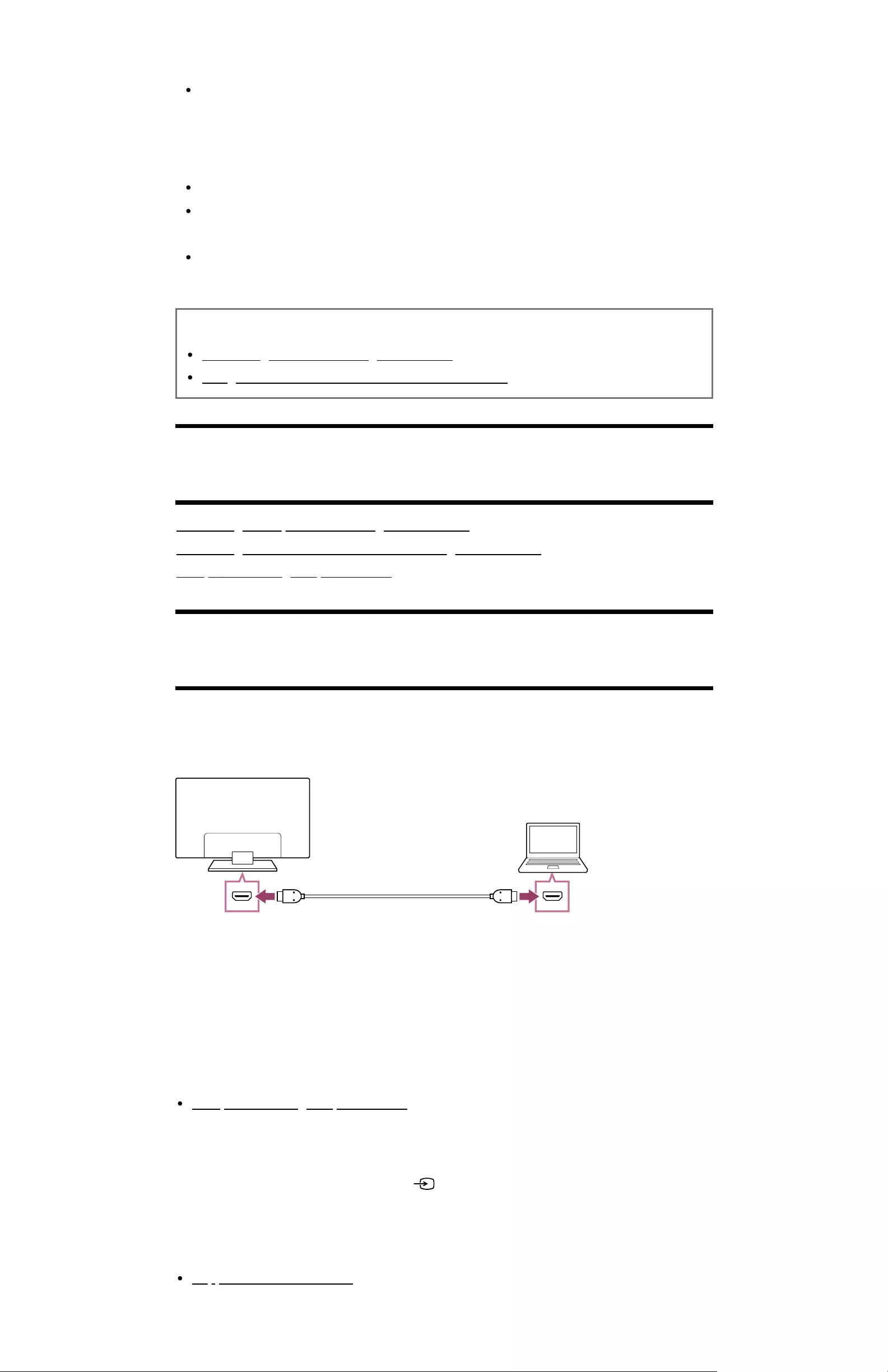
on-screen instructions to setup Apple HomeKit.
Available operations vary depending on the version of the app and software.
If you select [On (Powered on by apps)] in [Remote start], you can turn on the TV with
apps on a mobile device such as an iPhone or iPad.
Note
An internet connection is required to use AirPlay.
Operation of a mobile device such as iPhone or iPad varies depending on the OS
version.
iPhone, iPad, AirPlay and HomeKit are trademarks of Apple Inc., registered in the U.S.
and other countries.
Related topics
Connecting to a network using a LAN cable
Using Wi-Fi to connect the TV to the Internet/Network
[65] Using the TV with Other Devices
Computers, cameras, and camcorders
Connecting a computer and viewing stored content
Connecting a camera or camcorder and viewing stored content
Computer video signal specifications
[66] Computers, cameras, and camcorders | Computers, cameras, and camcorders
Connecting a computer and viewing stored content
To connect a computer
Use an HDMI cable to connect your computer to the TV.
(B)
(A)
(A) Computer
(B) HDMI cable (not supplied)
Be sure to use an authorised Premium High Speed HDMI Cable(s) bearing the HDMI
logo. We recommend an Ultra High Speed HDMI Cable when connecting to a computer
that supports 4K 120Hz.
To check the video signal specifications
Computer video signal specifications
To view content stored on a computer
After connecting the computer, press the (Input select) button, then select the input the
computer is connected to.
To check the supported file formats
Supported files and formats
Note
*
* ™
™
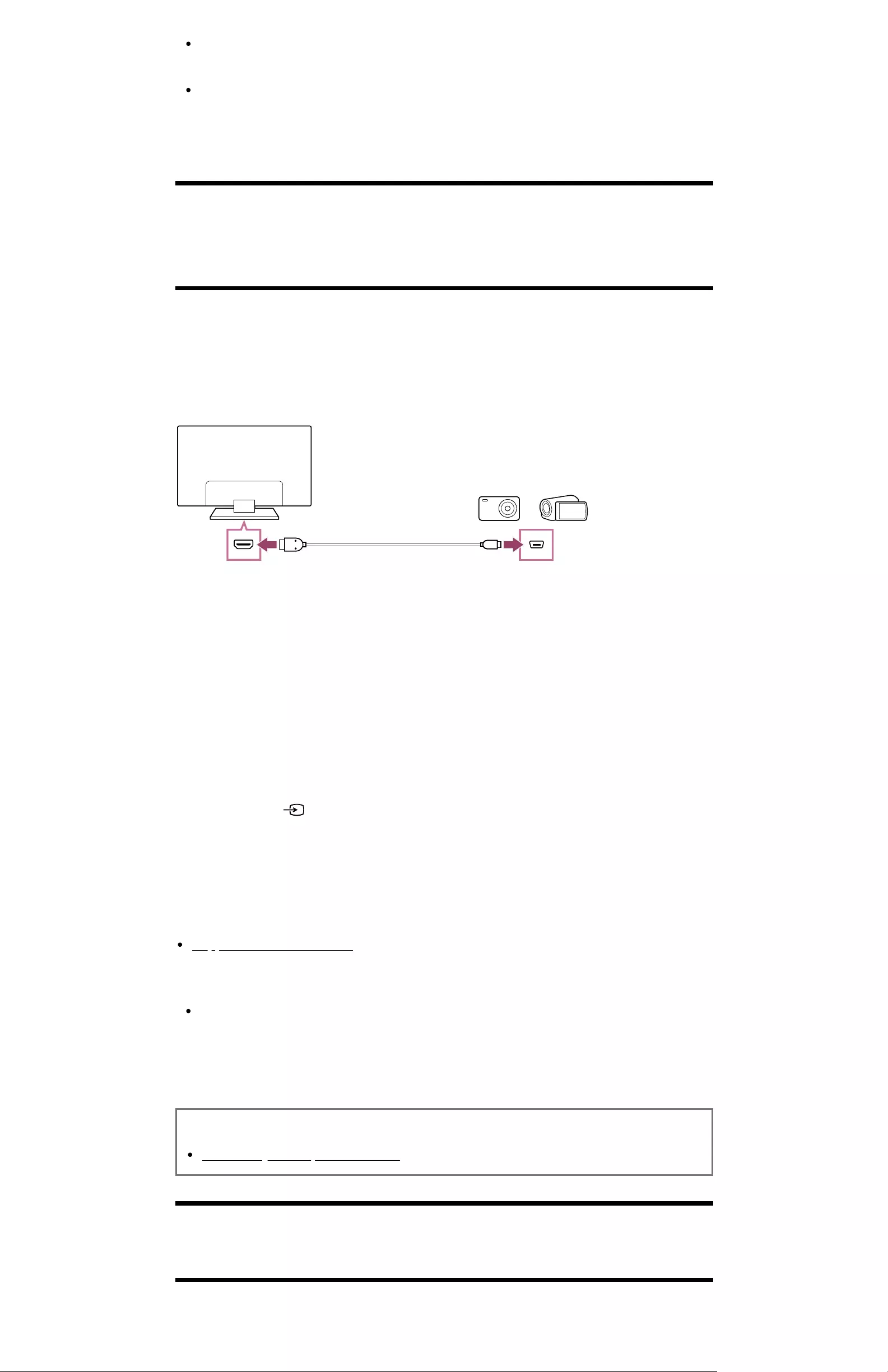
1
2
3
For optimum picture quality, we recommend that you set your computer to output video
signals according to one of the timings listed in “Computer video signal specifications”.
Depending on the connection status, the image may be blurred or smeared. In this
case, change the computer’s settings and select another input signal from the
“Computer video signal specifications” list.
[67] Computers, cameras, and camcorders | Computers, cameras, and camcorders
Connecting a camera or camcorder and viewing
stored content
To connect a camera or camcorder
Connect your Sony digital still camera or camcorder using an HDMI cable. Use a cable that
has an HDMI mini jack (socket) for the digital still camera/camcorder end, and a standard
HDMI jack (socket) for the TV end.
(C)
(A) (B)
(A) Digital still camera
(B) Camcorder
(C) HDMI cable (not supplied)
Be sure to use an authorised Premium High Speed HDMI Cable(s) bearing the HDMI
logo.
To view content stored on a digital still camera/camcorder
After connecting the digital still camera/camcorder, turn it on.
Press the (Input select) button repeatedly to select the connected digital
still camera/camcorder.
Start playback on the connected digital still camera/camcorder.
To check the supported file formats
Supported files and formats
Hint
If you connect a BRAVIA Sync-compatible device, you can operate it by simply using
the TV’s remote control. Make sure that the device is BRAVIA Sync-compatible. Some
devices may not be compatible with BRAVIA Sync even though they have an HDMI jack
(socket).
Related topics
BRAVIA Sync-compatible devices
[68] Computers, cameras, and camcorders | Computers, cameras, and camcorders
Computer video signal specifications
(Resolution, Horizontal frequency/Vertical frequency)
*
* ™

640 x 480, 31.5 kHz/60 Hz
800 x 600, 37.9 kHz/60 Hz
1024 x 768, 48.4 kHz/60 Hz
1152 x 864, 67.5 kHz/75 Hz
1280 x 1024, 64.0 kHz/60 Hz
1600 x 900, 56.0 kHz/60 Hz
1680 x 1050, 65.3 kHz/60 Hz
1920 x 1080, 67.5 kHz/60 Hz
3840 x 2160, 67.5 kHz/30 Hz
3840 x 2160, 135.0 kHz/60 Hz (8 bits)
1920 x 1080 timing, when applied to the HDMI input, will be treated as a video timing and
not computer timing. This will affect the [Screen] settings in [Display & Sound]. To view
computer content, set [Wide mode] to [Full], and [Display area] to [+1]. ([Display area] is
configurable only when [Auto display area] is disabled.)
Note
The picture may be blurry and may not be displayed correctly depending on your
connection status. In this case, change the computer’s settings and select a different
input signal in “Supported computer input signals”.
[69] Using the TV with Other Devices
Audio system (such as an AV receiver or sound
bar)
Outputting audio from an audio system
Connecting an audio system
Adjusting an audio system
Using the TV as a centre speaker (only models with TV centre speaker mode)
Pass-through audio formats supported with eARC
[70] Audio system (such as an AV receiver or sound bar) | Audio system (such as an AV
receiver or sound bar)
Outputting audio from an audio system
You can connect audio systems such as AV receivers or sound bars to the TV. Select a
connection method below according to the specifications of the audio system you want to
connect.
Connecting with an HDMI cable (For details, carefully read “Connection using an HDMI
cable” below.)
Connecting with a digital optical cable
For connection methods, refer to the Connecting an audio system page.
Note
Refer to the instruction manual of the device to be connected.
Connection using an HDMI cable
This TV supports Audio Return Channel (ARC) or Enhanced Audio Return Channel (eARC).
You can use an HDMI cable to output audio from audio systems that support ARC and eARC.
On TVs that support eARC, you can output (pass-through) audio signals from external input
devices connected to the TV to eARC supported audio systems by using the HDMI terminal
bearing the text “eARC/ARC”.
*
*
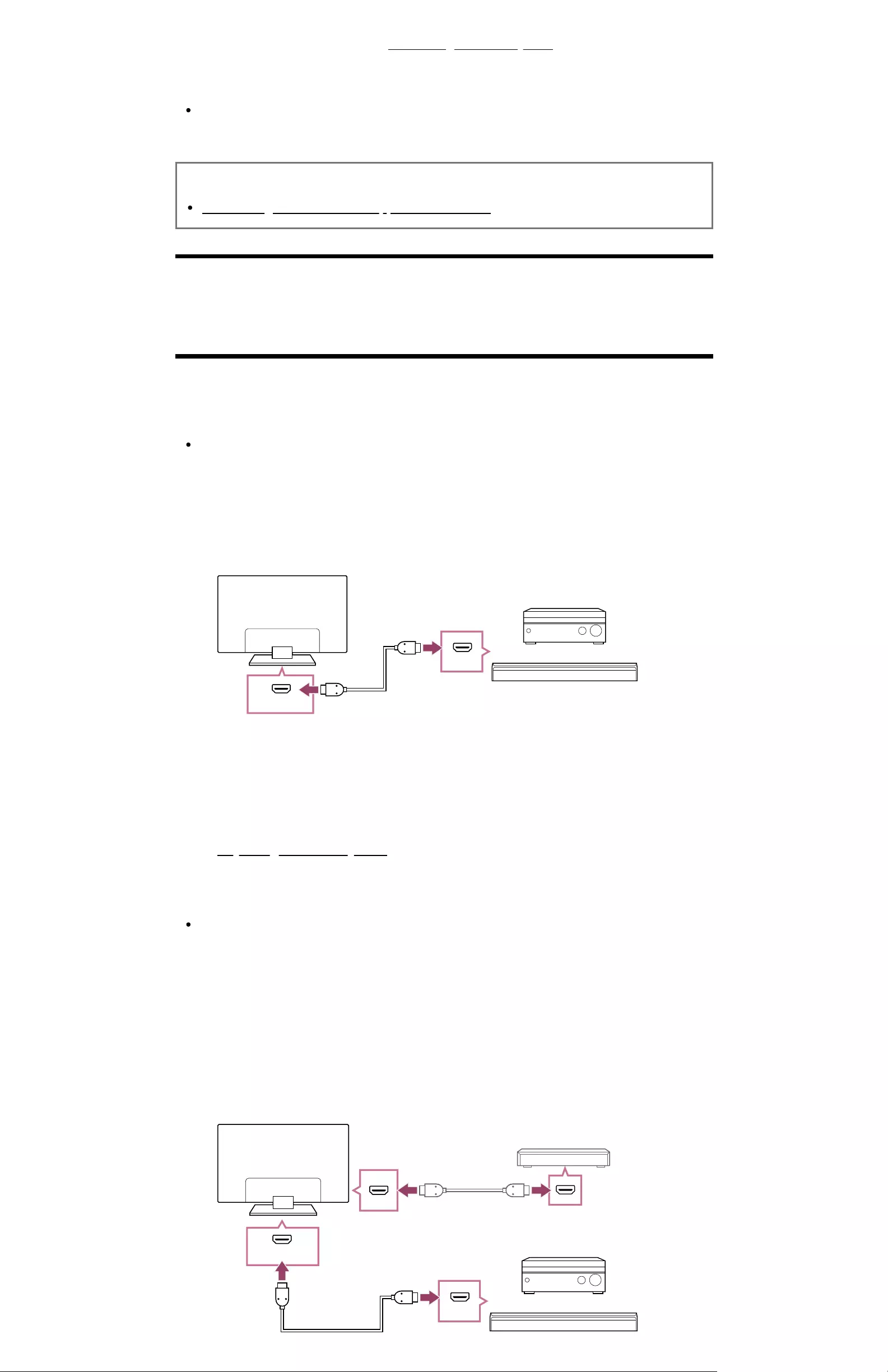
1
2
1
For connection methods, refer to the Connecting an audio system page.
Note
The location of the HDMI terminal that supports eARC/ARC varies depending on the
model. Refer to the included Setup Guide.
Related topics
Pass-through audio formats supported with eARC
[71] Audio system (such as an AV receiver or sound bar) | Audio system (such as an AV
receiver or sound bar)
Connecting an audio system
See the illustrations below to connect an audio system such as an AV receiver or sound bar.
Note
The available terminals depend your model/region/country.
HDMI connection (ARC supported)
Connect the TV and audio system with an HDMI cable.
Connect to the TV’s HDMI input terminal bearing the text “ARC” or “eARC/ARC”.
(B)
(eARC/ARC)
(ARC)
(A)
(A) AV receiver or sound bar
(B) HDMI cable (not supplied)
We recommend authorised Premium High Speed HDMI Cable(s) bearing the
HDMI logo.
Adjusting an audio system
Note
For ARC connections, voice recognition performance may degrade (only TVs with a
built-in MIC).
HDMI connection (eARC supported)
Connect the external input device and TV with an HDMI cable. Connect the TV
and audio system with another HDMI cable.
Connect the audio system to the TV’s HDMI input terminal bearing the text “ARC” or
“eARC/ARC”.
(eARC)
(D)
(B)
(C)
(eARC/ARC)
(A)
*
* ™
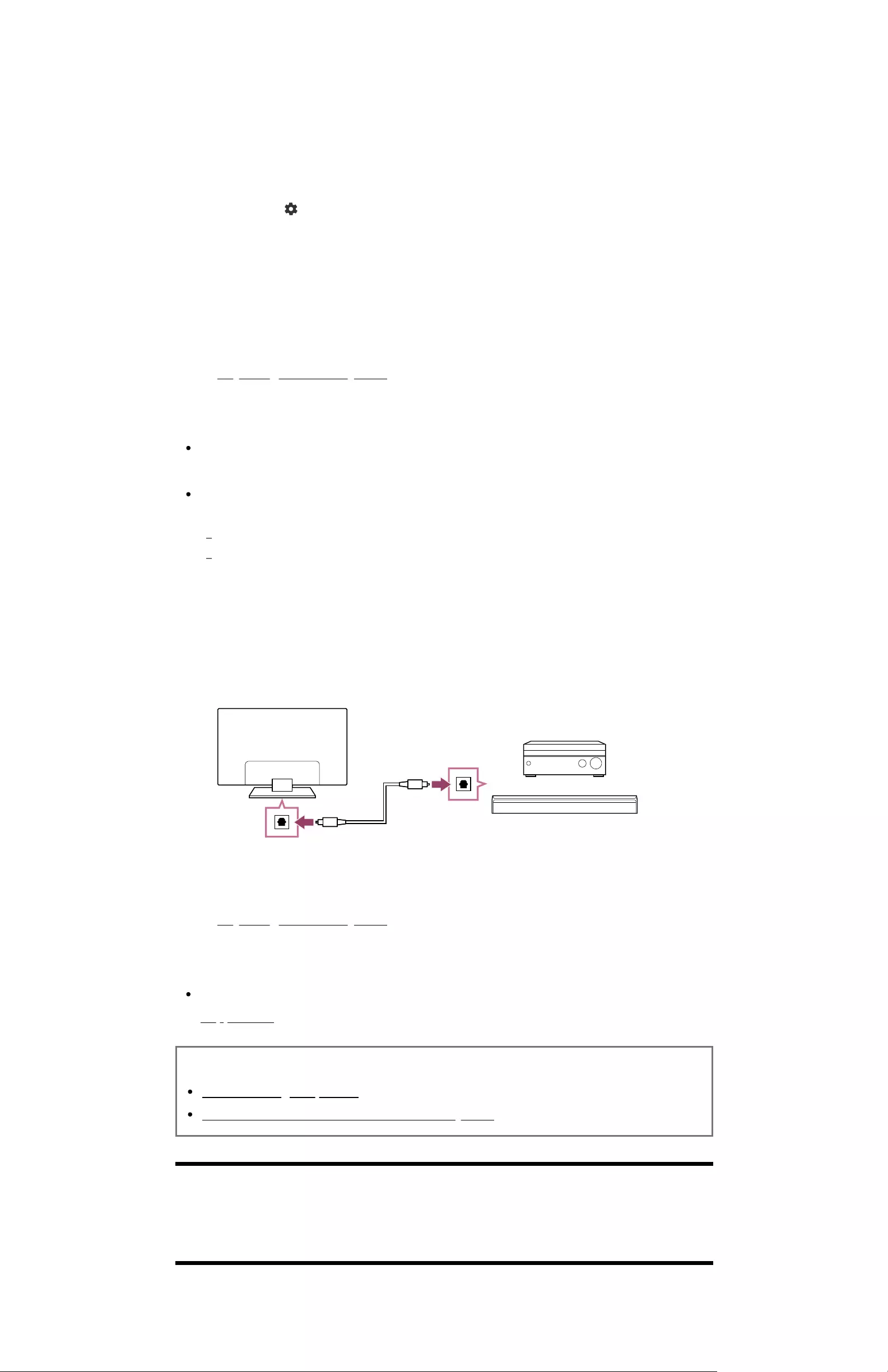
2
3
4
5
1
2
(A) External input device (such as a Blu-ray/DVD recorder)
(B) HDMI cable (not supplied)
(C) AV receiver or sound bar
(D) HDMI cable with Ethernet (not supplied)
We recommend authorised Premium High Speed HDMI Cable(s) bearing the
HDMI logo.
Press the (Quick Settings) button on the remote control, then select
[Settings] — [Display & Sound] — [Audio output] — [eARC mode] — [Auto].
Select [Speakers] — [Audio system].
Enable the audio system’s eARC feature.
Refer to the instruction manual of the device.
Adjusting an audio system
Note
You cannot select [eARC mode] if the text-to-speech function for on-screen text within
the TV’s accessibility features is enabled.
If audio is being output from an eARC supported device while you are watching HDMI
input, the TV operates as follows:
audio from system sounds and audio responses is not output, and
the voice recognition performance of the built-in MIC may degrade (only TVs with a built-in
MIC).
Digital optical cable connection
Connect the TV and audio system with a digital optical cable.
Connect to the audio system’s digital optical input terminal.
(B)
(A)
(A) AV receiver or Sound bar
(B) Optical audio cable (not supplied)
Adjusting an audio system
Hint
For more information, please visit the Sony support website.
Support Site
Related topics
No sound but good picture.
No audio or low audio with a home theatre system.
[72] Audio system (such as an AV receiver or sound bar) | Audio system (such as an AV
receiver or sound bar)
Adjusting an audio system
After connecting an audio system to the TV, adjust the TV’s audio output from the audio
system.
*
* ™

1
2
1
Adjusting an audio system connected with an HDMI cable or
digital optical cable
After connecting the TV to your audio system, press the (Quick Settings)
button on the remote control, then select [Settings] — [Display & Sound] —
[Audio output] — [Speakers] — [Audio system].
Turn on the connected audio system, then adjust the volume.
If you connect a BRAVIA Sync-compatible device with an HDMI connection, you can
operate it by simply using the TV’s remote control.
Note
You need to configure the [Digital audio out] settings according to your audio system.
Press the (Quick Settings) button on the remote control, then select [Settings] —
[Display & Sound] — [Audio output] — [Digital audio out].
If the audio system is not compatible with Dolby Digital or DTS, set [Settings] —
[Display & Sound] — [Audio output] — [Digital audio out] to [PCM].
The [Digital audio out] settings are disabled when using audio signals that are passed
through from the HDMI input and using eARC.
Hint
If a specific audio system is connected with an HDMI cable, you can adjust the output
timing of the picture and sound.
Adjusting the AV sync setting
For details about supported models, refer to the support site.
Support Site
Related topics
BRAVIA Sync-compatible devices
Connecting an audio system
No sound but good picture.
No audio or low audio with a home theatre system.
[73] Audio system (such as an AV receiver or sound bar) | Audio system (such as an AV
receiver or sound bar)
Using the TV as a centre speaker (only models with
TV centre speaker mode)
Models with a TV centre speaker mode have CENTER SPEAKER IN terminals or S-
CENTER SPEAKER IN terminals on the back of the TV.
On TVs with S-CENTER SPEAKER IN input, you can use the TV as a centre speaker in the
following cases.
When a sound bar with an S-CENTER OUT output/jack is connected
By using the TV as a centre speaker, conversations sound natural because you can hear
them from the screen and its vicinity.
Hint
Some models have both CENTER SPEAKER IN and S-CENTER SPEAKER IN
terminals.
Connect the device to the TV while referring to “Connecting an AV receiver
with a speaker cable” or “Connecting a sound bar (only models with S-
CENTER SPEAKER IN terminals)” below.
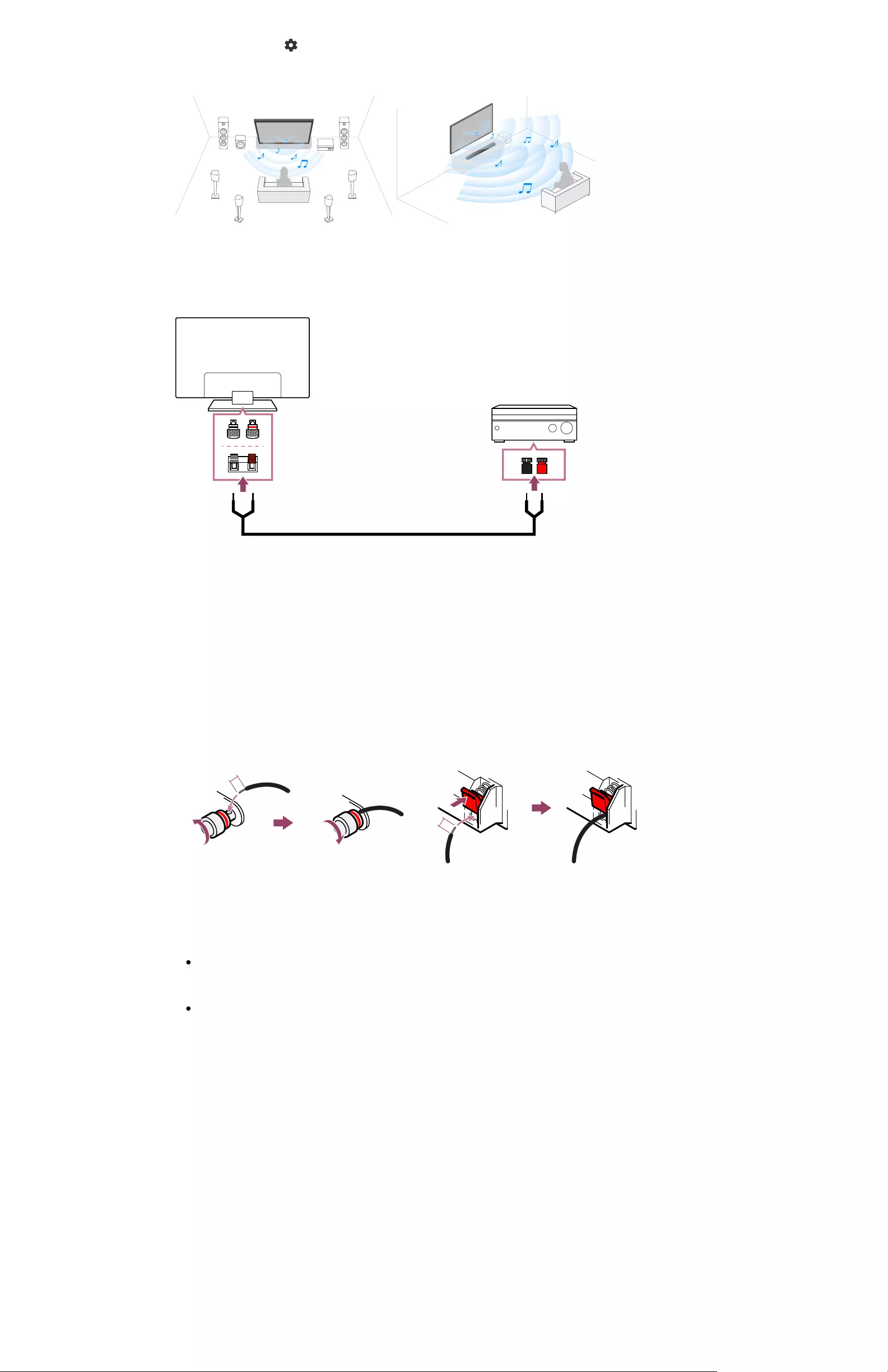
2Press the (Quick Settings) button on the remote control, change [Settings]
— [Display & Sound] — [Audio output] — [Speakers] to [Audio system].
Connecting an AV receiver with a speaker cable
Connect the TV and AV receiver with a speaker cable.
(A)
(B)
(A) AV receiver
(B) Speaker cable (not supplied)
Use a speaker cable (not supplied) to connect the AV receiver to the CENTER SPEAKER IN
terminal of the TV.
When connecting, make sure to twist the ends of the speaker cable and insert them into the
connection terminals of the TV and AV receiver.
The CENTER SPEAKER IN terminal varies depending on the model. Refer to the figures
below when connecting the speaker cable.
*
*
*Strip about 10 mm (13/32 inches) of insulation from the speaker cable at each end.
Note
To prevent the wires of the speaker cable from touching each other, make sure not to
strip too much of the speaker cable.
Connect the speaker cable properly so that the polarities (+/-) between the TV and AV
receiver match.
Connecting a sound bar (only models with S-CENTER
SPEAKER IN terminals)
Connect the TV and sound bar with the TV centre speaker mode cable supplied with sound
bar/home theatre system.
When a sound bar is connected, centre audio is output from both the TV and sound bar,
allowing you to enjoy both impactful sound from the sound bar and natural conversations.
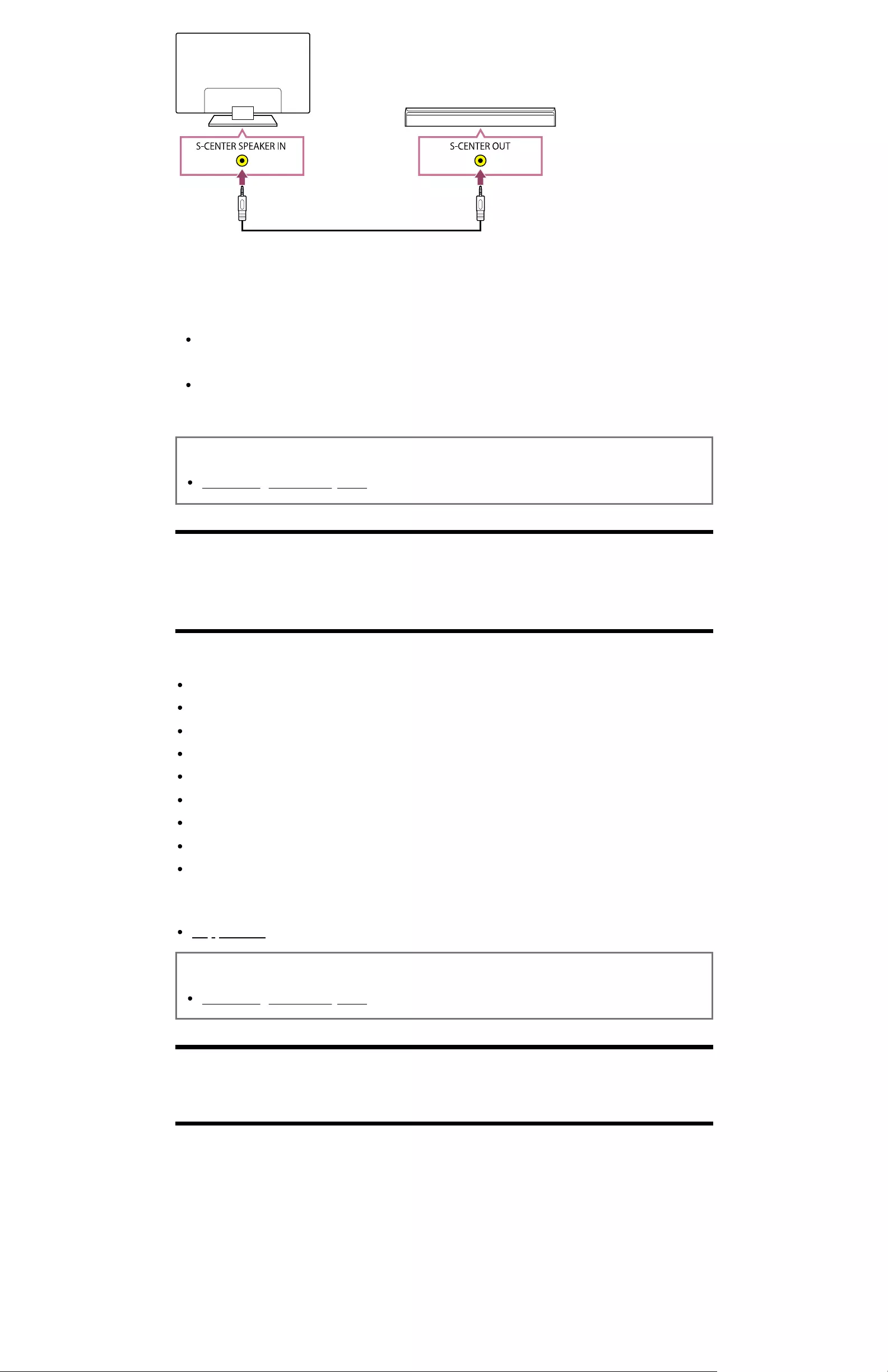
(A)
(A) TV centre speaker mode cable (supplied with sound bars that have S-CENTER OUT
terminals)
Note
Even when connecting a sound bar with an S-CENTER OUT terminal, it must be
connected to the TV with an HDMI cable like a normal sound bar.
Also refer to the instruction manual of the audio system with an S-CENTER OUT
terminal.
Related topics
Connecting an audio system
[74] Audio system (such as an AV receiver or sound bar) | Audio system (such as an AV
receiver or sound bar)
Pass-through audio formats supported with eARC
Confirm that you can pass-through the following audio formats.
7.1 channel linear PCM: 32/44.1/48 kHz 16 bits
Dolby Digital
Dolby Digital Plus
DTS
Dolby TrueHD
DTS-HD MA
Dolby Atmos
DTS:X Master Audio
MPEG2 - AAC/MPEG4 - AAC
For details, refer to the support page.
Support Site
Related topics
Connecting an audio system
[75] Using the TV with Other Devices
Video game consoles
Connecting
Connect an HDMI-supported video game console to your TV with an HDMI cable.

1
1
(B)
(A)
(A) Video game console
(B) HDMI cable (sold separately)
Hint
A Premium High Speed HDMI Cable(s) is fine for general purposes, but if you will
connect a video game console that supports 4K 120Hz, use the HDMI cable included
with the game console, or an Ultra High Speed HDMI Cable.
The type and position of the HDMI port differs depending on your TV. Refer to the
provide documentation included with the TV.
Changing HDMI input settings
After connecting, set the connected HDMI input port.
To maximise the performance of your TV and video game console, set the [HDMI signal
format].
Auto setup
With the video game console turned on, connect it to the TV with an HDMI
cable.
Set by following the instructions on the TV screen.
Manual setup
Press the (Quick Settings) button on the remote control, and select the
following in order.
[Settings] — [Channels & Inputs] — [External inputs] — [HDMI signal format]
Select the optimal format for your video game console.
Hint
If you connect a video game console that supports 4K 120 Hz video output, set to
[Enhanced format (4K120, 8K)].
If you connect a video game console that supports VRR, set to [Enhanced format
(VRR)].
Note
When connecting a video game console that supports 4K 120Hz and VRR, check the
label of the HDMI input ports on the TV and connect to the HDMI input port that is
labelled 4K 120Hz or 4K 120Hz 8K, or connect to the HDMI input port that is displayed
as [Enhanced format (4K120, 8K)] or [Enhanced format (VRR)] for HDMI signal format].
The available [HDMI signal format] depend on the model. They may also not be
supported depending on the model/region/country.
If [Enhanced format (VRR)] is set, slight brightness fluctuations (flicker) may occur on
the TV screen depending on the frequency of the content output from the connected
video game console.
Related topics
Connecting terminal
™
™

1
2
3
1
2
3
[76] Using the TV with Other Devices
Experiencing 3D surround with a neckband speaker
or headphones (BRAVIA XR models only)
If you connect the transmitter to the TV, you can use a neckband speaker or Sony brand
headphones to experience 3D surround (spatial sound).
For details, refer to the URL below.
https://www.sony.net/bravia-xr-3ds
The locations of the optical digital audio output jack and USB port varies depending on the
model. Refer to the Setup Guide.
[77] Using the TV with Other Devices
Bluetooth devices
Connecting a Bluetooth device
Adjusting the AV sync setting
Supported Bluetooth profiles
[78] Bluetooth devices | Bluetooth devices
Connecting a Bluetooth device
To pair the TV with a Bluetooth device
Only for Bluetooth A2DP-supported models that can use Bluetooth audio devices such as
headphones or speakers.
Bluetooth A2DP-supported models that support Bluetooth audio devices have [A/V sync] in
[Settings] — [Display & Sound] — [Audio output].
Turn the Bluetooth device on and put it in pairing mode.
To put your Bluetooth device in pairing mode, refer to the instruction manual
of the device.
Press the (Quick Settings) button on the remote control, then select
[Settings] — [Remotes & Accessories] — [Pair accessory] to put the TV in
pairing mode.
Available Bluetooth devices will be displayed.
Select the desired device, then follow the on-screen instructions.
If you are prompted to enter a passcode, refer to the instruction manual of the
device.
After pairing is completed, the device connects to the TV.
To connect to a paired Bluetooth device
Press the (Quick Settings) button on the remote control, then select
[Settings] — [Remotes & Accessories].
Select a paired but unconnected device.
Select [Connect].
Related topics
Supported Bluetooth profiles
Operation cuts out, or a device does not work.

1
You want to output sound from the headphones/Bluetooth audio device and audio
system/TV speakers at the same time.
[79] Bluetooth devices | Bluetooth devices
Adjusting the AV sync setting
If a Bluetooth audio device is connected, there may be a delay between the picture and
sound due to the properties of Bluetooth. You can adjust the delay between the picture and
sound with the A/V sync setting. (Only for Bluetooth A2DP-supported models that can use
Bluetooth audio devices.)
Bluetooth A2DP-supported models that support Bluetooth audio devices have [A/V sync] in
[Settings] — [Display & Sound] — [Audio output].
Press the (Quick Settings) button on the remote control, then select
[Settings] — [Display & Sound] — [Audio output] — [A/V sync] — the desired
option.
Hint
You can also adjust the output timing of the picture and sound if a specific audio system
is connected with an HDMI cable. For details about supported models, refer to the
support site.
Support Site
Note
Depending on the connected Bluetooth audio device, the picture and sound may not
match even when the [A/V sync] setting is set to [On] or [Auto].
To prevent the TV from displaying a black screen immediately after turning it on when a
sound bar is connected wirelessly (Bluetooth), set the [A/V sync] setting to [On].
If [Picture mode] is set to one of the options below, the output timing of the picture and
sound is not adjusted even when the [A/V sync] setting is set to [Auto].
[Game]
[Graphics]
[Photo]
To adjust [A/V sync] when in any of these modes, select [On].
The responsiveness of the TV while playing video games may feel slower due to the
[A/V sync] setting adding a delay to the output timing of the picture. For games that are
dependant on response time, we do not recommend you use a Bluetooth device and
recommend that you use the TV speakers or a sound bar with a wired
(HDMI cable/digital optical cable) connection instead.
[80] Bluetooth devices | Bluetooth devices
Supported Bluetooth profiles
The TV supports the following profiles:
HID (Human Interface Device Profile)
HOGP (HID over GATT Profile)
A2DP (Advanced Audio Distribution Profile)
AVRCP (Audio/Video Remote Control Profile)
SPP (Serial Port Profile)
Related topics
Connecting a Bluetooth device

[81] Using the TV with Other Devices
BRAVIA Sync-compatible devices
BRAVIA Sync overview
Using features available for BRAVIA Sync-compatible devices
Adjusting BRAVIA Sync settings
[82] BRAVIA Sync-compatible devices | BRAVIA Sync-compatible devices
BRAVIA Sync overview
If a BRAVIA Sync-compatible device (e.g., Blu-ray player, AV receiver) is connected with an
HDMI cable, you can operate the device with the TV’s remote control.
Related topics
Using features available for BRAVIA Sync-compatible devices
Adjusting BRAVIA Sync settings
[83] BRAVIA Sync-compatible devices | BRAVIA Sync-compatible devices
Using features available for BRAVIA Sync-
compatible devices
To operate BRAVIA Sync-compatible devices from the TV, use the (Input select) button
on the remote control to select the device you want to operate.
Blu-ray/DVD player
Automatically turns the TV on and switches the input to the connected Blu-ray/DVD player
when the Blu-ray/DVD player starts to play.
Automatically turns the connected Blu-ray/DVD player off when you turn the TV off.
Allows operations such as menu operation and playback with the (Up) / (Down) /
(Left) / (Right) buttons on the TV remote control.
AV receiver
Automatically turns the connected AV receiver on and switches the sound output from the
TV speaker to the audio system when you turn the TV on. This function is only available if
you have previously used the AV receiver to output the TV’s sound.
Automatically switches the sound output to the AV receiver by turning the AV receiver on
when the TV is turned on.
Automatically turns the connected AV receiver off when you turn the TV off.
Adjusts the volume ( (Volume) +/- buttons) and mutes the sound ( (Mute) button) of
the connected AV receiver through the TV’s remote control.
Video camera
Automatically turns the TV on and switches the input to the connected video camera when
the camera is turned on.
Automatically turns the connected video camera off when you turn the TV off.

1
2
3
Allows operations such as menu operation and playback with the (Up) / (Down) /
(Left) / (Right) buttons on the TV remote control.
Note
“BRAVIA Sync control” (BRAVIA Sync) is only available for connected BRAVIA Sync-
compatible devices that have the BRAVIA Sync logo.
Related topics
BRAVIA Sync overview
Adjusting BRAVIA Sync settings
[84] BRAVIA Sync-compatible devices | BRAVIA Sync-compatible devices
Adjusting BRAVIA Sync settings
When BRAVIA Sync is set up, you will be able to turn off a connected device with the TV or
set a device connected via HDMI cable to be operated with the TV’s remote control.
Turn on the connected device.
To enable [BRAVIA Sync control], press the (Quick Settings) button on the
remote control, then select [Settings] — [Channels & Inputs] — [External
inputs] — [BRAVIA Sync settings] — [BRAVIA Sync control].
Activate BRAVIA Sync on the connected device.
When a specific Sony BRAVIA Sync-compatible device is connected and
powered on and [BRAVIA Sync control] is enabled, BRAVIA Sync is
automatically activated on that device. For details, refer to the instruction
manual of the connected device.
Available options
Available options are shown below. (Options vary depending on your model/region/country.)
[Auto devices off]
If disabled, the connected device does not turn off automatically when the TV is turned off.
[Auto TV on]
If disabled, the TV does not turn on automatically when the connected device is turned on.
[BRAVIA Sync device list]
Displays the BRAVIA Sync device list.
[Device control keys]
Allows you to set buttons to control an HDMI connected device.
Related topics
BRAVIA Sync overview
Using features available for BRAVIA Sync-compatible devices
[85] Using the TV with Other Devices
Viewing pictures in 4K from compatible devices
Viewing pictures in 4K resolution
Settings for viewing pictures through HDMI input with higher quality

1
2
3
4
1
2
3
4
[86] Viewing pictures in 4K from compatible devices | Viewing pictures in 4K from
compatible devices
Viewing pictures in 4K resolution
You can connect a digital still camera/camcorder that supports HDMI 4K output to HDMI IN of
the TV to display high resolution photos stored on the camera. You can also display high
resolution photos stored in connected USB devices or your home network. A picture with a
4K or higher resolution can be displayed in 4K resolution (3840×2160).
The availability of this function depends on your region/country.
(A) (B) (C) (D)
(A) Digital still camera
(B) Camcorder
(C) USB device
(D) Network device
To view pictures stored on a USB device or network device in 4K resolution
Connect the USB device or network device to the TV.
Press the HOME/ (HOME) button, and select Apps from the Home menu,
then select [Media Player].
If the supplied remote control has an APPS button, you can press the APPS button.
Select the USB device name or network device name.
Select the folder, and then select the file to play.
To view pictures stored on a digital still camera/camcorder
Connect a digital still camera or camcorder that supports HDMI output to the
HDMI IN jack (socket) of the TV, using an HDMI cable.
Press the (Input select) button repeatedly to select the connected device.
Set the connected device to 4K output.
Start playback on the connected device.
To check the supported file formats
Supported files and formats
To view pictures in 4K resolution with higher quality
You can set the HDMI signal format to Enhanced format to view pictures in 4K resolution with
higher quality.
For information about Enhanced format or changing the settings, refer to the Settings for
viewing pictures through HDMI input with higher quality page.
Note
A 3D picture cannot be displayed.
If you change the picture by pressing the (Left) / (Right) buttons, it may take a
moment for the picture to be displayed.
Related topics

Computers, cameras, and camcorders
USB devices
Connecting to a Network
[87] Viewing pictures in 4K from compatible devices | Viewing pictures in 4K from
compatible devices
Settings for viewing pictures through HDMI input
with higher quality
To display a picture from a device connected to the HDMI input terminal in a higher quality
HDMI format , set [HDMI signal format] in [External inputs].
Such as 8K, 4K 100/120 Hz, 4K 60p 4:2:0 10 bit, 4K 60p 4:4:4, or 4:2:2
HDMI signal format
To change the HDMI signal format setting, press the (Quick Settings) button on the remote
control, then select [Settings] — [Channels & Inputs] — [External inputs] — [HDMI signal
format] — the HDMI input you want to set.
Follow the on-screen instructions, and set the HDMI signal format from the HDMI input
terminal to a suitable format below. Available HDMI signal formats depend on your model and
HDMI input.
Standard format
Enhanced format
Enhanced format (Dolby Vision)
Enhanced format (4K120, 8K)
Enhanced format (VRR)
Note
Support for the display of 4K 100/120 Hz and 8K picture depends on your
model/region/country.
Support for the Variable Refresh Rate (VRR) feature depends on your model.
When using Enhanced format, picture and sound may not be output correctly. In this
case, connect the device to an HDMI IN that is in [Standard format], or change the HDMI
signal format of HDMI IN to [Standard format].
Only set to Enhanced format when using compatible devices.
When you watch 4K picture with High-Quality, use a Premium High Speed HDMI
Cable(s) that supports speeds of 18 Gbps. For details on a Premium High Speed
HDMI Cable(s) that supports 18 Gbps, refer to the cable specifications.
To display 4K 100/120 Hz or 8K picture, an Ultra High Speed HDMI Cable that
supports 48 Gbps is required. Refer to the cable specifications to find out whether a
cable supports 48 Gbps.
Related topics
Viewing pictures in 4K resolution
[88] Using the TV with Other Devices
BRAVIA Connectivity Guide
Descriptions about connecting devices to the TV are also available on the Sony support
website. Refer to it as necessary.
https://www.sony.net/tv_connectivity_guide/
*1
*1
™
™
™

1
[89]
Connecting to a Network
Connecting to a network
Home network features
Viewing Internet content
[90] Connecting to a Network
Connecting to a network
Connecting to a network using a LAN cable
Connecting to a network using a wireless connection
[91] Connecting to a network | Connecting to a network
Connecting to a network using a LAN cable
Connecting to a network using a LAN cable
A wired LAN connection allows you to access the Internet and your home network.
Make sure to connect to the Internet or home network via a router.
(A)
(C) (D)
(E)
(B)
(A) LAN cable
(B) Computer
(C) Router
(D) Modem
(E) Internet
Set up your LAN router.
For details, refer to the instruction manual of your LAN router, or contact the person
who set up the network (network administrator).
Note
It is strongly recommended for security purposes to connect your TV to the Internet via a
router/modem that includes router functionality. Direct connection of your TV to the
Internet may expose your TV to a security threat such as extraction or tampering of
content or personal information.
Contact your service provider or network administrator to confirm your network includes
router functionality.
The network-related settings that are required may vary depending on the Internet
service provider or router. For details, refer to the instruction manuals provided by the
Internet service provider or those supplied with the router. You can also contact the
person who set up the network (network administrator).
Related topics
The TV cannot connect to the Internet/Network.
Using Wi-Fi to connect the TV to the Internet/Network
Home network features

1
2
3
1
[92] Connecting to a network | Connecting to a network
Connecting to a network using a wireless
connection
Using Wi-Fi to connect the TV to the Internet/Network
Using Wi-Fi Direct to connect to the TV (no wireless router required)
[93] Connecting to a network using a wireless connection | Connecting to a network using a
wireless connection | Connecting to a network using a wireless connection
Using Wi-Fi to connect the TV to the
Internet/Network
The built-in wireless LAN device allows you to access the Internet and enjoy the benefits of
networking in a cable-free environment.
(D)
(C)(B)
(A)
(A) Computer
(B) Wireless router
(C) Modem
(D) Internet
Set up your wireless router.
For details, refer to the instruction manual of your wireless router, or contact the
person who set up the network (network administrator).
Press the (Quick Settings) button on the remote control, then select
[Settings] — [Network & Internet].
Select a network you want to connect to and set the password.
If your TV can not connect to the Internet/Network, refer to The TV cannot connect to
the Internet/Network. page.
To turn off the built-in wireless LAN
To disable [Wi-Fi], press the (Quick Settings) button on the remote control,
then select [Settings] — [Network & Internet] — [Wi-Fi].
Hint
For smooth video streaming:
Change the setting of your wireless router to a high-speed networking standard such as
802.11n if possible.
For details on how to change the setting, refer to the instruction manual of your wireless
router, or contact the person who set up the network (network administrator).
If the above procedure does not deliver any improvement, change the setting of your
wireless router to 5GHz, which may help improve the video streaming quality.
The 5GHz band may not be supported depending on your region/country. If the 5GHz band
is not supported, the TV can only connect to a wireless router using the 2.4GHz band.
Note

1
2
3
4
It is strongly recommended for security purposes to connect your TV to the Internet via a
router/modem that includes router functionality. Direct connection of your TV to the
Internet may expose your TV to a security threat such as extraction or tampering of
content or personal information.
Contact your service provider or network administrator to confirm your network includes
router functionality.
The network-related settings that are required may vary depending on the Internet
service provider or router. For details, refer to the instruction manuals provided by the
Internet service provider or those supplied with the router. You can also contact the
person who set up the network (network administrator).
If you select the [Show password] option in the password entry screen, the exposed
password may be seen by other individuals.
Related topics
Network (Internet/home)/apps
The TV cannot connect to the Internet/Network.
Connecting to a network using a LAN cable
Using Wi-Fi Direct to connect to the TV (no wireless router required)
Home network features
[94] Connecting to a network using a wireless connection | Connecting to a network using a
wireless connection | Connecting to a network using a wireless connection
Using Wi-Fi Direct to connect to the TV (no wireless
router required)
You can connect a device to the TV wirelessly, without using a wireless router, and then
stream videos, photos, and music that is stored on your device directly to the TV.
Note
Wi-Fi Direct connects smartphones and computers directly to the TV instead of through
the Internet, so streaming video content that requires an Internet connection cannot be
played back on the TV.
Press the (Quick Settings) button on the remote control, then select
[Settings] — [Network & Internet] — [Wi‑Fi Direct] — [Wi‑Fi Direct settings].
Select the TV name displayed on the TV screen with the Wi-Fi Direct device.
If the device does not support Wi-Fi Direct, select the [Show Network
(SSID)/Password].
Operate the Wi-Fi Direct/Wi-Fi device to connect with the TV.
Send content from the Wi-Fi Direct/Wi-Fi device to the TV.
For details, refer to the instruction manual of the device.
If connection is not successful

When the standby screen for the Wi-Fi Direct setting is displayed, select [Show Network
(SSID)/Password] and follow the on-screen instructions to complete the set-up.
To connect another device
Follow the steps above to connect devices. Up to 10 devices can be connected at the same
time. To connect another device when 10 devices are already connected, disconnect an
unnecessary device, then connect the other device.
To change the name of the TV shown on the connected device
Press the (Quick Settings) button on the remote control, then select [Settings] — [System]
— [About] — [Device name].
To list connected devices/deregister devices
Press the (Quick Settings) button on the remote control, then select [Settings] — [Network
& Internet] — [Wi‑Fi Direct] — [Show device list/Delete].
To deregister a device, select the device in the list to delete, then press the (Enter) button.
Then, select [Yes] on the confirmation screen.
To deregister all devices, select [Delete all] in the list, then [Yes] in the confirmation display.
[95] Connecting to a Network
Home network features
Adjusting home network settings
Playing content from a computer
Playing content from a media server
[96] Home network features | Home network features
Adjusting home network settings
You can adjust the following home network settings.
To check the server connection
Press the (Quick Settings) button on the remote control, then select [Settings] — [Network
& Internet] — [Home network setup] — [Server diagnostics] — follow the on-screen
instructions to perform diagnostics.
To use the renderer function
Press the (Quick Settings) button on the remote control, then select [Settings] — [Network
& Internet] — [Home network setup] — [Renderer] — the desired option.
[Renderer function]
Enable the renderer function.
You can play photo/music/video files in a controller (e.g., digital still camera) on the TV
screen by operating the device directly.
[Renderer access control]
Select [Automatic access permission] to access the TV automatically when a controller
accesses the TV for the first time.
Select [Custom settings] to change the access permission settings of each controller.
To use the remote device
Press the (Quick Settings) button on the remote control, then select [Settings] — [Network
& Internet] — [Remote device settings] — the desired option.

1
2
3
4
[Control remotely]
Enable operation of the TV from a registered device.
[Deregister remote device]
Deregister a device to disable operation of the TV from that device.
[97] Home network features | Home network features
Playing content from a computer
You can enjoy content (photo/music/video files) stored on a network device located in another
room, if you connect the TV to a home network via a router.
(B)
(A)
(D)
(C)
(A) Computer (Server)
(B) Router
(C) Modem
(D) Internet
Connect the TV to your home network.
Press the HOME/ (HOME) button, and select Apps from the Home menu,
then select [Media Player].
If the supplied remote control has an APPS button, you can press the APPS button.
Select the network device name.
Select the folder, and then select the file to play.
To check the supported file formats
Supported files and formats
Note
Depending on the file, playback may not be possible even when using the supported
formats.
Related topics
Adjusting home network settings
[98] Home network features | Home network features
Playing content from a media server
You can play photo/music/video files in a controller (e.g., digital still camera) on the TV screen
by operating the controller directly, if you connect the TV to a home network via a router. The
controller should also be renderer-compatible.
(B)
(A)
(D)
(C)
(A) Digital still camera (Controller)
(B) Router

1
2
(C) Modem
(D) Internet
Connect the TV to your home network.
Operate the controller to start playing the content on the TV screen.
Related topics
Adjusting home network settings
[99] Connecting to a Network
Viewing Internet content
You can use video streaming services such as YouTube™ and Netflix to watch Internet
content. The available services vary depending on your country and region. You can launch
these services by selecting their apps in the Home Menu. If a Google Account is set on the
TV, you can also select content that is displayed in the Home Menu.
Note
An Internet connection is required to watch Internet content.
Video streaming services such as Netflix and Amazon Prime are paid services.
Supported video streaming services depend on the model/region/country, and some
models/regions/countries do not support such services.
Hint
Even if a Google Account is not setup on the TV, you can still see videos from, for
example, YouTube displayed on the Home Menu, as long as the TV is connected to the
Internet. To install new apps such as those for video streaming services, you must
setup/add a Google Account on the TV.
Related topics
Installing apps
Accounts & Sign-In
Enjoying safe apps and video streaming services (Security and restrictions)
Connecting to a network using a LAN cable
Using Wi-Fi to connect the TV to the Internet/Network
Home menu
[100]
Settings
The menus displayed in the TV settings vary depending on your model/region/country.
Using the Quick Settings
Channels & Inputs Channels, External inputs and Recording device setup, etc.
Display & Sound Picture, Screen, Sound and Audio output, etc.
Network & Internet
Accounts & Sign-In Configure the Google Account or add other accounts.
Privacy You can restrict installation of apps from unknown sources.
Apps
System Date and time, Language, Sound, Accessibility, Parental controlsand LED indicator,
etc.
Remotes & Accessories Remote control and Bluetooth settings.
Help & feedback Provides help from Sony and Google.

1
2
1
2
3
4
1
Timers & Clock On timer, Sleep timer, Alarm, Clock display, etc.
[101] Settings
Using the Quick Settings
If you press the (Quick Settings) button on the remote control, you can quickly access
features such as [Picture mode], [Sleep timer], and [Picture Off] on the current screen, and
settings such as [Audio output] depending on the connected devices. You can also display
[Settings] from [Quick Settings].
Note
The menus displayed in the TV settings vary depending on your model/region/country.
Press the (Quick Settings) button on the remote control.
Move the focus to change a setting or select it.
To change the settings that are displayed
Press the (Quick Settings) button on the remote control.
Move the focus left or right, and select (Edit).
Select the desired setting.
Select [Close].
Hint
To change the order or hide a displayed item, press and hold the (Enter) button on
the remote control with that item highlighted, and [Move] and [Hide] will be displayed. If
you select [Move], use (Left) / (Right) on the remote control to move the item to
the desired position, and then press the (Enter) button on the remote control.
With [BRAVIA notifications] in Quick Settings, you can check if there are notifications
such as software updates and low battery levels in the remote control.
[102] Settings
Channels & Inputs
Press the (Quick Settings) button on the remote control, then select
[Settings] — [Channels & Inputs] — the desired option.
Available options
[Channels]
Configures the settings related to receiving broadcast programming. You can also
configure the settings related to receiving satellite broadcast programming.
To tune digital channels
Receiving digital broadcasts
To tune your satellite

1
Receiving satellite broadcasts
To sort channels or edit the channel list
Sorting or editing the channels
[Preferences (Channels)]
Configures [Subtitle settings] and [Audio settings (Broadcast)].
[Info banner]
Display programme information when channel is changed.
[External inputs]
Configures the settings of the external inputs and BRAVIA Sync.
For details about BRAVIA Sync, refer to BRAVIA Sync-compatible devices.
[Recording device setup]
Configures the settings of USB HDD devices for recording. (This option may not be
available depending on your model/region/country.)
[TV button shortcut]
If an external input such as a connected tuner is set, it will be displayed when the TV button
on the remote control is pressed.
[103] Settings
Display & Sound
Press the (Quick Settings) button on the remote control, then select
[Settings] — [Display & Sound] — the desired option.
Available options
[Picture]
Configures display settings that adjust the picture quality, such as screen brightness.
To adjust the picture quality to your preferences, refer to the Adjusting the picture quality
page.
[Screen]
Adjusts the screen size and position.
[Sound]
Configures settings that adjust the sound.
To adjust the sound quality to your preferences, refer to the Adjusting the sound quality
page.
[Audio output]
Configures selection settings related to speakers.
[Expert panel settings](only models equipped with an OLED panel)
Use when setting [Pixel shift] or manually performing [Panel refresh].
For details, refer to OLED panel (only models equipped with an OLED panel).
[104] Settings
Network & Internet
Configures settings for such things as wireless LANs, wired LANs, and home networks.
Related topics
Connecting to a Network

1
1
[105] Settings
Accounts & Sign-In
Press the (Quick Settings) button on the remote control, then select
[Settings] — [Accounts & Sign-In] — the desired option.
Available options
When a Google Account is set on the TV
Configure the Google Account or add other accounts.
When a Google Account is not set on the TV
[Accounts & Sign-In] cannot be used. To set a Google Account, set up Google TV from the
settings menu.
[106] Settings
Privacy
You can restrict the installation of apps from unknown sources.
[107] Settings
Apps
Allows you to configure or uninstall apps, or clear the cache.
Related topics
Installing apps
[108] Settings
System
Press the (Quick Settings) button on the remote control, then select
[Settings] — [System] — the desired option.
Note
Depending on the settings of the TV, some options may not be displayed or available.
Available options
[Accessibility]
Configures the settings of accessibility features and services for helping users navigate
their devices more easily.
[About]
Displays information about the TV.
Here, you can reset your TV
[Date and time]
Configures the current time and auto clock display.
[Language]
Selects the menu language. The selected menu language will also set the voice
recognition language.

1
[Keyboard]
Configures the settings of the on-screen keyboard.
[Storage]
Changes the settings related to data storage.
[Ambient mode]
Configures what is displayed on the screen when the TV is not operated after a certain
amount of time while displaying content other than broadcasts and videos.
[Power and energy]
Configures the settings related to saving energy and the startup TV screen.
[Cast]
Configures the operation permissions when casting from an external device.
[Restart]
Restarts the TV.
[Parental controls]
Configures the parental lock settings for restricting usage of items such as [Channels &
External inputs], [Apps] and [Screen time].
[LED indicator]
Configures the [Operational response] and [Voice detection status] settings. (The
displayed menu varies depending on the model.)
[Sound]
Configures the [System sounds] setting.
[Apple AirPlay & HomeKit]
Configures the settings for Apple AirPlay & HomeKit.
[Initial setup]
Sets up the basic features such as network and channels for first time use.
[Retail mode settings]
Enriches the display for shop front use by setting [Demo mode], etc.
Only TVs with a built-in MIC
[109] Settings
Remotes & Accessories
Press the (Quick Settings) button on the remote control, then select
[Settings] — [Remotes & Accessories] — the desired option.
Available options
You can enable or disable Bluetooth, or register Bluetooth devices.
[Bluetooth]
Enables or disables Bluetooth.
[Pair accessory]
Pairs Bluetooth devices.
[Remote control]
Setup for pairing the Voice Remote Control.
Related topics
Bluetooth devices
Remote control
*
*

1
2
3
1
Using the remote control microphone
[110] Settings
Help & feedback
Help from Sony can be displayed here. If a Google Account is set on the TV, you can also
give Google feedback.
[111] Settings
Timers & Clock
In Timers & Clock, you can set the On timer, Sleep timer, Alarm, and Clock display.
Adding Timers & Clock to the input selection screen
Press the (Input select) button.
Available devices and apps are displayed at the bottom of the screen.
Press the (Right) button on the remote control and select (Edit).
Select Timers & Clock and press the Enter button.
Timers & Clock is added.
To configure settings for Timers & Clock
Press the (Input select) button on the remote control and select the
following.
(Timers & Clock icon) — the desired setting
Available options
[On timer]
Turns on the TV to the desired channel or input at a preset time.
[Sleep timer]
Turns off the TV after a preset time.
[Alarm]
Plays a sound after a preset time.
[Clock display]
Displays the clock on the TV screen always or at every hour.
Related topics
Selecting inputs
[112]
Troubleshooting
Start here Experiencing trouble? Start here.
Picture (quality)/screen
Keyboard
Broadcast reception
Sound
Network (Internet/home)/apps

1
2
1
2
Remote control/accessories
Power
Connected devices
USB HDD recording
LED
[113] Troubleshooting
Start here
Self diagnostics
Software updates
If a full reset (restart) of the TV is required
Frequently Asked Questions for Troubleshooting
[114] Start here | Start here
Self diagnostics
Check if the TV is working properly.
Press (Input select) on the remote control and select [Help]. If [Help] does
not exist, select [Edit] and add [Help].
Select [Status & Diagnostics] — [Self diagnostics].
Hint
You can also check the following symptoms in [Status & Diagnostics].
[Internet connection diagnostics]
[External device connection diagnostics]
[Picture/Sound test]
If the problem persists, try the following.
Reset (restart) the TV. For details, refer to If a full reset (restart) of the TV is required.
Check and try Software updates.
Support Site
[115] Start here | Start here
Software updates
Sony will provide software updates from time to time in order to enhance functionality and
provide users with the latest TV experience. The easiest way to receive software updates is
via an internet connection to the TV.
To check for software updates automatically
Press (Input select) on the remote control and select [Help]. If [Help] does
not exist, select [Edit] and add [Help].
Enable [Automatically check for update] in [Status & Diagnostics] — [System
software update].
Hint
To update the software manually, select [Software update].

1
2
You can check the BRAVIA notifications or support website for a list of changes made
by the software update.
Note
When [Automatically check for update] is disabled, the TV cannot receive notifications
even when a software update is available.
Updating software via USB storage device
If you do not have a network connection, you can also update the software by using a USB
storage device. Use your computer to download the latest software from the Sony support
website onto a USB storage device. Insert the USB storage device to a USB port on the TV
and the software update will start automatically.
If you will update the TV software by using a USB storage device, you should read the
cautions for update by USB storage device on the website.
For more about the support site, please see the Support Site page.
Related topics
Connecting to a Network
[116] Start here | Start here
If a full reset (restart) of the TV is required
If you have trouble such as the picture not displaying on the screen or the remote control not
working, reset the TV with the following procedure. If the problem persists, try the factory reset
procedure below.
If an external USB device is connected to the TV, disconnect the USB device from the TV
before resetting.
Power Reset
Restart the TV with the remote control.
Press and continue holding the power button on the remote control for about 5
seconds until the TV restarts (a shutting down message will appear).
If the issue persists, unplug the TV and press the power button on the TV once.
Then wait 2 minutes before turning on the TV. Depending on the model, you can press
and hold the power button on the TV (40 seconds or longer) until it turns off and
restarts.
Unplug the AC power cord (mains lead).
If the problem persists after step 1, unplug the TV power cord (mains lead) from the
electrical outlet. Then press the power button on the TV, and release it. Wait for 2
minutes, and plug the power cord (mains lead) back into the electrical outlet.
Hint
TV models with 1 button on the TV (power button only) can also be restarted using the
power button. Press the power button on the TV to display the operation menu, select
[Restart] in the menu, and then press and hold the power button to restart the TV.
Your personal settings and data will not be lost after the TV restarts.
Factory data reset
If the problem persists after a power reset, try a factory data reset.
Note

1
2
Performing a factory reset will delete all of the TV’s data and settings (such as Wi-Fi and
wired network setting information, Google Account and other login information, Google
Play and other installed apps).
Press the (Quick Settings) button on the remote control, then select
[Settings] — [System] — [About] — [Reset] — [Factory data reset].
Delete everything.
If you have set a PIN code on your TV, you will be prompted to input it.
After the factory reset process completes successfully, the TV will start the Initial Setup
wizard. You must agree to the Google Terms of Service and Google Privacy Policy.
[117] Start here | Start here
Frequently Asked Questions for Troubleshooting
For troubleshooting information, you can also refer to “Frequently Asked Questions” in our
support site below.
http://www.sony.net/androidtv-faq/
[118] Troubleshooting
Picture (quality)/screen
No colour/Dark picture/Colour is not correct/Picture is too bright.
Distorted picture./The screen flickers.
High resolution HDR pictures are not displayed.
OLED panel (only models equipped with an OLED panel)
[119] Picture (quality)/screen | Picture (quality)/screen
No colour/Dark picture/Colour is not correct/Picture
is too bright.
Check the antenna (aerial)/cable connection.
Connect the TV to the AC power (mains), and press the power button on the TV or the
remote control.
Press the (Quick Settings) button on the remote control, and select [Settings] —
[Display & Sound] — [Picture] to make adjustments.
For details, refer to Adjusting the picture quality page.
Press the button on the remote control, and check [Brightness] and [Power saving] on
the Quick Settings screen.
You cannot set [Brightness] when [Power saving] is set to [High]. Change the [Power
saving] setting.
Note
Picture quality depends on the signal and content.
The picture quality may improve if you change it in [Picture] under [Settings].
Press the (Quick Settings) button on the remote control, and select [Settings] —
[Display & Sound] — [Picture] — [Brightness], and adjust [Brightness] or [Contrast].
Related topics
Display & Sound

[120] Picture (quality)/screen | Picture (quality)/screen
Distorted picture./The screen flickers.
Check the connection and position of the antenna (aerial) and
peripheral devices
Check the antenna (aerial)/cable connection.
Keep the antenna (aerial)/cable away from other connecting cables.
When installing an optional device, leave some space between the device and the TV.
Make sure that the antenna (aerial) is connected using a high quality 75-ohm coaxial
cable.
Check the [Motion] setting
Press the (Quick Settings) button on the remote control, and select [Settings] —
[Display & Sound] — [Picture] — [Motion] — [Motionflow] — [Off].
Change the current setting of [Film mode] to [Off].
Press the (Quick Settings) button on the remote control, and select [Settings] —
[Display & Sound] — [Picture] — [Motion] — [Film mode].
Check the [Analogue] settings.
Press the (Quick Settings) button on the remote control, then select [Settings] —
[Channels & Inputs] — [Channels] — [Channel setup] — [Manual tuning] — [Analogue].
Disable [LNA] to improve picture reception. ([LNA] may not be available depending on your
situation/region/country.)
Perform [AFT] to improve picture for analogue reception.
(Availability of [Analogue] and its options may vary depending on the region/country/situation.)
[121] Picture (quality)/screen | Picture (quality)/screen
High resolution HDR pictures are not displayed.
The following are required to watch high resolution HDR pictures such as 4K (50p/60p) .
Connect the 4K (50p/60p) playable device.
Use a Premium High Speed HDMI Cable(s) that supports 18 Gbps.
Set [HDMI signal format] to [Enhanced format] by selecting [Settings] — [Channels &
Inputs] — [External inputs] — [HDMI signal format] — the HDMI terminal you want to set.
Check whether the connected device has the latest settings or firmware.
Availability depends on your model/region/country.
[122] Picture (quality)/screen | Picture (quality)/screen
OLED panel (only models equipped with an OLED
panel)
The screen becomes darker after a certain period of time. (only models equipped with an
OLED panel)
The message [Panel refresh did not finish] is displayed. (only models equipped with an
OLED panel)
You are concerned about an image retention. (only models equipped with an OLED panel)
A white line, or a red, green, or blue line appears on the screen. (only some models
equipped with an OLED panel)
[123] OLED panel (only models equipped with an OLED panel) | OLED panel (only models
equipped with an OLED panel) | OLED panel (only models equipped with an OLED panel)
*
*
™
*

1
The screen becomes darker after a certain period of
time. (only models equipped with an OLED panel)
If the whole image or part of the image remains still, the screen will gradually become
darker to reduce image retention. This is a feature to protect the panel, and is not a
malfunction.
[124] OLED panel (only models equipped with an OLED panel) | OLED panel (only models
equipped with an OLED panel) | OLED panel (only models equipped with an OLED panel)
The message [Panel refresh did not finish] is
displayed. (only models equipped with an OLED
panel)
If the TV is turned on, the AC power cord (mains lead) is unplugged, or the ambient
temperature falls outside of the range between 10°C and 40°C during the panel refresh, the
process will not complete and this message will appear. Start the procedure again from the
beginning.
Hint
Depending on your model, a panel refresh may take up to an hour to complete.
[125] OLED panel (only models equipped with an OLED panel) | OLED panel (only models
equipped with an OLED panel) | OLED panel (only models equipped with an OLED panel)
You are concerned about an image retention. (only
models equipped with an OLED panel)
If the same image is displayed repeatedly or for long periods of time, image retention may
occur. This issue is not a malfunction.
The TV has two functions, [Pixel shift] and [Panel refresh], that are designed to reduce image
retention.
You can perform a [Panel refresh] when necessary.
Press the (Quick Settings) button on the remote control, then select
[Settings] — [Display & Sound] — [Expert panel settings] — [Panel refresh].
Hint
[Pixel shift] is a feature that helps prevents image retention by automatically moving the
image at fixed intervals. Under normal circumstances, keep this option enabled.
To reduce image retention, we recommend that you turn off the TV on a daily basis for
more than four hours using the remote control or the power button on the TV.
Note
Manually perform panel refresh only when image retention is particularly noticeable.
Avoid performing it more than once a year because it may affect the usable life of the
panel.
Images that include clocks and bright colours easily cause image retention. Avoid
displaying these types of images for long periods of time, otherwise image retention
may occur.
[126] OLED panel (only models equipped with an OLED panel) | OLED panel (only models
equipped with an OLED panel) | OLED panel (only models equipped with an OLED panel)

A white line, or a red, green, or blue line appears on
the screen. (only some models equipped with an
OLED panel)
The panel refresh feature is running. A white line, or a red, green, or blue line may be
displayed on the screen during the panel refresh. This is not a malfunction of the TV.
Hint
Depending on your model, a panel refresh may take up to an hour to complete.
In the following cases, the panel refresh will not finish and a message will be displayed.
The room temperature is outside the range of 10°C and 40°C during a panel refresh (only
for some models).
The TV is turned on.
The power cord is disconnected.
If the message is displayed, refer to the panel refresh description in the manual
supplied with your TV for details.
[127] Troubleshooting
Keyboard
You cannot operate the current screen after the on-screen
keyboard is displayed.
To return to operation of the screen behind the on-screen keyboard, press the BACK/
(BACK) button on the remote control.
[128] Troubleshooting
Broadcast reception
Check these things first to troubleshoot your TV reception.
You cannot view digital channels.
You cannot view satellite channels.
Some digital channels are missing.
[129] Broadcast reception | Broadcast reception
Check these things first to troubleshoot your TV
reception.
Make sure that the antenna (aerial) cable is firmly connected to the TV.
Make sure that the antenna (aerial) cable is not loose or disconnected.
Make sure that the cable or cable connector of antenna (aerial) is not damaged.
After moving to a new house or trying to receive new services, select [Settings] —
[Channels & Inputs] — [Channels] — [Channel setup] — [Auto tuning], and follow the on-
screen instructions to reconfigure the necessary settings.
To watch streaming content, connect the TV to the Internet.
Hint
For more information, please visit the Sony support website.
Support Site
Related topics
Using Wi-Fi to connect the TV to the Internet/Network
Connecting to a network using a LAN cable

1
[130] Broadcast reception | Broadcast reception
You cannot view digital channels.
Ask a local installer if digital transmissions are provided in your area.
Upgrade to a higher gain antenna (aerial).
Related topics
Check these things first to troubleshoot your TV reception.
Some digital channels are missing.
[131] Broadcast reception | Broadcast reception
You cannot view satellite channels.
Ask a local installer if satellite services are provided in your area.
Check the satellite cable connection.
When [No signal. LNB overload detected. Please turn off your TV and check the satellite
connection.] message is displayed, unplug the mains lead. Then, ensure the satellite cable
is not damaged and the satellite signal line is not short-circuited in the satellite connector.
Check your LNB device and settings.
If your TV has both “MAIN” and “SUB” jacks (sockets), and is not set to satellite twin tuner ,
the jack (socket) labelled “SUB” cannot be used. In this case, connect your satellite
antenna (aerial) to the jack (socket) labelled “MAIN.”
[132] Broadcast reception | Broadcast reception
Some digital channels are missing.
To change the tuning range (available depending on your
region/country)
Press the (Quick Settings) button on the remote control, then select [Settings] —
[Channels & Inputs] — [Channels] — [Channel setup] — [Advanced settings] — [Tuning
range].
[Normal]
Searches for available channels within your region/country.
[Extended]
Searches for available channels regardless of region/country.
To update digital services
You can run [Auto tuning] after moving to a new residence, changing service providers, or to
search for newly launched channels.
Configuring automatic service updates
We recommend that [Auto service update] is enabled to allow new digital services to be
added automatically as they become available.
To enable [Auto service update], press the (Quick Settings) button on the
remote control, then select [Settings] — [Channels & Inputs] — [Channels] —
[Channel setup] — [Advanced settings] — [Auto service update].
If disabled, you will be notified of new digital services by an on-screen message and the
services will not be automatically added.

Hint
The availability of this function depends on your region/country. If unavailable, perform
[Auto tuning] to add new services.
Related topics
Check these things first to troubleshoot your TV reception.
You cannot view digital channels.
[133] Troubleshooting
Sound
No sound but good picture.
No audio or low audio with a home theatre system.
You want to output sound from the headphones/Bluetooth audio device and audio system/TV
speakers at the same time.
You are concerned about a delay between the picture and sound.
No TV sounds such as operation sound or audio response.
You cannot establish an eARC connection.
You cannot use voice search with the built-in MIC (only TVs with a built-in MIC).
The TV responds to sound from the surroundings (only TVs with a built-in MIC).
[134] Sound | Sound
No sound but good picture.
Check the antenna (aerial)/cable connection.
Connect the TV to the AC power (mains), and press the power button on the TV or the
remote control.
Check the volume control.
Press (Mute) or (Volume) + button to cancel muting.
Press the (Quick Settings) button, then select [Audio output] — [TV speakers].
If headphones or Bluetooth audio devices are connected, sound is not output from the TV
speakers or audio system connected via eARC/ARC. Remove the headphones or
disconnect the Bluetooth audio device.
Related topics
No audio or low audio with a home theatre system.
[135] Sound | Sound
No audio or low audio with a home theatre system.
Press the (Quick Settings) button on the remote control, then select [Settings] —
[Display & Sound] — [Audio output] — [Speakers] — [Audio system].
If the audio system is not compatible with Dolby Digital or DTS, set [Settings] — [Display
& Sound] — [Audio output] — [Digital audio out] to [PCM].
If you select an analogue (RF) channel and pictures are not displayed correctly, you will
need to change the TV broadcast system. Press the (Quick Settings) button on the
remote control, then select [Settings] — [Channels & Inputs] — [Channels] — [Channel
setup] — [Manual tuning] — [Analogue] — [TV system]. (Availability of [Analogue] or option
name differs depending on the region/country/situation.)
Check if the [Digital audio out volume] setting of the TV is at maximum.

1
Press the (Quick Settings) button on the remote control, then select:
[Settings] — [Display & Sound] — [Audio output] — [Digital audio out volume]
When using HDMI input with Super Audio CD or DVD-Audio, DIGITAL AUDIO OUT
(OPTICAL) may not provide an audio signal.
Related topics
Connecting an audio system
[136] Sound | Sound
You want to output sound from the
headphones/Bluetooth audio device and audio
system/TV speakers at the same time.
To output sound from both the headphones/Bluetooth audio
device and TV speakers
The TV cannot output sound from both the headphones or Bluetooth audio device and the TV
speakers at the same time.
To output sound from both an audio system connected via
eARC/ARC and TV speakers
Sound can be output from both an audio system connected to the TV and the TV speakers at
the same time by satisfying the following conditions.
Connecting the TV and audio system using a digital optical cable
Setting [Digital audio out] to [PCM]
For details about digital optical cable connections, refer to the Connecting an audio system
page.
[137] Sound | Sound
You are concerned about a delay between the
picture and sound.
If a Bluetooth audio device is connected
The picture and sound do not match because the sound is delayed due to the properties of
Bluetooth. You can adjust the output timing of the picture and sound with the A/V sync setting.
Set [A/V sync] to [Auto] or [On]. Press the (Quick Settings) button on the
remote control, then select [Settings] — [Display & Sound] — [Audio output]
— [A/V sync].
If a specific audio system is connected with an HDMI cable
You can adjust the output timing of the picture and sound. For details about supported
models, refer to the support site.
Support Site
Related topics
Adjusting the AV sync setting
Adjusting an audio system

[138] Sound | Sound
No TV sounds such as operation sound or audio
response.
If the TV is connected via eARC or [Pass through mode] is set to [Auto], TV sounds such as
those from remote control operation or voice responses are not output because audio signals
from the HDMI input are passed through to the eARC audio system. To output those sounds
from the TV, try the following.
Stop watching the HDMI input device.
Set [eARC mode] to [Off].
Press the (Quick Settings) button on the remote control, then select [Settings] —
[Display & Sound] — [Audio output] — [eARC mode] — [Off].
Set [Pass through mode] to [Off].
Press the (Quick Settings) button on the remote control, then select [Settings] —
[Display & Sound] — [Audio output] — [Pass through mode] — [Off].
[139] Sound | Sound
You cannot establish an eARC connection.
[eARC mode] does not work when the text-to-speech function for on-screen text within the
TV’s accessibility features is enabled.
Connect the audio system to an HDMI cable with Ethernet.
Connect the audio system to the TV’s HDMI input terminal bearing the text “ARC” or
“eARC/ARC”.
Configure the settings as follows.
[Settings] — [Display & Sound] — [Audio output] — [eARC mode] — [Auto]
[Settings] — [Display & Sound] — [Audio output] — [Speakers] — [Audio system]
Enable the audio system’s eARC feature.
Related topics
Connecting an audio system
[140] Sound | Sound
You cannot use voice search with the built-in MIC
(only TVs with a built-in MIC).
Check if the Built-in MIC Switch is on. The voice recognition performance of the built-in MIC
may also degrade in the following cases.
When eARC features are enabled
When a sound bar is connected
When [Pass through mode] is set to [Auto]
[141] Sound | Sound
The TV responds to sound from the surroundings
(only TVs with a built-in MIC).
The TV's built-in MIC may pick up sound from the surroundings and respond unintentionally.
Change the sensitivity of the TV's built-in MIC to [Medium] or [Low].
Press the (Quick Settings) button on the remote control, and select the following in order.
[Settings] — [System] — [Built-in MIC sensitivity]

1
[142] Troubleshooting
Network (Internet/home)/apps
The TV cannot connect to the Internet/Network.
You can connect to the Internet, but not to certain apps and services.
[143] Network (Internet/home)/apps | Network (Internet/home)/apps
The TV cannot connect to the Internet/Network.
If the wireless network does not connect or disconnects, try the following.
Press the (Quick Settings) button on the remote control and check that the following
setting is enabled.
[Settings] — [Network & Internet] — [Wi-Fi]
Check the installation location of the TV and wireless router. Signal condition may be
affected by the following:
Other wireless devices, microwaves, fluorescent lights, etc., are placed nearby.
There are floors or walls between the wireless router and TV.
Turn the wireless router off and then on again.
If the network name (SSID) of the wireless router to which you want to connect is not
displayed, select [Add new network] to enter a network name (SSID).
If the problem is not resolved even after the procedures above or if you cannot connect even
with a wired network, check the status of the network connection.
Checking the status of the network connection
Press the (Quick Settings) button on the remote control, then select
[Settings] — [Network & Internet] — [Network status] — [Check Connection].
Check your network connections and/or server’s instruction manual for connection
information, or contact the person who set up the network (network administrator).
Hint
The solution varies depending on the network status check. For solutions based on
each issue, see “Frequently Asked Questions” on the Sony Support Site.
Note
If the LAN cable is connected to an active server and the TV has acquired an IP
address, check your server’s connections and configurations.
Press the (Quick Settings) button on the remote control, then select [Settings] —
[Network & Internet] — [Network status].
Related topics
Using Wi-Fi to connect the TV to the Internet/Network
Connecting to a network using a LAN cable
[144] Network (Internet/home)/apps | Network (Internet/home)/apps
You can connect to the Internet, but not to certain
apps and services.
The date and time settings of this TV may be incorrect. Depending on certain apps and
services, you may not be able to connect to those apps and services if the time is
incorrect.

If the time is incorrect, press the (Quick Settings) button on the remote control, then
select [Settings] — enable [Automatic date & time] in [System] — [Date and time].
Check that the LAN cable and AC power cord (mains lead) of the router/modem has
been properly connected.
Your router/modem must first be setup to connect to the Internet. Contact your Internet
service provider for router/modem settings.
Try using apps later. The app content provider’s server may be out of service.
Hint
For more information, please visit the Sony support website.
Support Site
Related topics
Connecting to a network using a LAN cable
Using Wi-Fi to connect the TV to the Internet/Network
[145] Troubleshooting
Remote control/accessories
The remote control does not operate.
You want to disable the remote control backlight. (only remote controls that feature backlight)
[146] Remote control/accessories | Remote control/accessories
The remote control does not operate.
Check if the TV is working properly
Press the power button on the TV to determine if the problem is with the remote control or
not. For the location of the power button, refer to the Reference Guide supplied with the
TV.
If the TV is not working, try resetting it.
If a full reset (restart) of the TV is required
Check if the remote control is working properly
Point the remote control at the remote control sensor located at the front of the TV.
Keep the remote control sensor area clear from obstacles.
Fluorescent light can interfere with remote control operation; try turning off any fluorescent
light.
Check that the orientation of each battery matches the positive (+) and negative (-)
symbols in the battery compartment.
Battery power may be low. Remove the remote control cover and replace the batteries with
new ones.
Sliding type
*
*

1
2
3
Push-release type
Note
Remote controls with a MIC button are connected to the TV using Bluetooth. Radio
interference may occur in the following situations and cause issues such as poor
operation of microphone or remote control because Bluetooth radio waves use the
same frequency as radio waves emitted from microwaves and wireless LANs
(IEEE802.11b/g/n).
There are people or obstacles (such as metal objects or walls) between the TV and remote
control.
A microwave is being used nearby
There is a wireless LAN access point nearby
The TV and remote control are unpaired
In these cases, try the following solutions.
Use the remote control closer to the TV
Remove obstacles between the TV and remote control
Use the remote control when a microwave is not in use
Turn off other Bluetooth devices
Check the TV’s Bluetooth setting and turn it on and off
Press the (Quick Settings) button on the remote control and select the following in order.
If [Settings] — [Remotes & Accessories] — [Bluetooth] is disabled, enable it. If it is enabled,
disable and then enable it again.
Set wireless LAN access points and microwaves at least 10 m away from the TV
If the 5 GHz band (IEEE802.11a) is available in the wireless LAN, connect to the 5 GHz band
Pair the remote control again
Press the (Quick Settings) button on the remote control and select the following in order.
[Settings] — [Remotes & Accessories] — [Remote control] — [Connect via Bluetooth] —
[Connect a new remote] — follow the on-screen instructions to reconnect the remote
control.
If you cannot operate the TV with the supplied remote control, select the above in order until
[Connect a new remote] using another Sony TV's remote control, and then try connecting
again with the supplied remote control.
Depending on your model, a Bluetooth remote control is supplied and already paired
with the TV. At the time of shipment, the supplied paired remote control cannot be used
to operate other TVs. When checking remote control operation, use with the TV with
which the remote control was supplied.
Reset the remote control
If the remote control does not operate correctly due to poor battery contact or static electricity,
the problem may be resolved by resetting the remote control.
Remove the batteries from the remote control.
Press the power button on the remote control for three seconds.
Install new batteries into the remote control.
If the problem persists, refer to If a full reset (restart) of the TV is required and Frequently
Asked Questions for Troubleshooting pages.
Note
When you unplug the TV and plug it in again, the TV may not be able to turn on for a
while, even if you press the power button on the remote control or the TV. This is
because it takes time to initialise the system. Wait for about 10 to 20 seconds, then try
again.

1
Related topics
Using the remote control microphone
[147] Remote control/accessories | Remote control/accessories
You want to disable the remote control backlight.
(only remote controls that feature backlight)
You can turn off the remote control backlight.
Press and hold the (Volume) - button and HOME/ (HOME) button on the
remote control at the same time for 2 seconds.
Release when the MIC LED on the remote control lights up twice.
To enable the remote control backlight again, perform the procedure above.
[148] Troubleshooting
Power
The TV cannot be turned off using the remote control.
The TV turns off automatically.
The TV turns on automatically.
The TV does not turn on.
[149] Power | Power
The TV cannot be turned off using the remote
control.
The batteries in the remote control may be depleted. Replace them with new ones or turn off
the TV using the power button on the TV.
You can press and hold the power button on the TV to turn it off.
Note
The location of the power button on the TV varies depending on your
model/country/region.
Example of model with the power button under the LED
Hint
For TV models with 1 button on the TV (power button only), you can press the power
button on the TV to display the operation menu and adjust the volume or change
channels.
When the battery level of the remote control is low, you will see a notification on the
HOME menu.
Related topics

The remote control does not operate.
If a full reset (restart) of the TV is required
Home menu
Using the Quick Settings
[150] Power | Power
The TV turns off automatically.
The screen may have been turned off due to [Sleep timer] settings.
Check the [Duration] setting of [On timer].
If the time set in [Turn off TV after] elapses, the power turns off automatically.
To check the settings, press the (Quick Settings) button on the remote control and
select the following in order.
[Settings] — [System] — [Power and energy] — [Energy saver] — [Turn off TV after]
Related topics
Timers & Clock
[151] Power | Power
The TV turns on automatically.
Check if the [On timer] is activated.
Disable the [Auto TV on] setting in [BRAVIA Sync settings].
Related topics
BRAVIA Sync-compatible devices
Timers & Clock
[152] Power | Power
The TV does not turn on.
Perform the procedures in the order below until the problem is solved.
1. Check if the TV turns on with the remote control.
Point the remote control at the sensor on the front of the TV and press the power button on the
remote control.
Check if the TV turns on.
If the TV does not turn on, try resetting (restarting) the TV.
If a full reset (restart) of the TV is required
2. Check if the TV turns on with the power button on the TV.
Press the power button on the TV and check if the TV turns on.
For the location of the power button, refer to the Reference Guide.
If the TV turns on with this procedure, there may be a problem with the remote control. Refer
to the following topic.
The remote control does not operate.
3. Unplug the AC power cord (mains lead).
Unplug the TV power cord (mains lead) from the electrical outlet. Then press the power button
on the TV and wait for 2 minutes, and plug the power cord (mains lead) back into the

electrical outlet.
Hint
When you unplug the TV and plug it in again, the TV may not be able to turn on for a
while, even if you press the power button on the remote control or TV. This is because it
takes time to initialise the system. Wait for about 10 to 20 seconds, then try again.
Related topics
The remote control does not operate.
If a full reset (restart) of the TV is required
[153] Troubleshooting
Connected devices
No picture from a connected device.
You cannot select a connected device.
You cannot find a connected BRAVIA Sync HDMI device.
You cannot turn off the TV box using the TV's remote control.
An external device (such as a TV box) cannot be controlled using the TV's remote control.
(TV box control compatible models only)
Operation cuts out, or a device does not work.
[154] Connected devices | Connected devices
No picture from a connected device.
Turn the connected device on.
Check the cable connection between the device and TV.
Press the (Input select) button to display the list of inputs, then select the desired input.
Correctly insert the USB device.
Make sure that the USB device has been properly formatted.
Operation is not guaranteed for all USB devices. Also, operations differ depending on the
USB device features or the video files being played.
Change the HDMI signal format of the HDMI input that does not display a picture to
standard format. Press the (Quick Settings) button on the remote control, then select
[Settings] — [Channels & Inputs] — [External inputs] — [HDMI signal format] — the HDMI
input you want to set.
Related topics
Using the TV with Other Devices
[155] Connected devices | Connected devices
You cannot select a connected device.
Check the cable connection.
Related topics
Using the TV with Other Devices
[156] Connected devices | Connected devices
You cannot find a connected BRAVIA Sync HDMI
device.

Check that your device is BRAVIA Sync-compatible.
Make sure that [Control for HDMI] is set up on the BRAVIA Sync-compatible device and
[BRAVIA Sync settings] — [BRAVIA Sync control] is set up on the TV.
Related topics
BRAVIA Sync-compatible devices
[157] Connected devices | Connected devices
You cannot turn off the TV box using the TV's
remote control.
TV box control compatible models have [TV box setup] in [Settings] — [Channels & Inputs] —
[External inputs].
[158] Connected devices | Connected devices
An external device (such as a TV box) cannot be
controlled using the TV's remote control. (TV box
control compatible models only)
TV box control compatible models have [TV box setup] in [Settings] — [Channels & Inputs] —
[External inputs].
Make sure that your TV supports the external device.
If you press and hold a button on the remote control, the operation may not work. Instead,
try pressing the button repeatedly.
Depending on the external devices, some buttons may not work.
Related topics
How to control the TV box using the TV remote control
[159] Connected devices | Connected devices
Operation cuts out, or a device does not work.
Check if the device is turned on.
Replace the batteries of the device.
Re-register the device.
Bluetooth devices use the 2.4GHz band, therefore communication speed may deteriorate
or cut out occasionally due to wireless LAN interference.
If household electric appliances (e.g., microwaves or mobile devices) are placed nearby,
radio wave interference is more likely to happen.
The TV or device may not work on a metal rack due to wireless communication
interference.
For usable communication distances between the TV and other devices, refer to the
instruction manuals of the devices.
When multiple Bluetooth devices are connected to the TV, the quality of Bluetooth
communication may deteriorate.
Related topics
Bluetooth devices
[160] Troubleshooting

1
2
3
4
5
USB HDD recording
You cannot use a USB HDD device.
The USB HDD device cannot be registered.
[161] USB HDD recording | USB HDD recording
You cannot use a USB HDD device.
Check that the USB HDD device is:
connected properly.
Check that it is connected to the blue USB port labelled as “HDD REC”.
turned on.
registered to the TV.
To register the USB HDD device to the TV, press the (Quick Settings) button on the remote
control, then select [Settings] — [Channels & Inputs] — [Recording device setup] — [HDD
registration].
Connecting the USB HDD device via a USB hub is not supported.
Perform [HDD performance check] to check that the USB HDD’s specifications meet the
requirements.
Press the (Quick Settings) button on the remote control, then select [Settings] —
[Channels & Inputs] — [Recording device setup] — [HDD performance check].
Related topics
Information about using a USB HDD device for recording
[162] USB HDD recording | USB HDD recording
The USB HDD device cannot be registered.
Check if the USB HDD device is connected to the USB port (blue) indicated as “HDD
REC”.
If the USB HDD device is properly connected to the blue USB port, register it for recording
again because it is already registered as a device for purposes other than recording (such
as storage).
Note
If there are devices connected to the USB1 and USB2 ports (only models with three
USB ports), temporarily remove them while registering the USB HDD.
Press the (Quick Settings) button on the remote control, then select
[Settings] — [System] — [Storage].
From [Device storage], select the USB HDD device you want to register for
recording.
Select [Delete and format as removable storage], and then select [Format].
Select [Register for recording].
Follow the on-screen instructions to register the USB HDD device to the TV.
Use [HDD performance check] to check if the USB HDD device specifications meet the
requirements.
To perform an [HDD performance check], press the (Quick Settings) button on the
remote control, and then select [Settings] — [Channels & Inputs] — [Recording device

setup] — [HDD performance check].
[163] Troubleshooting
LED
You want to disable the LED so that it does not light up or blink.
The Operational response LED blinks in red.
[164] LED | LED
You want to disable the LED so that it does not light
up or blink.
You can use the settings below to turn off the LED.
To turn off the Operational response LED (white LED)
Press the (Quick Settings) button on the remote control, then select [Settings] — [System]
— [LED indicator] — disable [Operational response].
To turn off the Operational response LED (amber LED)/voice
function LED (amber LED) (only TVs with a built-in MIC)
To turn off the amber voice function LED when the Built-in MIC switch is turned off, or to turn
off the amber operational response LED when the Built-in MIC switch is on, in [Settings] —
[System] — [LED indicator], disable [Voice detection status].
Related topics
How the LEDs light up
[165] LED | LED
The Operational response LED blinks in red.
Count how many times it flashes (interval time is three seconds).
Reboot the TV by disconnecting the AC power cord from the TV for two minutes, then turn on
the TV.
If the problem persists, disconnect the AC power cord, and contact Sony Customer Support
with the number of times the Operational response LED flashes.
[166]
Index/Other
Index
Using the Help Guide
Specifications
Support Site
Keeping the TV updated
Trademark information
[167] Index/Other
Index

TV programmes
GUIDE/ (Guide)
Interactive broadcasts
Satellite broadcasts
Recording
Channel setup
Parental lock
Picture/display
4K pictures
HOME menu
Picture
Date and time
Language
Expert panel settings
Pixel shift
Panel refresh
Sound/voice
Voice search, using
Sound
Remote control
Voice search
HOME/ (HOME)
Quick Settings
Inputs
SYNC MENU
Connections
Bluetooth
Chromecast
BRAVIA Sync
Internet
External devices
USB storage devices, recording with
Blu-ray/DVD players, connecting
USB memory devices, etc.
Computers
Digital cameras, camcorders
Audio systems
Apps
YouTube™
Netflix
File playback
Computers
Supported files and formats
Digital cameras, camcorders
Other
Restart
Accessibility
System software update
[168] Index/Other
Using the Help Guide

This Help Guide explains how to use this TV. You can also refer to the Setup Guide for
descriptions about TV installation, and the Reference Guide for information such as
specifications, and wall mounting of this TV.
Help Guide versions
There are two versions of the Help Guide: the built-in version and the online version. The
online Help Guide includes the latest information.
The online Help Guide is automatically displayed when the TV is connected to the internet,
otherwise the built-in Help Guide is displayed.
Note
To use the latest features described in the Help Guide, you may need to update the
TV’s software. For details about software updates, see the Software updates page.
The names of settings in the Help Guide may differ from those displayed on the TV
depending on the TV’s release date or your model/country/region.
The images and illustrations used in the Help Guide may differ depending on your TV
model.
Design and specifications are subject to change without notice.
The Help Guide contains descriptions common across all models/regions/countries.
Some descriptions of features do not apply depending on your model/region/country.
Hint
To see if your TV is equipped with one of the functions described in the Help Guide,
refer to the Reference Guide or the Sony website.
This Help Guide is written for all regions/countries. Some descriptions contained in this
Help Guide do not apply to some regions and countries.
Related topics
Connecting to a network using a LAN cable
Using Wi-Fi to connect the TV to the Internet/Network
[169] Index/Other
Specifications
You can find the specification information on the Sony support website:
Please visit the product page of your TV and refer to Specifications. For more about the
support website, see the Support Site page.
Note
A Specifications page may not be available depending on your model. In such cases,
please refer to the Reference Guide.
Related topics
Computer video signal specifications
[170] Index/Other

Support Site
For the latest information and Online Help Guide, please visit the Sony support website:
https://www.sony.eu/support/
[171] Index/Other
Keeping the TV updated
The TV acquires data such as programme guides while it is in standby/networked standby
mode. To keep your TV updated, we recommend that you turn off the TV normally by using the
power button on the remote control or TV.
[172] Index/Other
Trademark information
Vewd Core. Copyright 1995-2021 Vewd Software AS. All rights reserved.
The Bluetooth word mark and logos are registered trademarks owned by Bluetooth SIG,
Inc. and any use of such marks by Sony Group Corporation and its subsidiaries is under
license.
Wi-Fi , Wi-Fi Alliance and Wi-Fi Direct are registered trademarks of Wi-Fi Alliance.
The Wi-Fi CERTIFIED™ Logo is a certification mark of Wi-Fi Alliance.
Disney+ and all marks and logos are trademarks of Disney Enterprises, Inc., used with
permission.
Amazon, Prime Video and all related logos are trademarks of Amazon.com, Inc. or its
affiliates.
BRAVIA and BRAVIA XR are trademarks or registered marks of Sony Group Corporation
or its affiliates.
All other trademarks are the property of their respective owners.
®
®
® ® ®